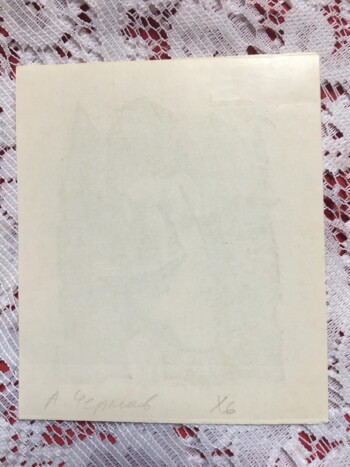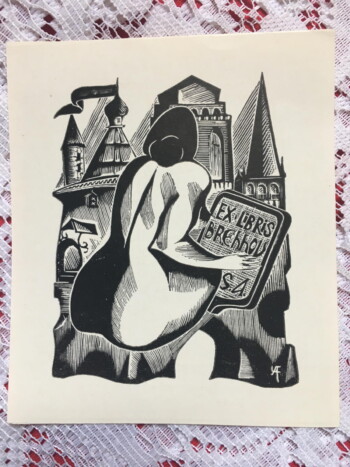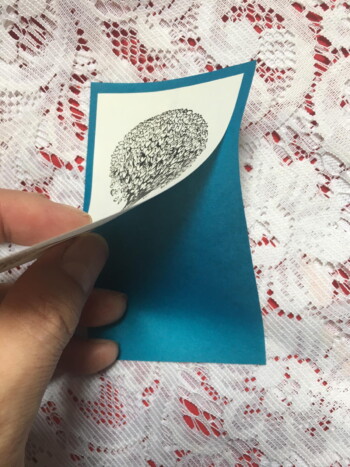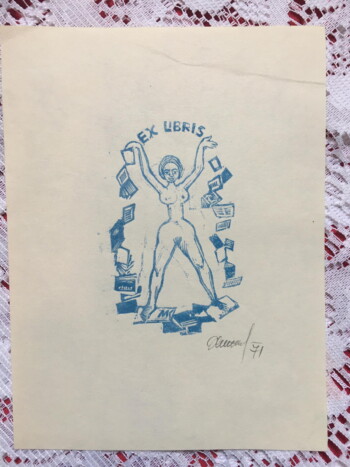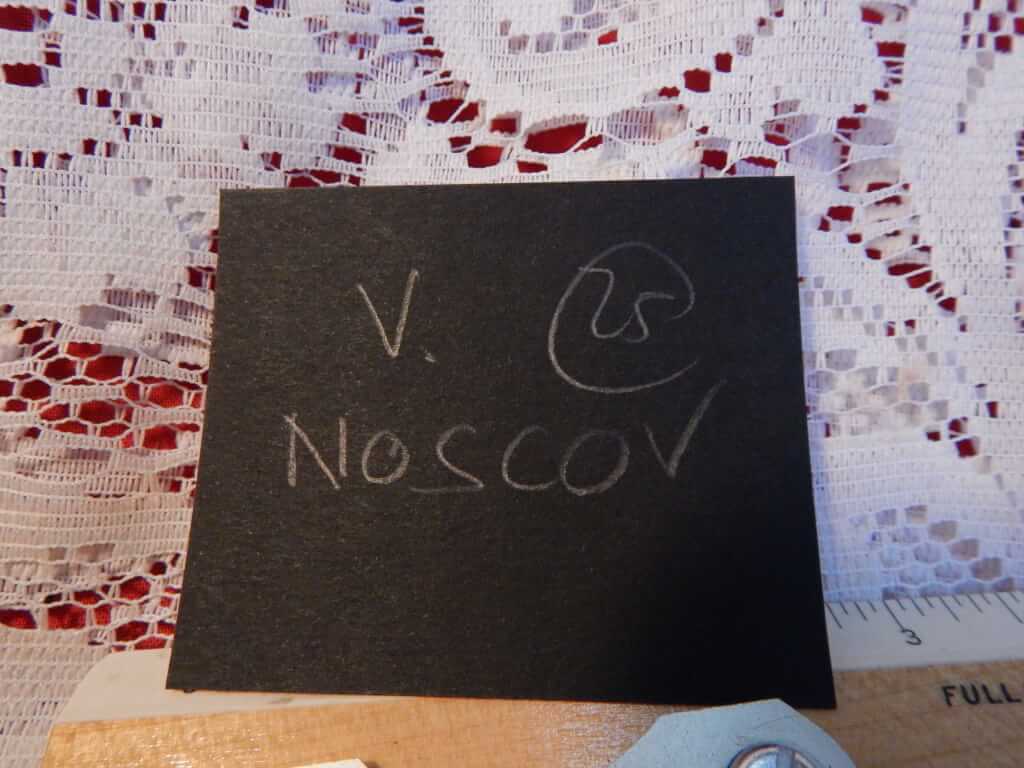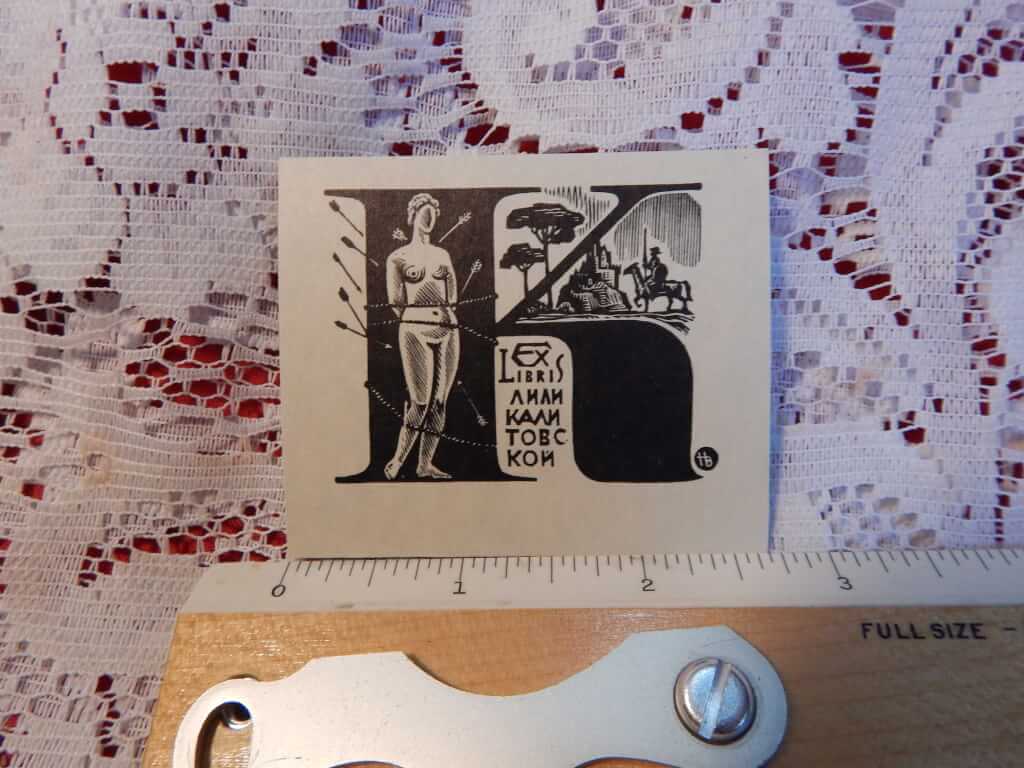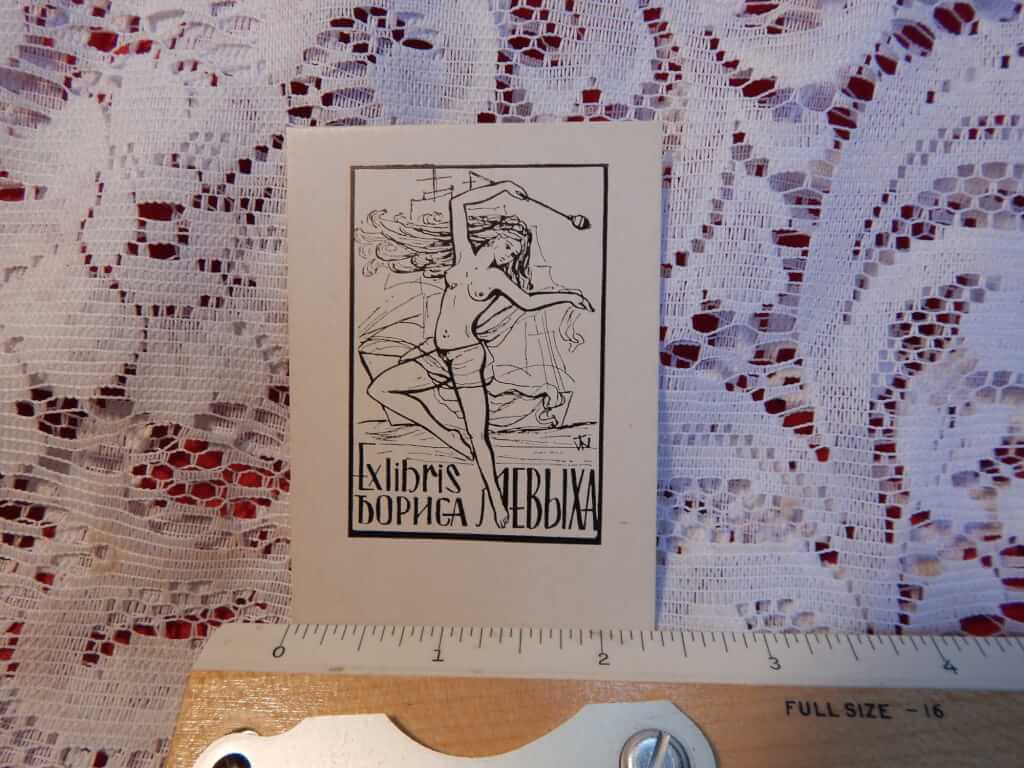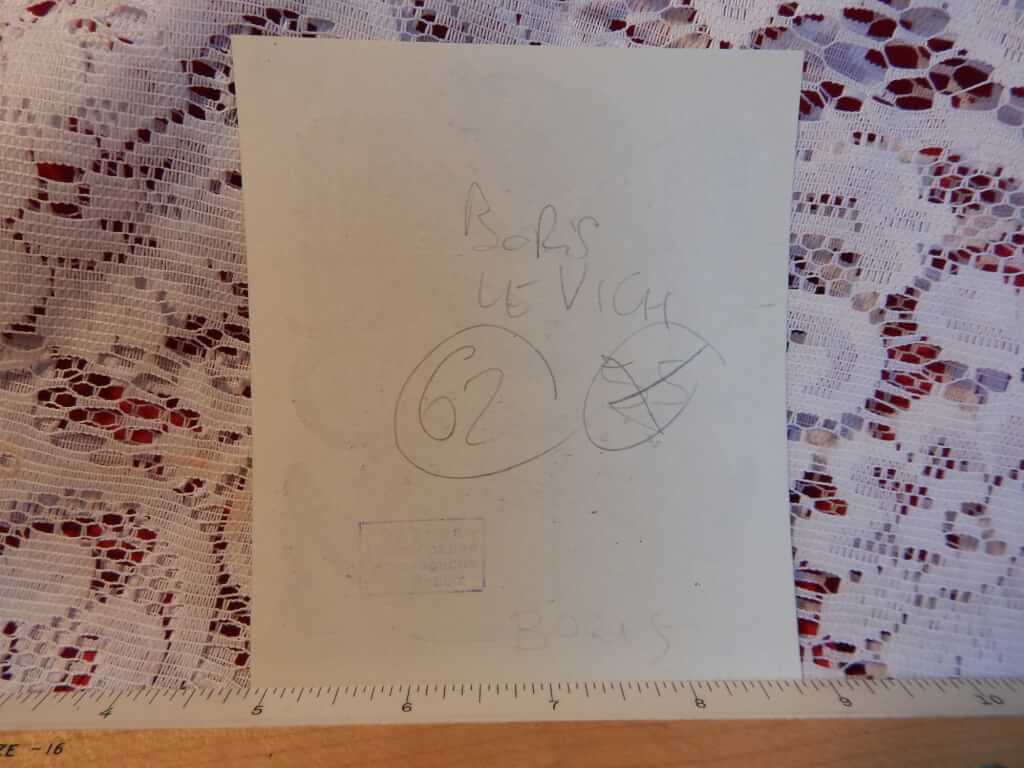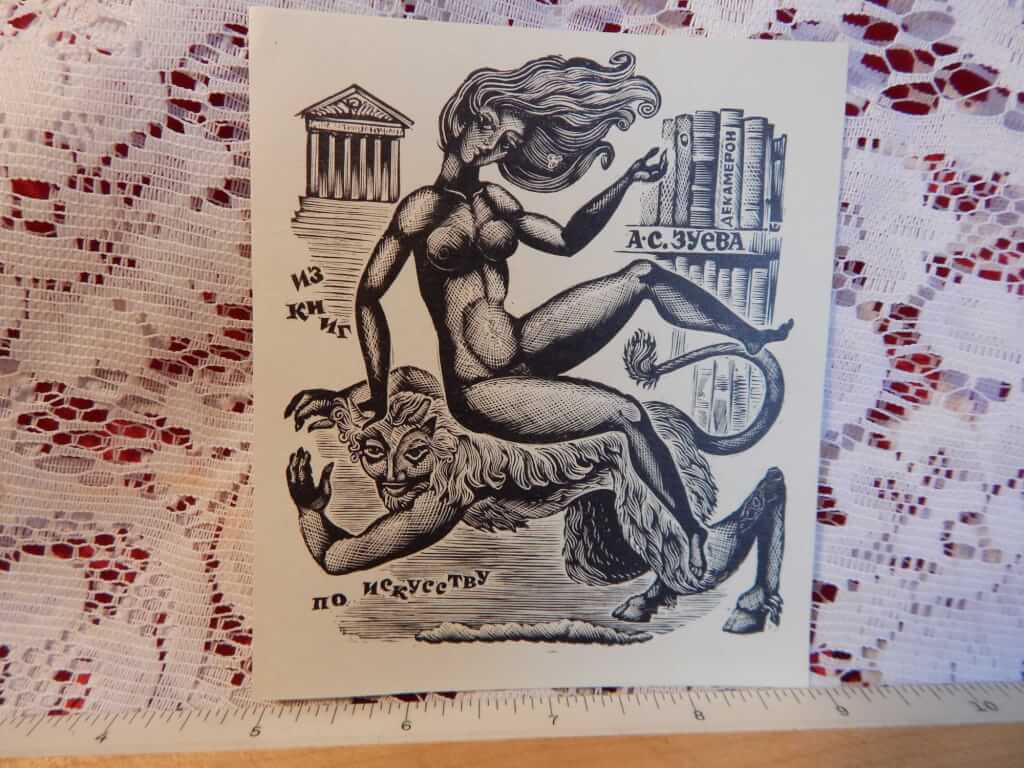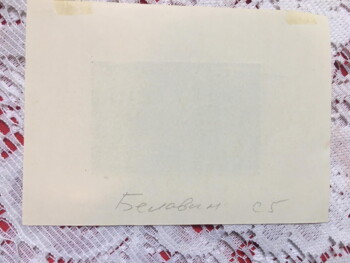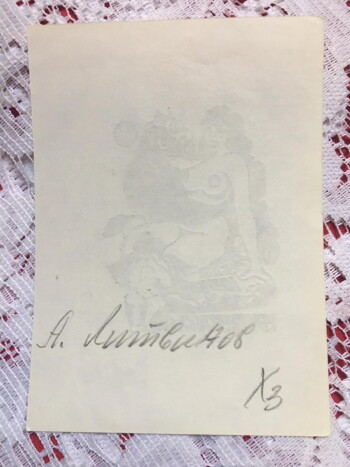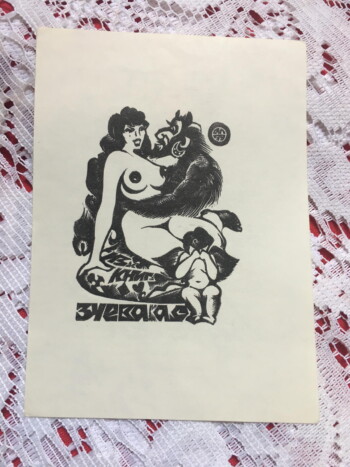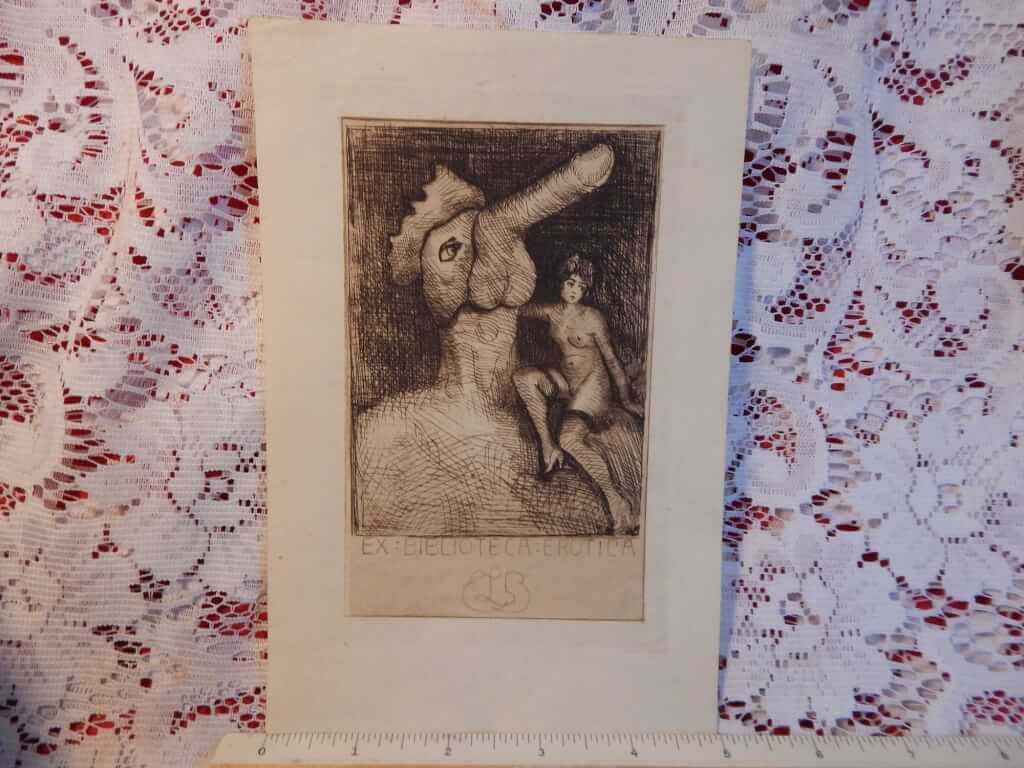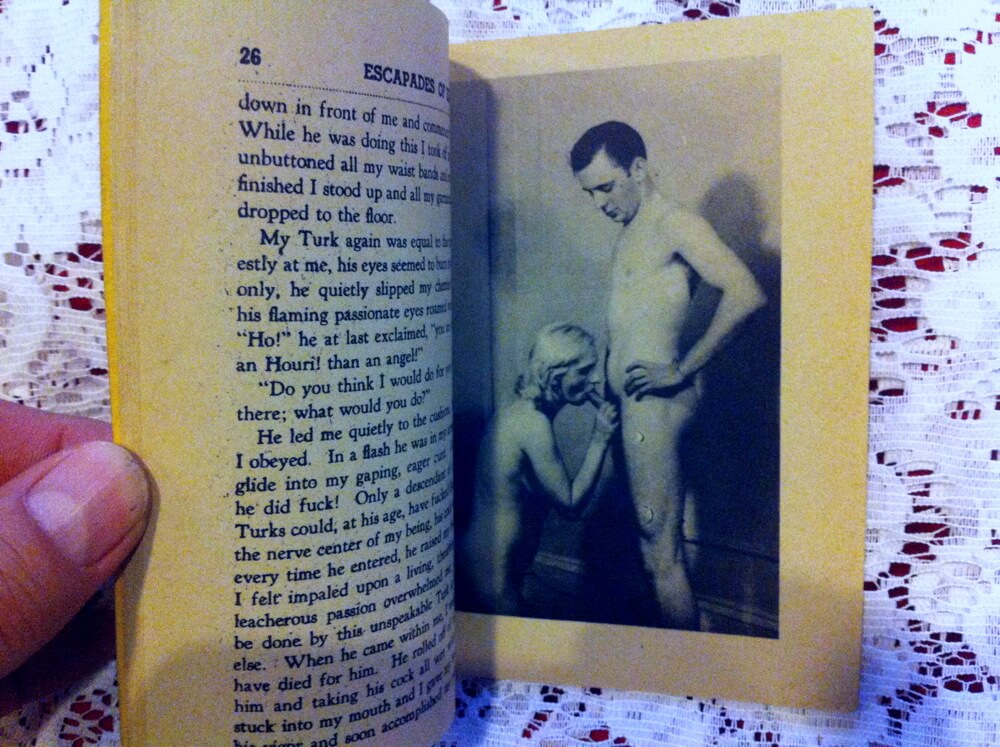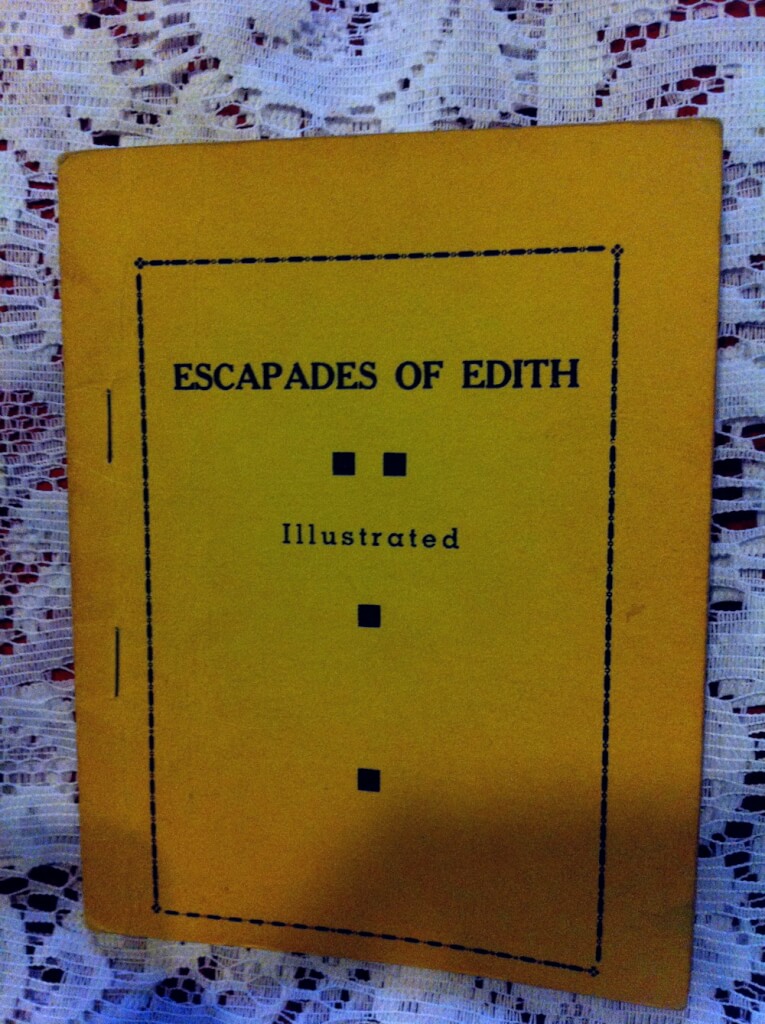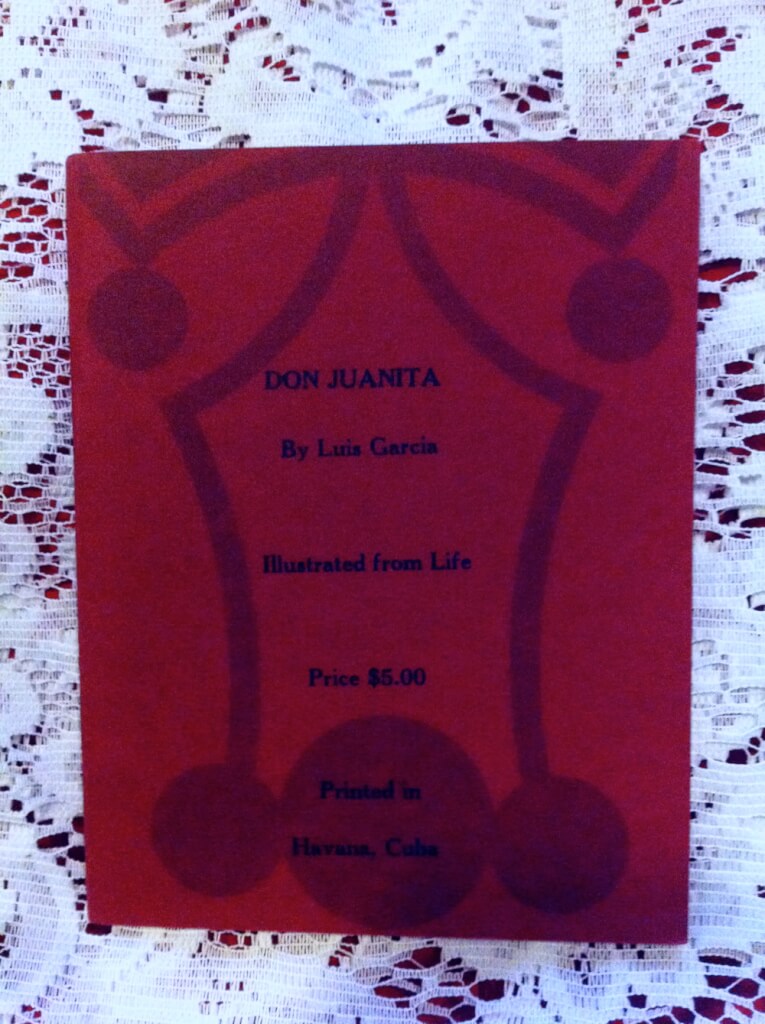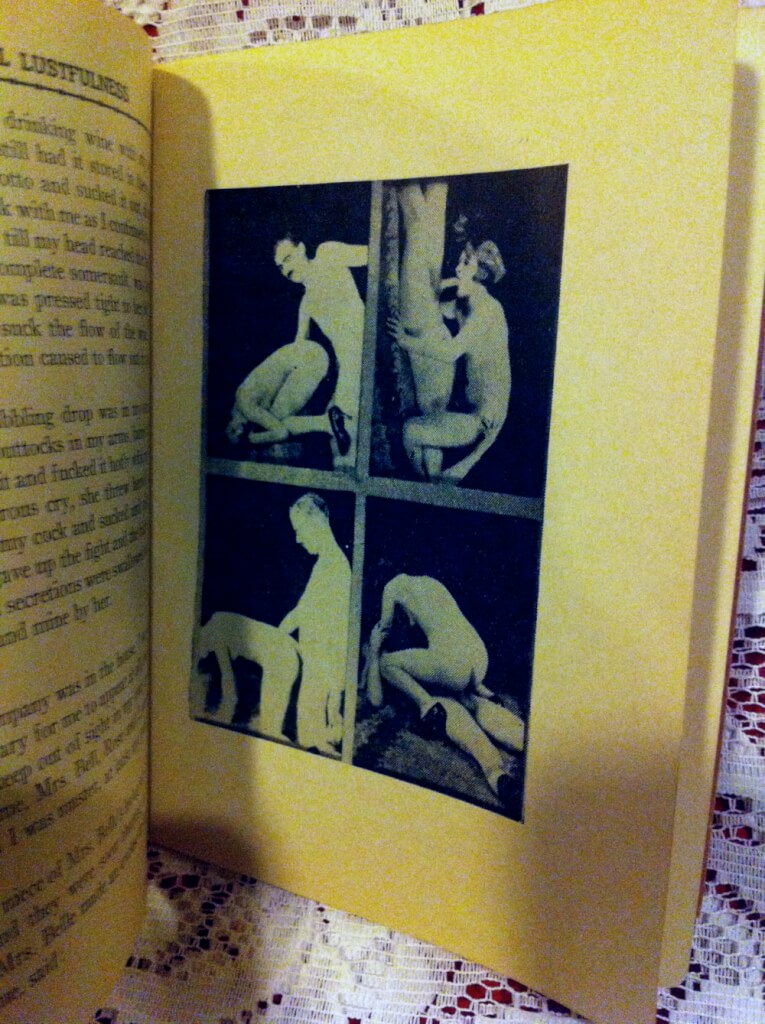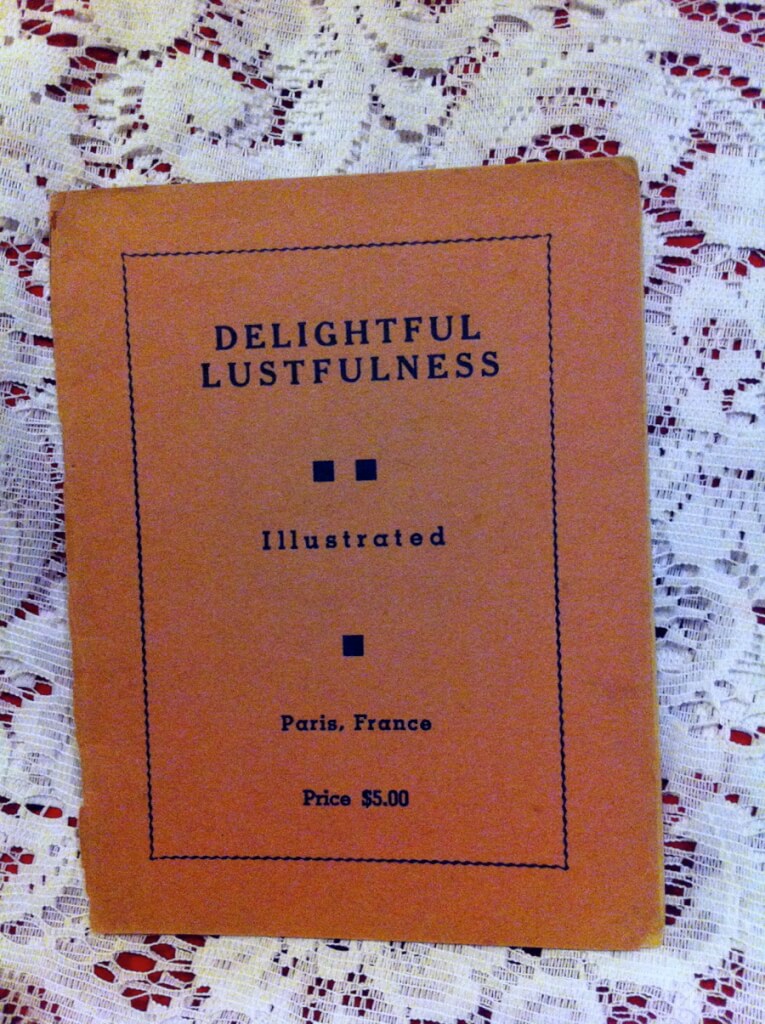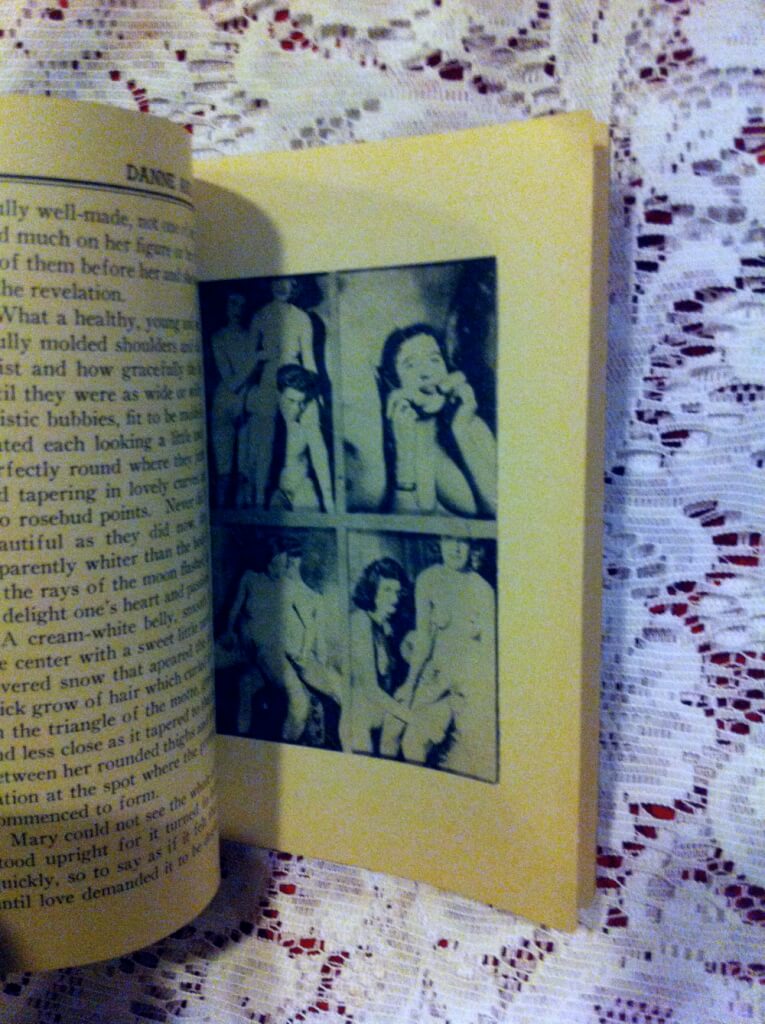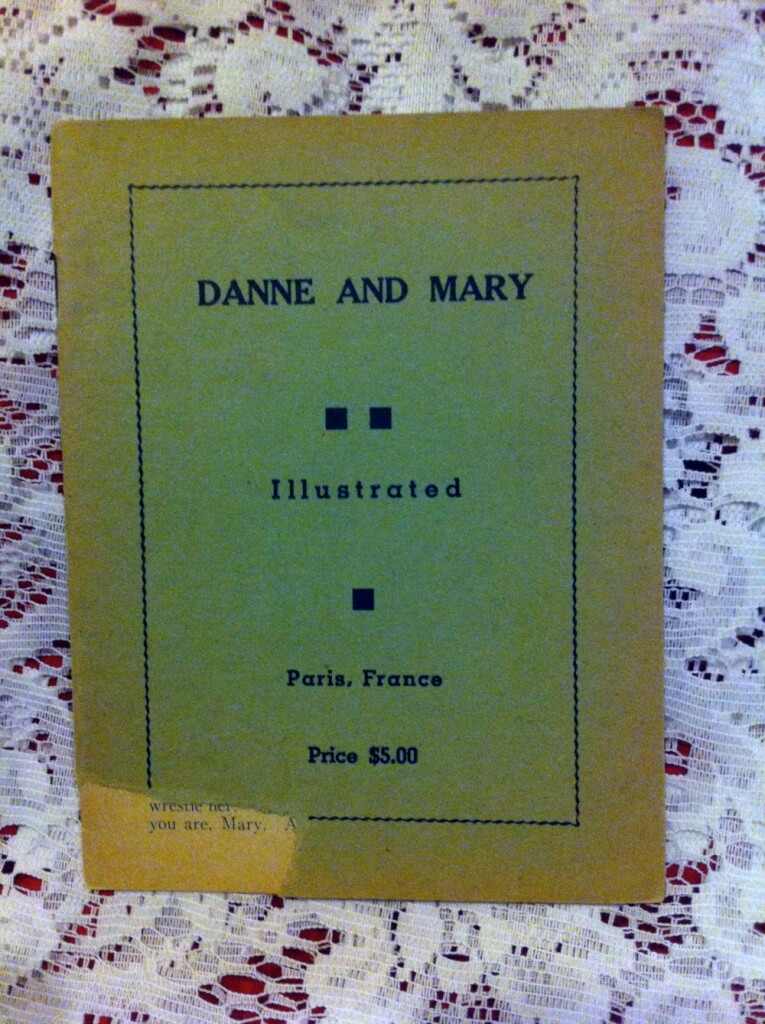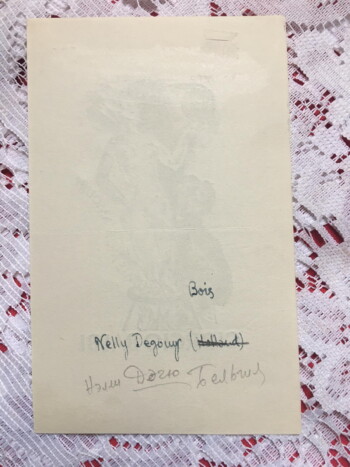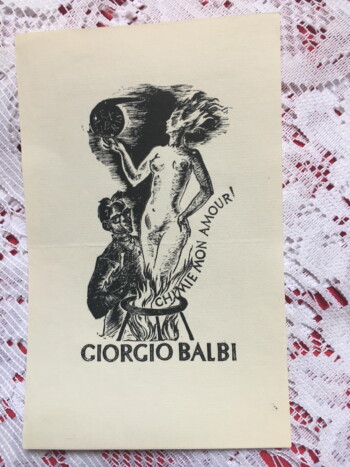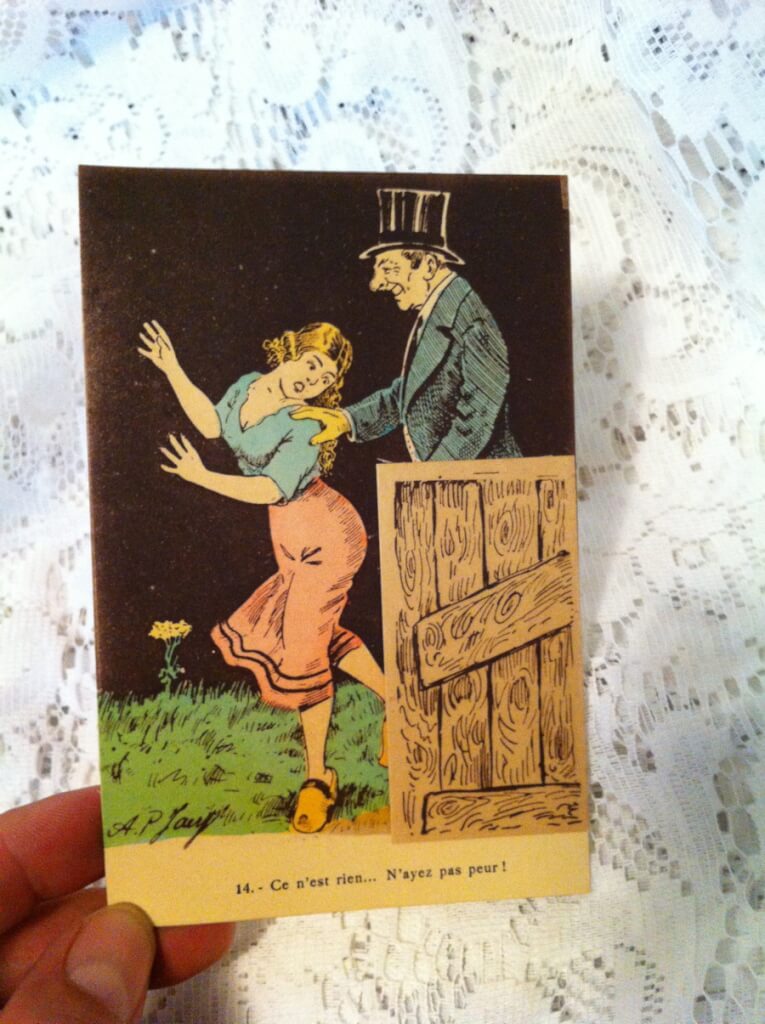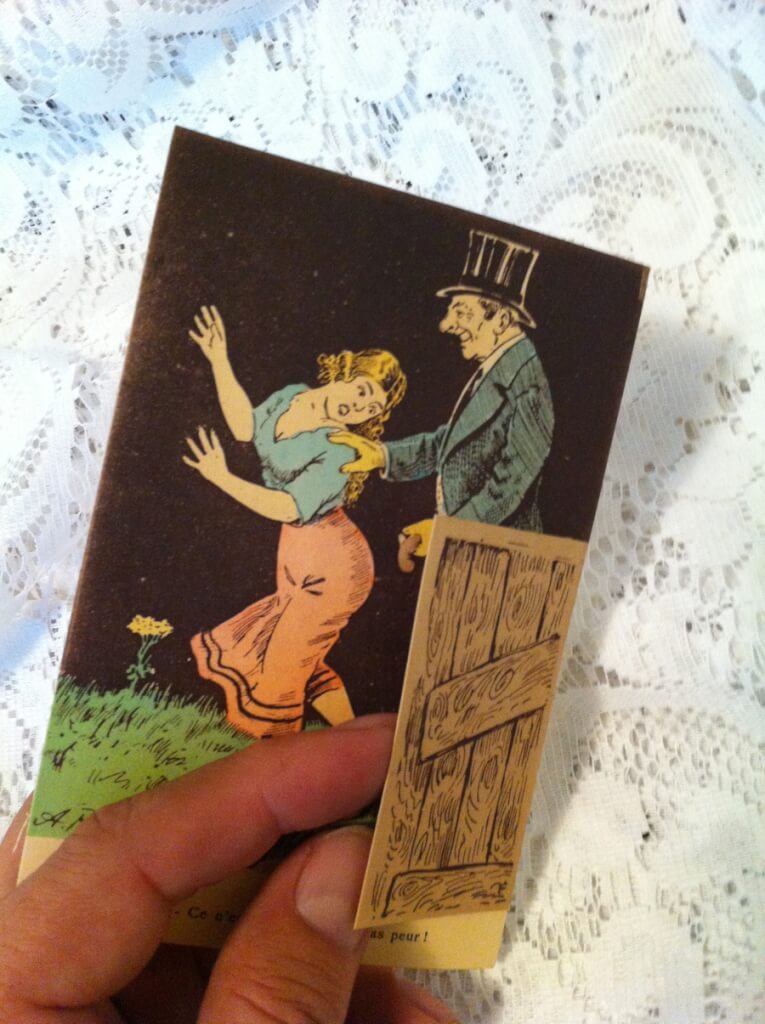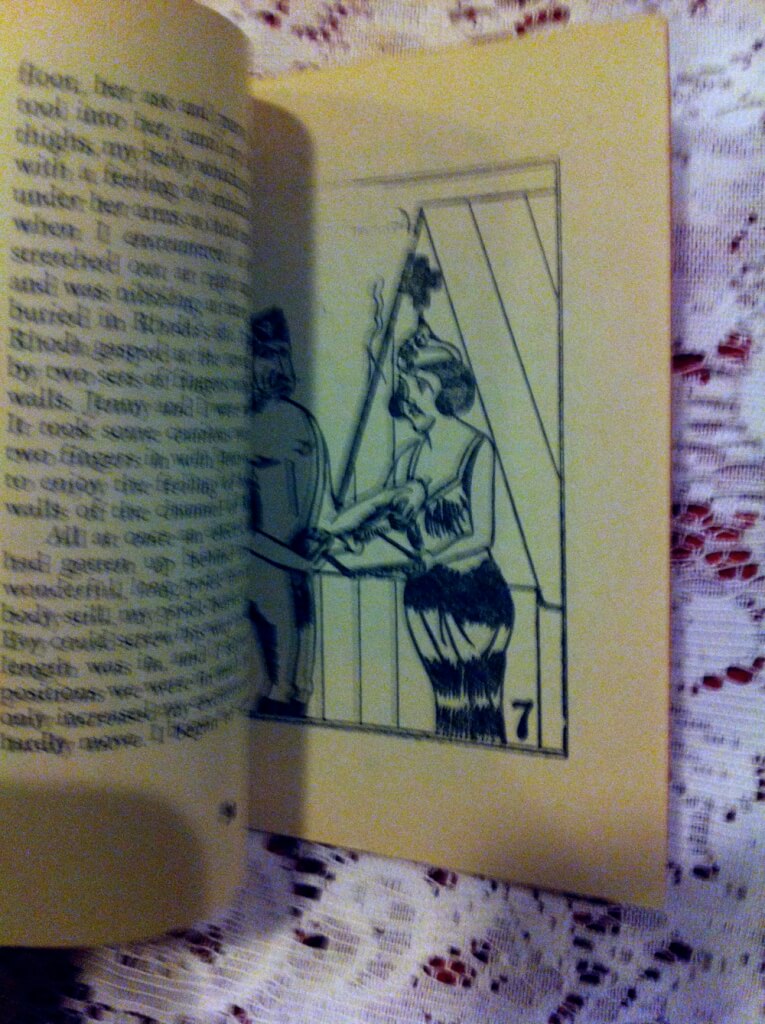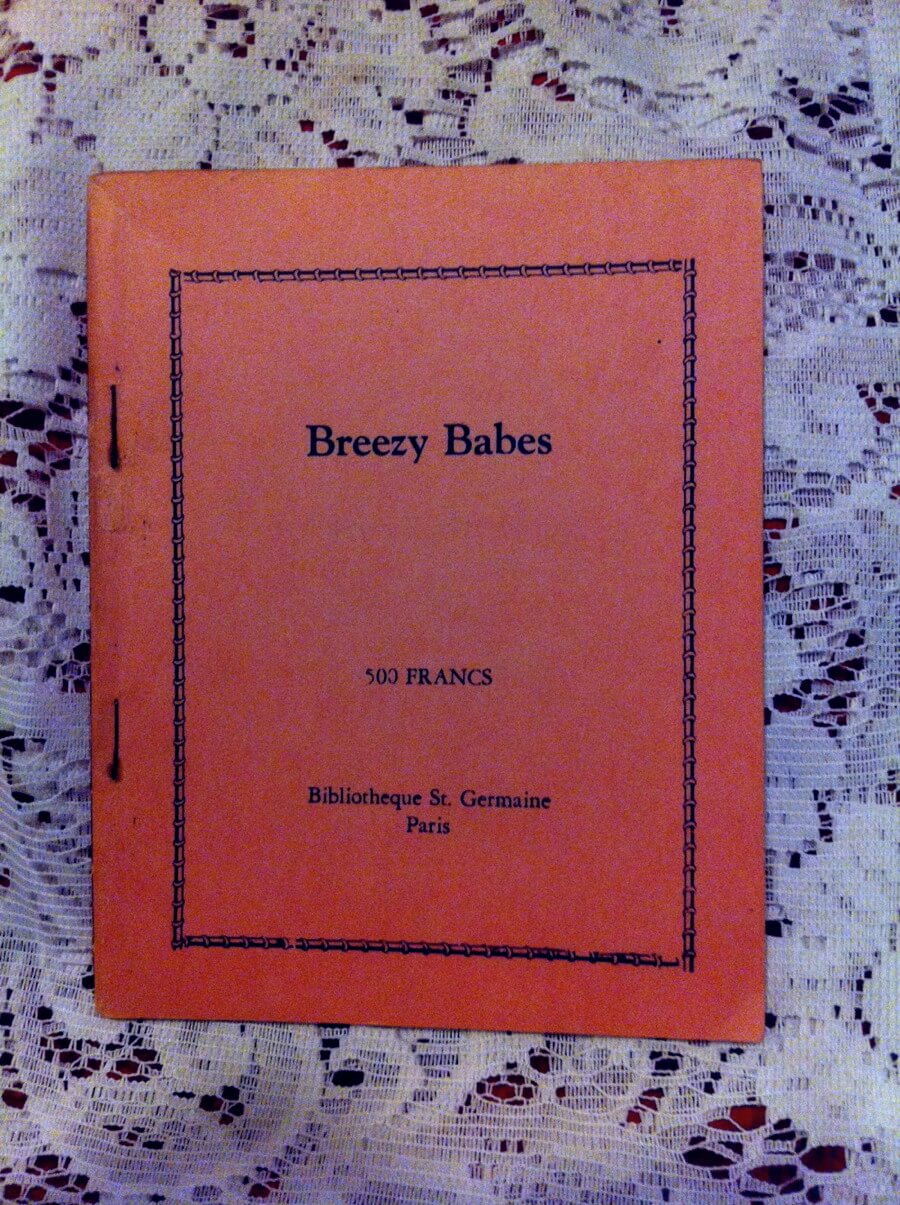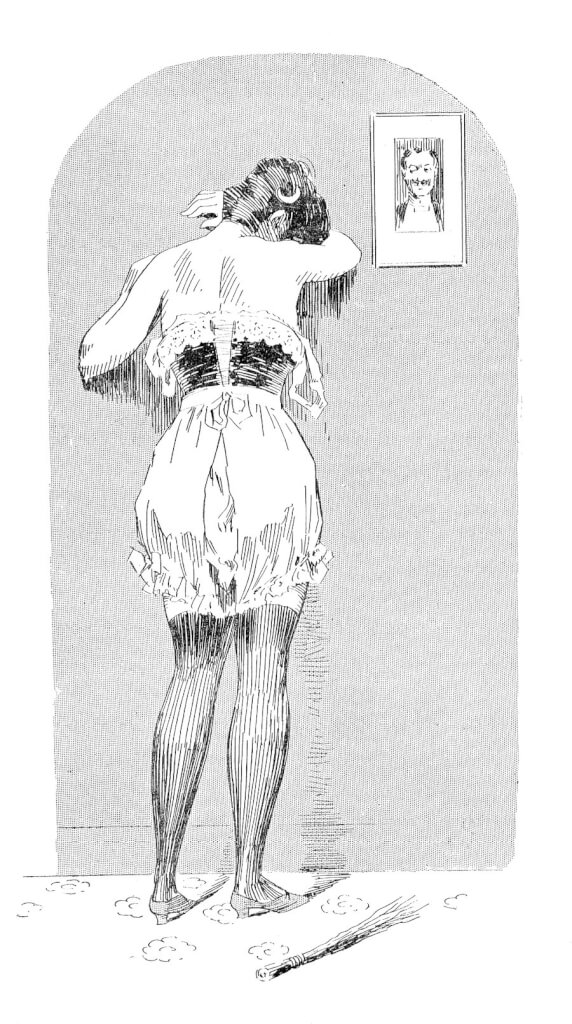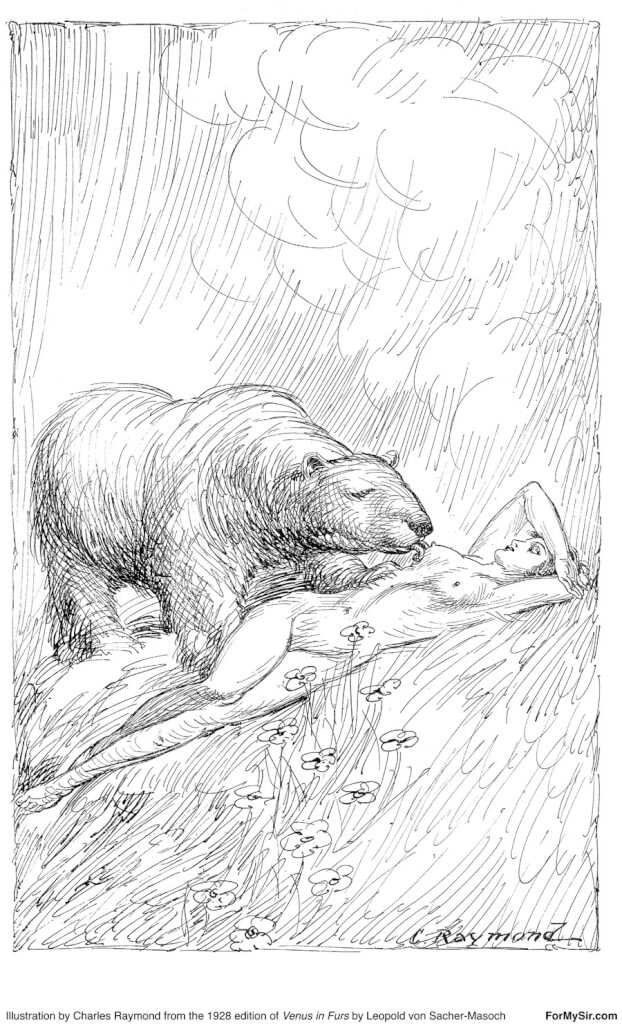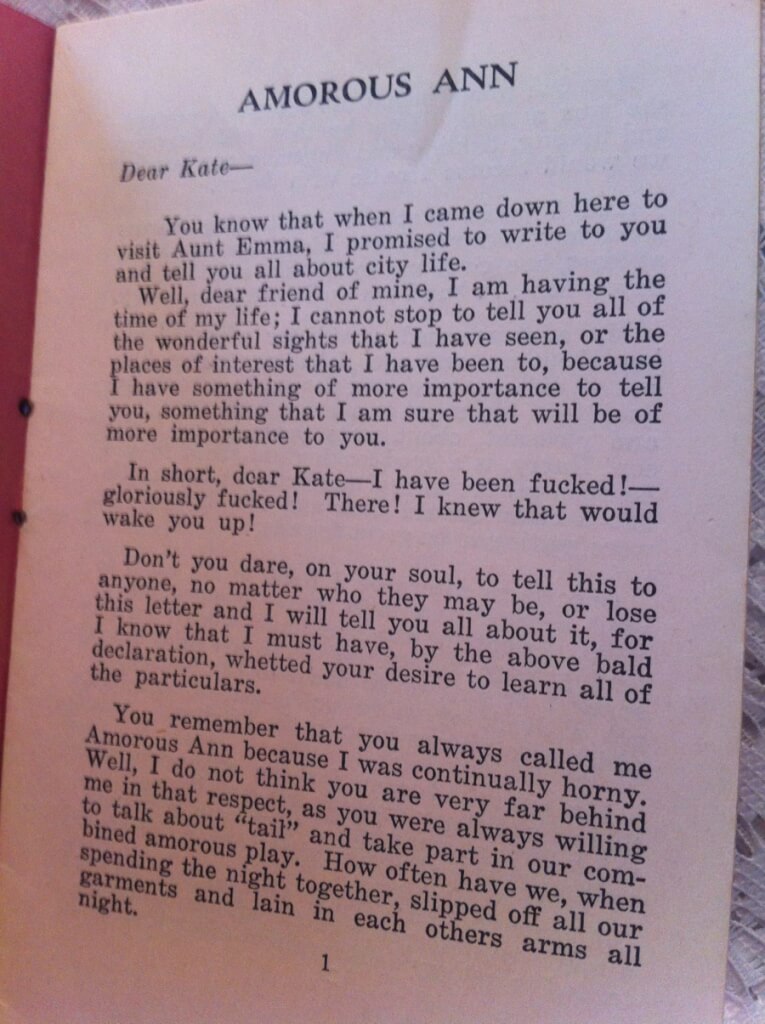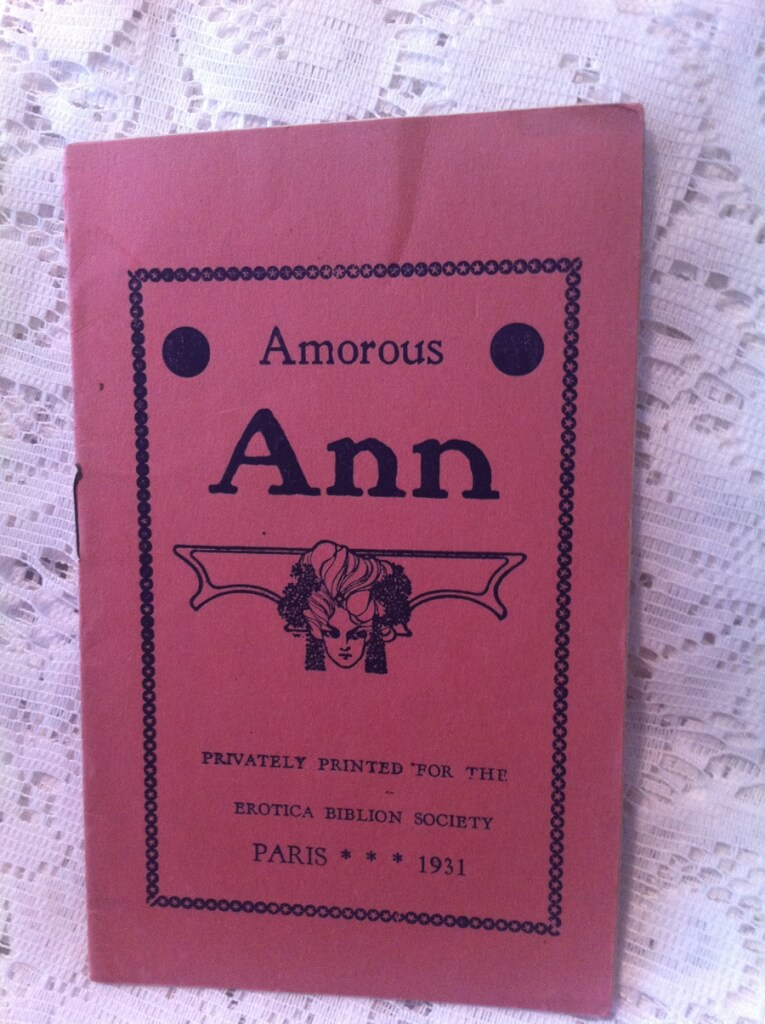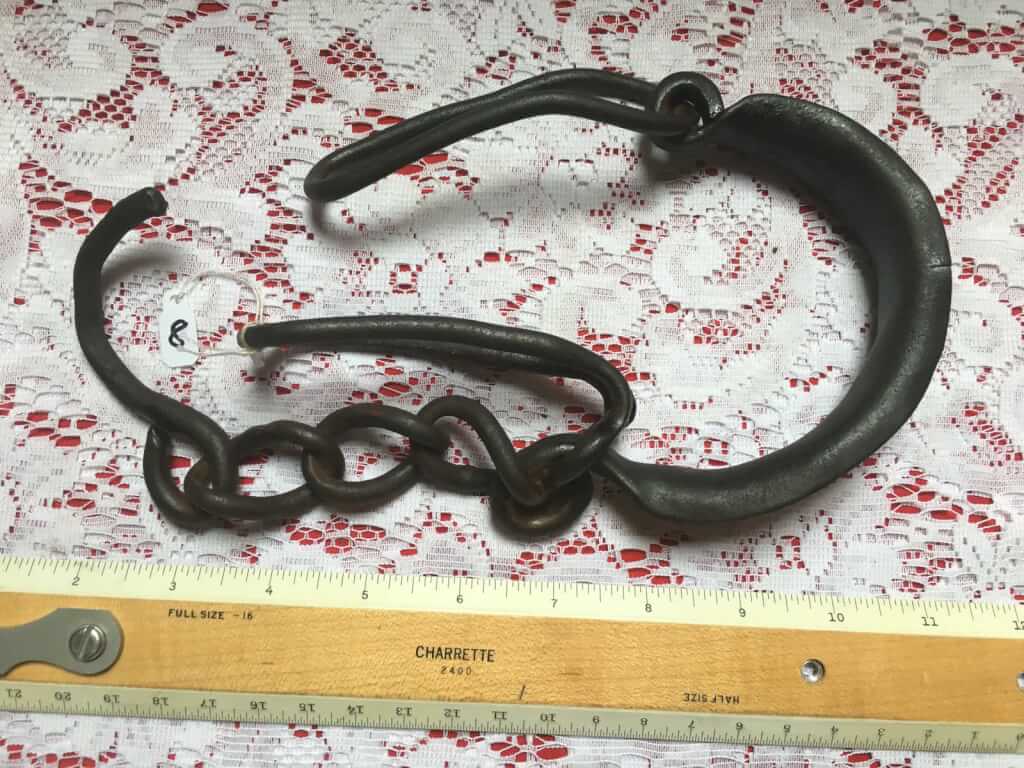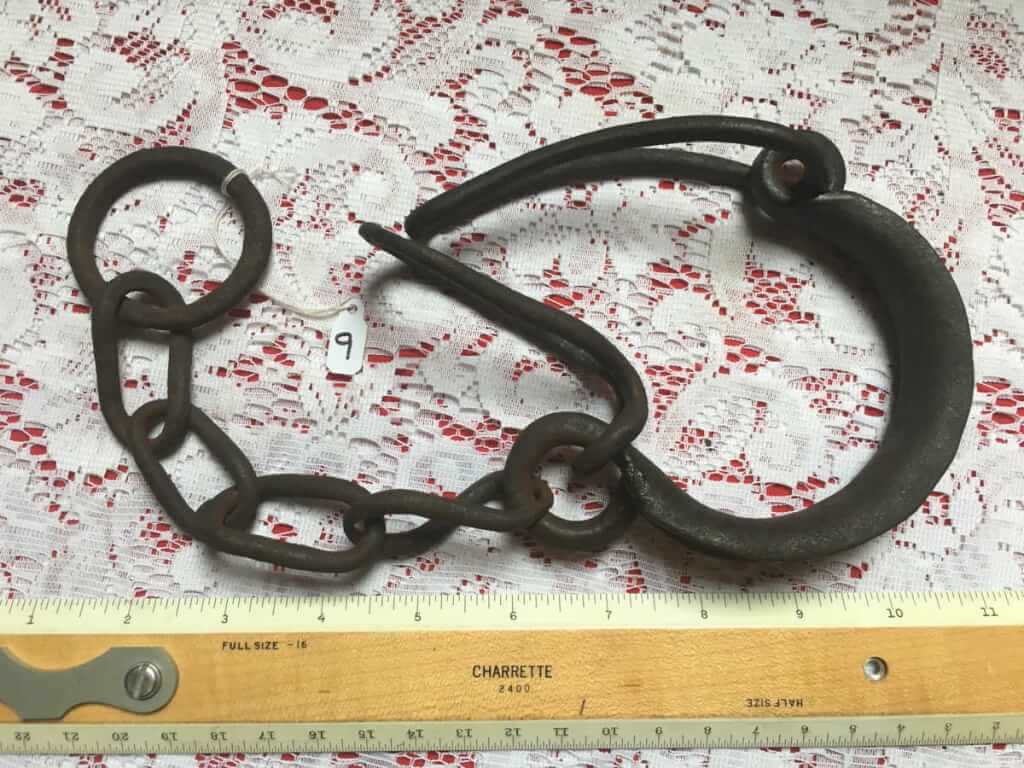-
Out of stock

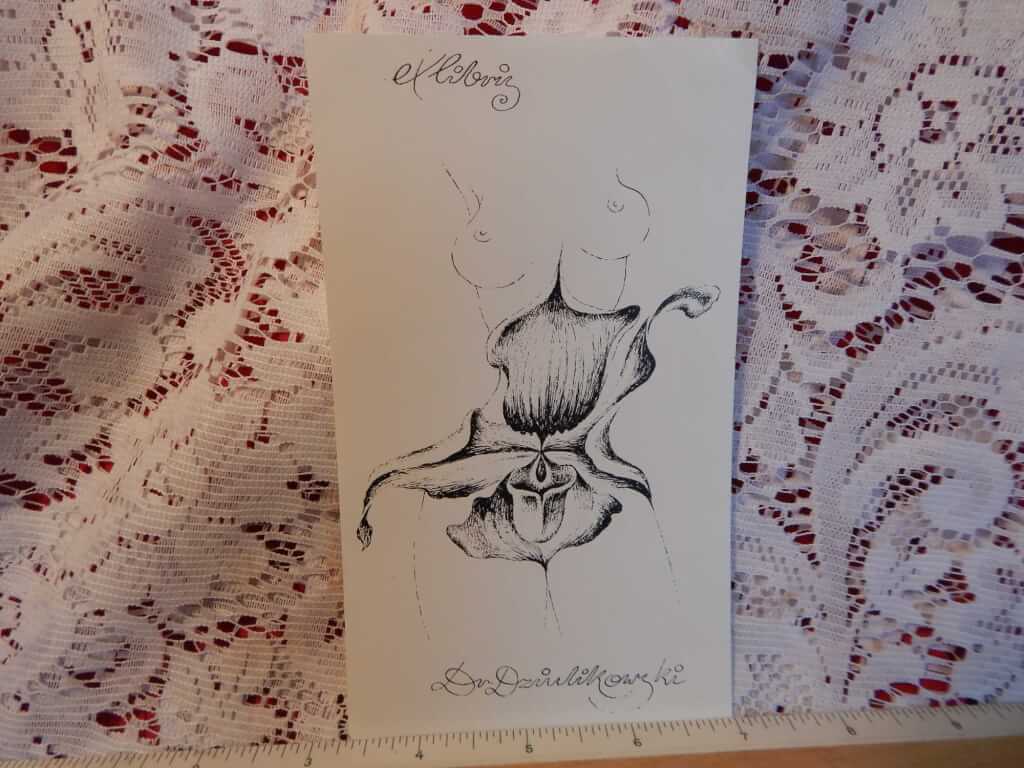 Ex Libris Dr. Dzurilikowsky by Krystyna Wojcik purchased from a collection in Italy, "Krystyna Wojcik" written in pencil on back Naked woman's torso combined with an orchid
Ex Libris Dr. Dzurilikowsky by Krystyna Wojcik purchased from a collection in Italy, "Krystyna Wojcik" written in pencil on back Naked woman's torso combined with an orchid -
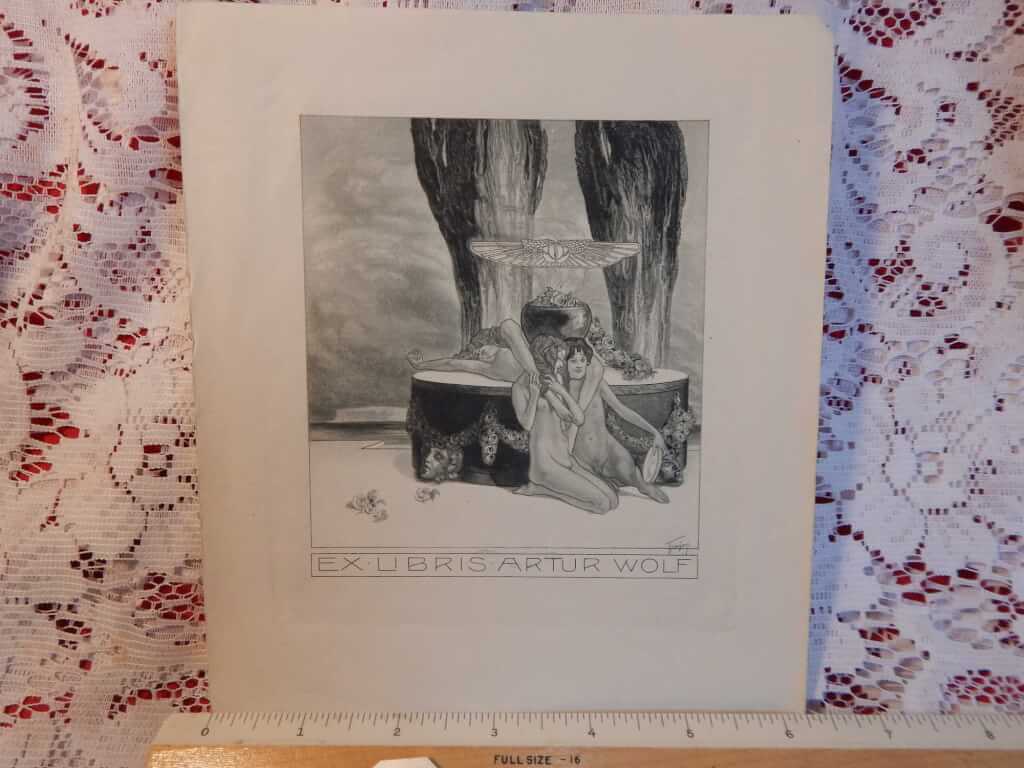 Ex Libris Artur Wolf, by Franz von Bayros paper size 6.25 x 7.25", print size 5 x 5.75", on hand laid paper three naked girls Franz von Bayros (1866 – 1924) was an Austrian commercial artist, illustrator, and painter, now he is best known for his erotic work. He belonged to the Decadent movement in art, often utilizing erotic themes and phantasmagoric imagery. At the age 17, Bayros passed the entrance exam for the Vienna Academy with Eduard von Engerth. Bayros mixed in elegant society and soon belonged to the circle of friends of Johann Straub, whose step daughter Alice he married on 1896. The next year, Bayros moved to Munich. In 1904, Bayros gave his first exhibition in Munich, which was a great success. From 1904 until 1908, Bayros traveled to Paris and Italy for his studies. Typically, for an artist dealing with such imagery, von Bayros produced work under several pseudonyms, most notably Choisy Le Conin, and was hounded by authorities for much of his life for his “indecent” art often very imaginative, and including such taboo subjects as sadomasochism and bestiality. He became equally well-known for his masterly drawn figures of elegant modestly nude and non-nude women.
Ex Libris Artur Wolf, by Franz von Bayros paper size 6.25 x 7.25", print size 5 x 5.75", on hand laid paper three naked girls Franz von Bayros (1866 – 1924) was an Austrian commercial artist, illustrator, and painter, now he is best known for his erotic work. He belonged to the Decadent movement in art, often utilizing erotic themes and phantasmagoric imagery. At the age 17, Bayros passed the entrance exam for the Vienna Academy with Eduard von Engerth. Bayros mixed in elegant society and soon belonged to the circle of friends of Johann Straub, whose step daughter Alice he married on 1896. The next year, Bayros moved to Munich. In 1904, Bayros gave his first exhibition in Munich, which was a great success. From 1904 until 1908, Bayros traveled to Paris and Italy for his studies. Typically, for an artist dealing with such imagery, von Bayros produced work under several pseudonyms, most notably Choisy Le Conin, and was hounded by authorities for much of his life for his “indecent” art often very imaginative, and including such taboo subjects as sadomasochism and bestiality. He became equally well-known for his masterly drawn figures of elegant modestly nude and non-nude women. -
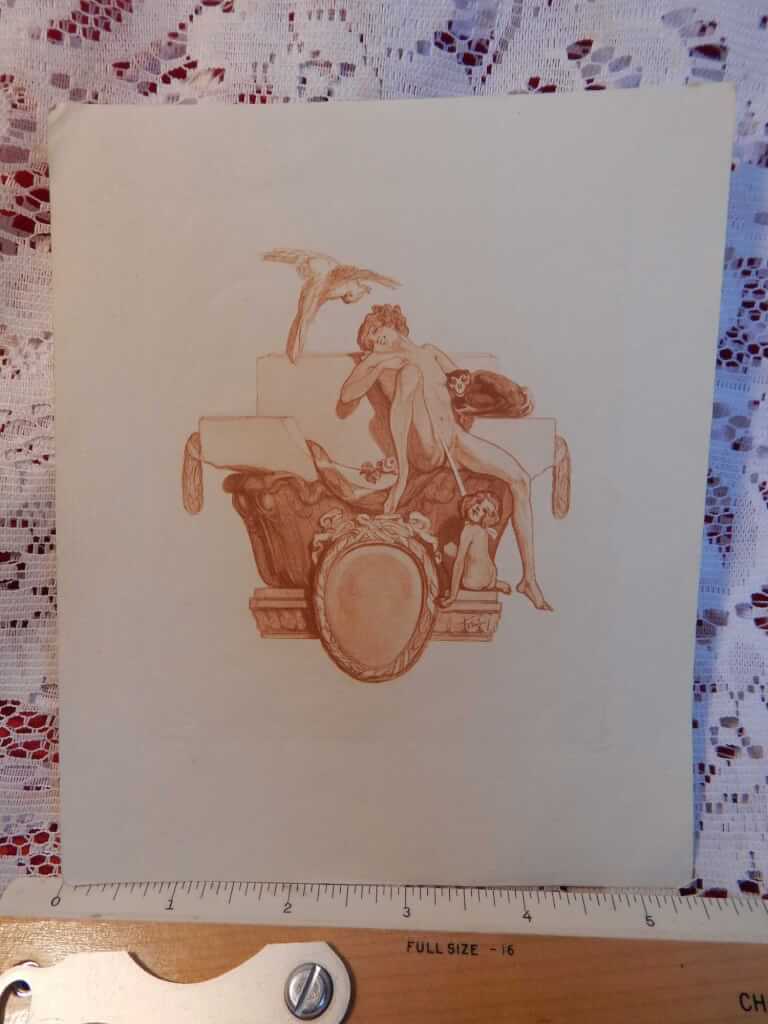 bookplate, by Franz von Bayros paper size 5.5 x 6.5", print size 4 x 4.5", on hand laid paper naked girl, animals, and child Franz von Bayros (1866 – 1924) was an Austrian commercial artist, illustrator, and painter, now he is best known for his erotic work. He belonged to the Decadent movement in art, often utilizing erotic themes and phantasmagoric imagery. At the age 17, Bayros passed the entrance exam for the Vienna Academy with Eduard von Engerth. Bayros mixed in elegant society and soon belonged to the circle of friends of Johann Straub, whose step daughter Alice he married on 1896. The next year, Bayros moved to Munich. In 1904, Bayros gave his first exhibition in Munich, which was a great success. From 1904 until 1908, Bayros traveled to Paris and Italy for his studies. Typically, for an artist dealing with such imagery, von Bayros produced work under several pseudonyms, most notably Choisy Le Conin, and was hounded by authorities for much of his life for his “indecent” art often very imaginative, and including such taboo subjects as sadomasochism and bestiality. He became equally well-known for his masterly drawn figures of elegant modestly nude and non-nude women.
bookplate, by Franz von Bayros paper size 5.5 x 6.5", print size 4 x 4.5", on hand laid paper naked girl, animals, and child Franz von Bayros (1866 – 1924) was an Austrian commercial artist, illustrator, and painter, now he is best known for his erotic work. He belonged to the Decadent movement in art, often utilizing erotic themes and phantasmagoric imagery. At the age 17, Bayros passed the entrance exam for the Vienna Academy with Eduard von Engerth. Bayros mixed in elegant society and soon belonged to the circle of friends of Johann Straub, whose step daughter Alice he married on 1896. The next year, Bayros moved to Munich. In 1904, Bayros gave his first exhibition in Munich, which was a great success. From 1904 until 1908, Bayros traveled to Paris and Italy for his studies. Typically, for an artist dealing with such imagery, von Bayros produced work under several pseudonyms, most notably Choisy Le Conin, and was hounded by authorities for much of his life for his “indecent” art often very imaginative, and including such taboo subjects as sadomasochism and bestiality. He became equally well-known for his masterly drawn figures of elegant modestly nude and non-nude women. -
Out of stock

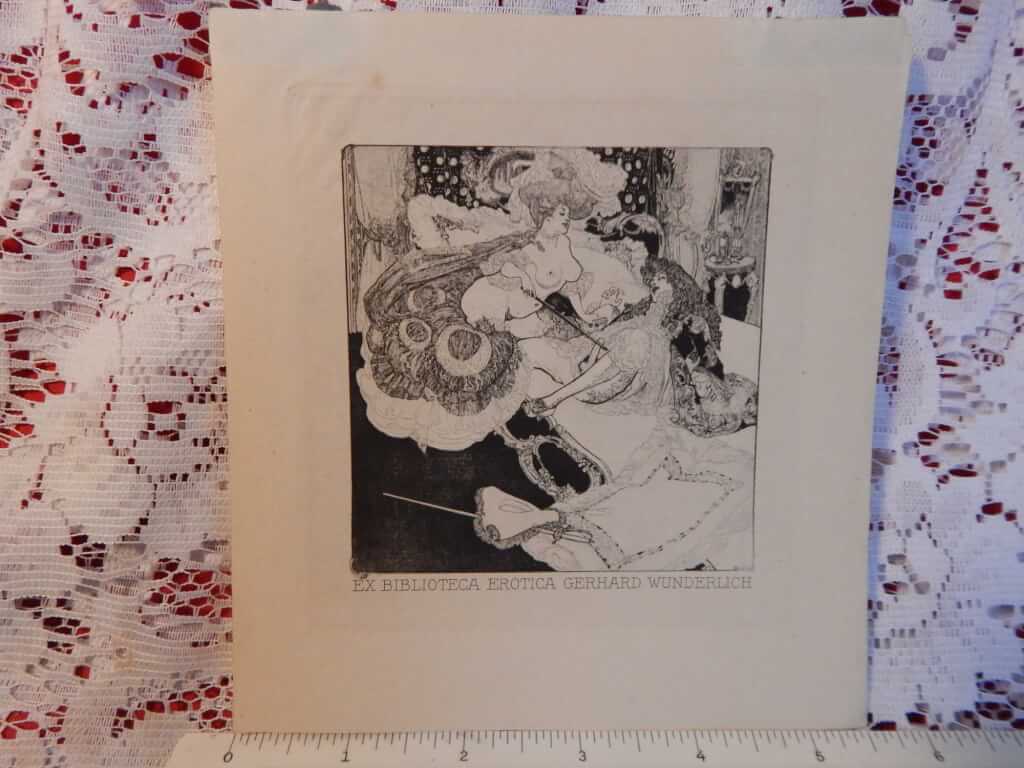 Ex Biblioteca Erotica Gerhard Wunderlich, by Franz von Bayros naked woman with cane, holding it against erect penis, remnants of pastedown at top of back Franz von Bayros (1866 – 1924) was an Austrian commercial artist, illustrator, and painter, now he is best known for his erotic work. He belonged to the Decadent movement in art, often utilizing erotic themes and phantasmagoric imagery. At the age 17, Bayros passed the entrance exam for the Vienna Academy with Eduard von Engerth. Bayros mixed in elegant society and soon belonged to the circle of friends of Johann Straub, whose step daughter Alice he married on 1896. The next year, Bayros moved to Munich. In 1904, Bayros gave his first exhibition in Munich, which was a great success. From 1904 until 1908, Bayros traveled to Paris and Italy for his studies. Typically, for an artist dealing with such imagery, von Bayros produced work under several pseudonyms, most notably Choisy Le Conin, and was hounded by authorities for much of his life for his “indecent” art often very imaginative, and including such taboo subjects as sadomasochism and bestiality. He became equally well-known for his masterly drawn figures of elegant modestly nude and non-nude women.
Ex Biblioteca Erotica Gerhard Wunderlich, by Franz von Bayros naked woman with cane, holding it against erect penis, remnants of pastedown at top of back Franz von Bayros (1866 – 1924) was an Austrian commercial artist, illustrator, and painter, now he is best known for his erotic work. He belonged to the Decadent movement in art, often utilizing erotic themes and phantasmagoric imagery. At the age 17, Bayros passed the entrance exam for the Vienna Academy with Eduard von Engerth. Bayros mixed in elegant society and soon belonged to the circle of friends of Johann Straub, whose step daughter Alice he married on 1896. The next year, Bayros moved to Munich. In 1904, Bayros gave his first exhibition in Munich, which was a great success. From 1904 until 1908, Bayros traveled to Paris and Italy for his studies. Typically, for an artist dealing with such imagery, von Bayros produced work under several pseudonyms, most notably Choisy Le Conin, and was hounded by authorities for much of his life for his “indecent” art often very imaginative, and including such taboo subjects as sadomasochism and bestiality. He became equally well-known for his masterly drawn figures of elegant modestly nude and non-nude women. -
 Ex Biblioteca Erotica Artur Wolf, by Franz von Bayros paper size 5.5 x 6.25", print size 3.5 x 4" topless women with large hat and a crop under her right arm, walking(?) a large penis Franz von Bayros (1866 – 1924) was an Austrian commercial artist, illustrator, and painter, now he is best known for his erotic work. He belonged to the Decadent movement in art, often utilizing erotic themes and phantasmagoric imagery. At the age 17, Bayros passed the entrance exam for the Vienna Academy with Eduard von Engerth. Bayros mixed in elegant society and soon belonged to the circle of friends of Johann Straub, whose step daughter Alice he married on 1896. The next year, Bayros moved to Munich. In 1904, Bayros gave his first exhibition in Munich, which was a great success. From 1904 until 1908, Bayros traveled to Paris and Italy for his studies. Typically, for an artist dealing with such imagery, von Bayros produced work under several pseudonyms, most notably Choisy Le Conin, and was hounded by authorities for much of his life for his “indecent” art often very imaginative, and including such taboo subjects as sadomasochism and bestiality. He became equally well-known for his masterly drawn figures of elegant modestly nude and non-nude women.
Ex Biblioteca Erotica Artur Wolf, by Franz von Bayros paper size 5.5 x 6.25", print size 3.5 x 4" topless women with large hat and a crop under her right arm, walking(?) a large penis Franz von Bayros (1866 – 1924) was an Austrian commercial artist, illustrator, and painter, now he is best known for his erotic work. He belonged to the Decadent movement in art, often utilizing erotic themes and phantasmagoric imagery. At the age 17, Bayros passed the entrance exam for the Vienna Academy with Eduard von Engerth. Bayros mixed in elegant society and soon belonged to the circle of friends of Johann Straub, whose step daughter Alice he married on 1896. The next year, Bayros moved to Munich. In 1904, Bayros gave his first exhibition in Munich, which was a great success. From 1904 until 1908, Bayros traveled to Paris and Italy for his studies. Typically, for an artist dealing with such imagery, von Bayros produced work under several pseudonyms, most notably Choisy Le Conin, and was hounded by authorities for much of his life for his “indecent” art often very imaginative, and including such taboo subjects as sadomasochism and bestiality. He became equally well-known for his masterly drawn figures of elegant modestly nude and non-nude women. -

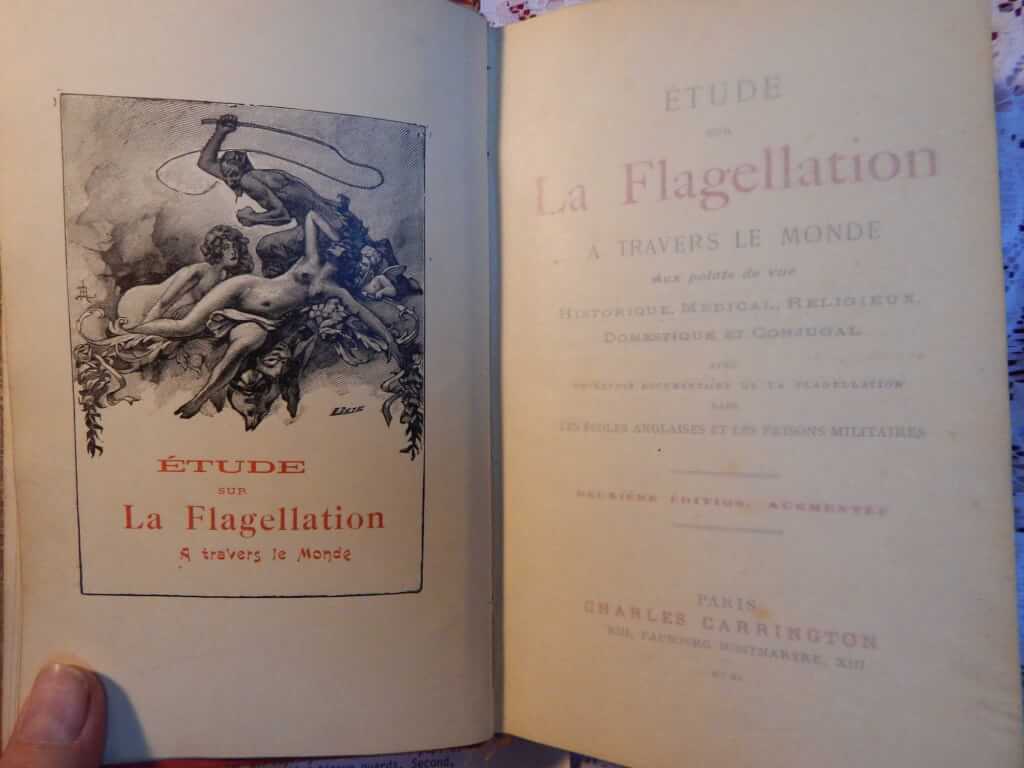 Étude sur La Flagellation a travers le monde aux points de vue Historique, Medical, Religieux, Domestique et Conjugal | avec un exposé documentaire de la flagellation dans Les écoles anglaises et les prisons militaires, Deuxiéme Édition, Augmentée [Study of the Flagellation throughout the world from the historical, medical, religious, domestic and marital points of view | with a documentary presentation of flogging in English Schools and Military Prisons, Second Edition, Augmented], by Jean de Villiot [pseud. most likely of Charles Carrington, Hugues Rebell and Hector France],illust. by René Lelong, (Charles Carrington, Paris, 1901, "Second Edition Augmented", printed by Achevé d'imprimer le 29 septembre 1900 par Em. Pivoteau. Imprimeur à Saint-Amand-Mont-Rond (Cher)) 5.5"x8.5", xxiv+646pp, quarter-bound in red morocco over red boards, 4 raised bands, gilt titles and decorations on spine, marbled paste-downs, all edges gilt, ribbon intact, binding frayed a bit at bottom, some rubbing and stains, otherwise very good condition for age, frontispiece and 20 B&W illustrations by René Lelong tipped in with titled tissue guards. This book is the compilation and expansion of a few other books previously published by Charles Carrington including the original Étude sur La Flagellation a travers le monde published in 1898. It represents a more complete representation of those writings beautifully bound into one book, covering studies on flogging through the centuries, flogging in England, flogging in the history of France (the cases of Madame Du Barry, the Marquise de Rosen.), the flogging from the medical point of view where one learns its healing properties, flogging in literature or the art of using it for pleasure, the discipline to school and domestic and spousal corrections, and "in our current society". Jean de Villiot is a pseudonym frequently used by Carrington and the various authors he relied upon, especially for works that involved flagellation. The illustrator, René Lelong was a third class medalist at the Salon des artistes français of 1895 which he became a member from 1898. He has produced advertising posters and illustrated numerous books and texts. He was a professor at the Julian Academy from 1879 to 1891.
Étude sur La Flagellation a travers le monde aux points de vue Historique, Medical, Religieux, Domestique et Conjugal | avec un exposé documentaire de la flagellation dans Les écoles anglaises et les prisons militaires, Deuxiéme Édition, Augmentée [Study of the Flagellation throughout the world from the historical, medical, religious, domestic and marital points of view | with a documentary presentation of flogging in English Schools and Military Prisons, Second Edition, Augmented], by Jean de Villiot [pseud. most likely of Charles Carrington, Hugues Rebell and Hector France],illust. by René Lelong, (Charles Carrington, Paris, 1901, "Second Edition Augmented", printed by Achevé d'imprimer le 29 septembre 1900 par Em. Pivoteau. Imprimeur à Saint-Amand-Mont-Rond (Cher)) 5.5"x8.5", xxiv+646pp, quarter-bound in red morocco over red boards, 4 raised bands, gilt titles and decorations on spine, marbled paste-downs, all edges gilt, ribbon intact, binding frayed a bit at bottom, some rubbing and stains, otherwise very good condition for age, frontispiece and 20 B&W illustrations by René Lelong tipped in with titled tissue guards. This book is the compilation and expansion of a few other books previously published by Charles Carrington including the original Étude sur La Flagellation a travers le monde published in 1898. It represents a more complete representation of those writings beautifully bound into one book, covering studies on flogging through the centuries, flogging in England, flogging in the history of France (the cases of Madame Du Barry, the Marquise de Rosen.), the flogging from the medical point of view where one learns its healing properties, flogging in literature or the art of using it for pleasure, the discipline to school and domestic and spousal corrections, and "in our current society". Jean de Villiot is a pseudonym frequently used by Carrington and the various authors he relied upon, especially for works that involved flagellation. The illustrator, René Lelong was a third class medalist at the Salon des artistes français of 1895 which he became a member from 1898. He has produced advertising posters and illustrated numerous books and texts. He was a professor at the Julian Academy from 1879 to 1891. -
 Etude Sur La Bestialite Au Point de Vue Historique, Medical et Juridique, G. Dubois-Desaulle (Charles Carrington, Paris, 1905, #437/500, printed Felix Guy et Cie, Aleçon) 10"x7.25", 2 volumes, xii+443pp, Holland paper , modern binding half-calf over red boards, gilt title and decorations on spine, original paper covers bound inside, fore and bottom edges deckled, some pages uncut, very good condition for age, clean. Study of bestiality from the historical, medical and legal point of view. A very nice copy of a VERY rare book.
Etude Sur La Bestialite Au Point de Vue Historique, Medical et Juridique, G. Dubois-Desaulle (Charles Carrington, Paris, 1905, #437/500, printed Felix Guy et Cie, Aleçon) 10"x7.25", 2 volumes, xii+443pp, Holland paper , modern binding half-calf over red boards, gilt title and decorations on spine, original paper covers bound inside, fore and bottom edges deckled, some pages uncut, very good condition for age, clean. Study of bestiality from the historical, medical and legal point of view. A very nice copy of a VERY rare book. -
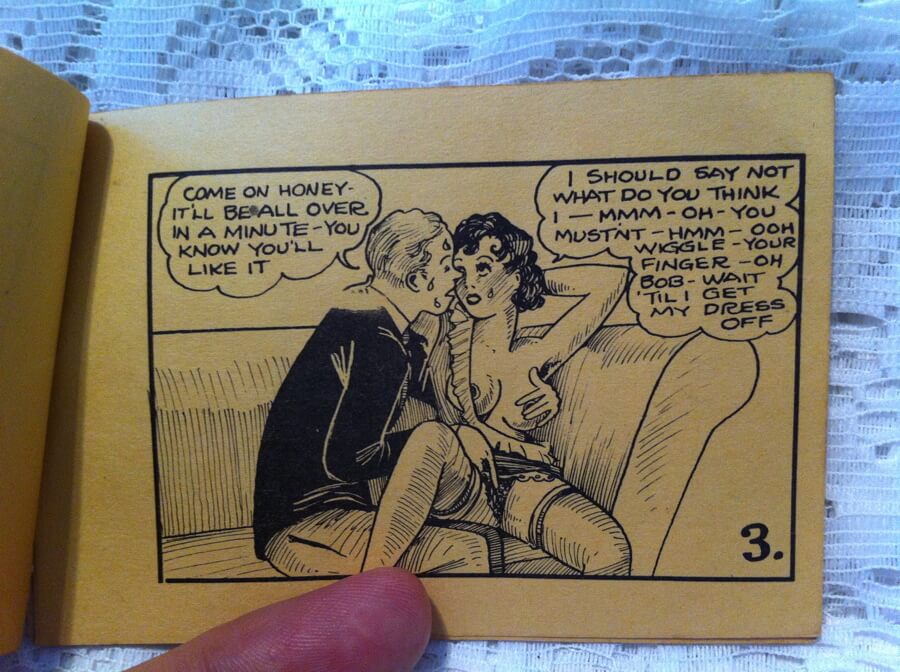
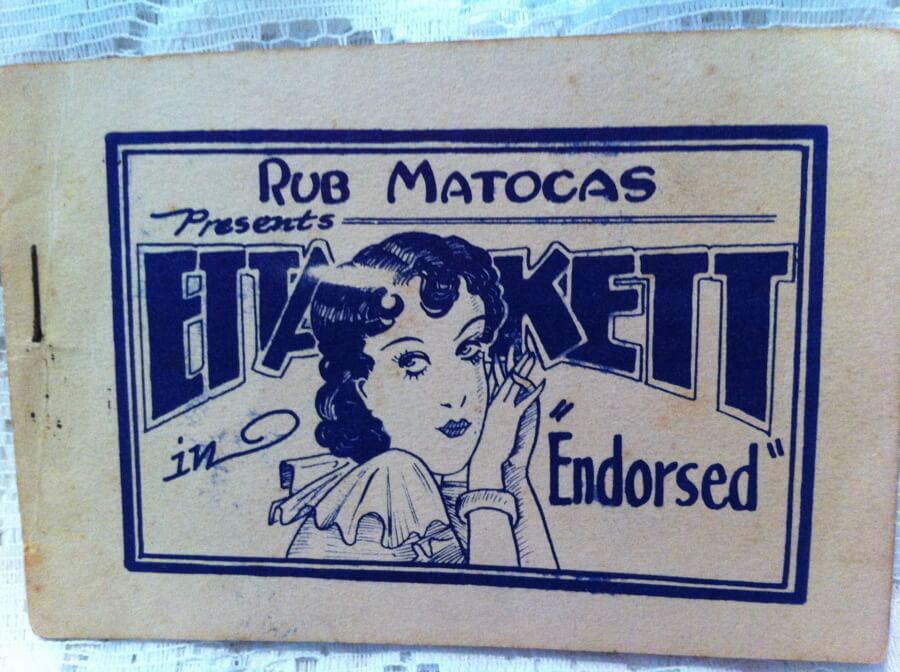 Rub Matocas Presents Etta Kett in "Endorsed", (n.p. n.d.) 4.5" x 3", 8pp. pamphlet, stapled Tijuana bibles (also known as eight-pagers, bluesies, gray-backs, Jiggs-and-Maggie books, jo-jo books, Tillie-and-Mac books, and two-by-fours) were little pornographic comic books produced in the United States from the 1920s to the early 1960s. Etta Kett was a long-run comic strip launched in December 1925, it originally offered tips to teenagers on manners, etiquette and the social graces.
Rub Matocas Presents Etta Kett in "Endorsed", (n.p. n.d.) 4.5" x 3", 8pp. pamphlet, stapled Tijuana bibles (also known as eight-pagers, bluesies, gray-backs, Jiggs-and-Maggie books, jo-jo books, Tillie-and-Mac books, and two-by-fours) were little pornographic comic books produced in the United States from the 1920s to the early 1960s. Etta Kett was a long-run comic strip launched in December 1925, it originally offered tips to teenagers on manners, etiquette and the social graces. -
Out of stock
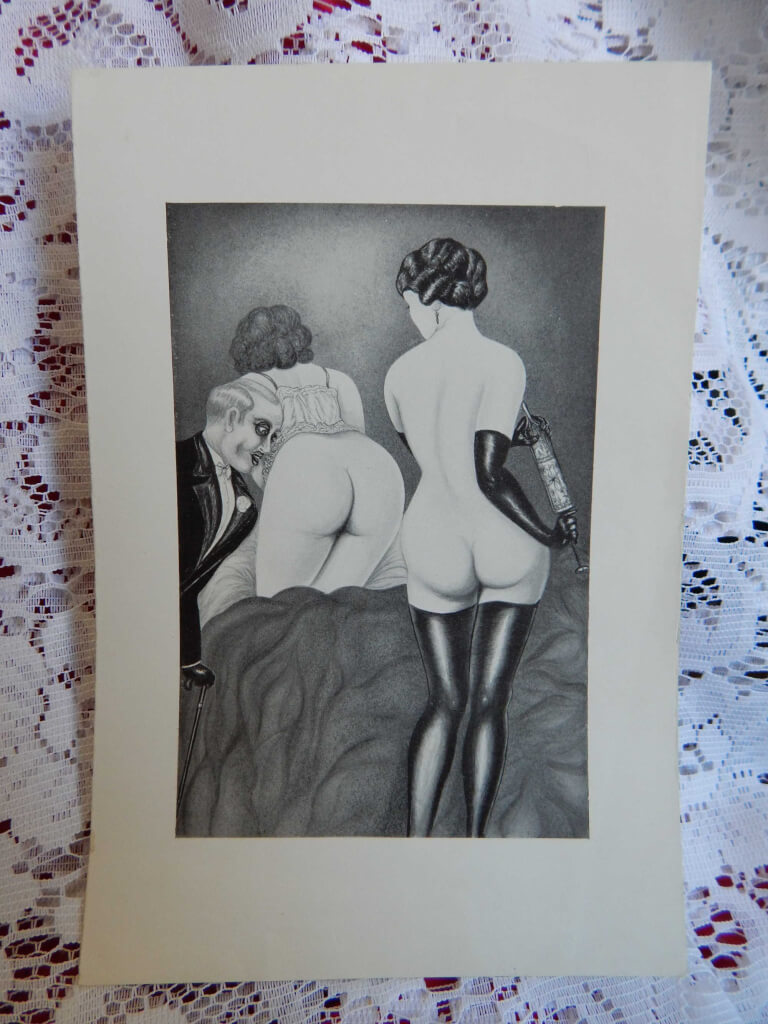 Enema, artist unknown 5.5"x8", unknown plate, found it inside an unrelated book
Enema, artist unknown 5.5"x8", unknown plate, found it inside an unrelated book -
Out of stock
 Emmanuelle, Bianca, and Venus in Furs, Emmanuelle Arsan, Leopold von Sacher-Masoch, Guido Crepax, introduction by Paolo Caneppelle and Günter Krenn [Evergreen/Benedikt Taschen Verlag GmbH, 2000, Germany, 1st edition thus] 8 x 10.5", 463pp, Hardcover w/DJ, red boards with white lettering, like-new condition. Published in 2000, and nolonger in print, designed by Lambert & Lambert, this edition has become rare and sought after. It was published with another volume “Justine and The Story of O”. This book has three of Crepax’s graphic novels. All three (like most of Crepax’s works) are very sexually graphic stories of sexual self-discovery under varying circumstances. Guido Crepas (1933-2003), better known by his nom de plume Guido Crepax, was an Italian comics artist. He is most famous for his character Valentina, created in 1965 and very representative of the spirit of the 1960s. The Valentina series of books and strips became noted for Crepax's sophisticated drawing, and for the psychedelic, dreamlike storylines, generally involving a strong dose of erotism. Marayat Rollet-Andriane formerly Marayat Krasaesin (1932-2005), known by the pen name Emmanuelle Arsan, was a French novelist of Thai origin, best known for the novel featuring the fictional character Emmanuelle, a woman who sets out on a voyage of sexual self-discovery under varying circumstances. It was later claimed that the real author of the book was her husband, Louis-Jacques Rollet-Andriane. The novel Emmanuelle was initially published and distributed clandestinely in France in 1959, without an author's name. Successive editions were ascribed to Emmanuelle Arsan, who was subsequently revealed to be Marayat Rollet-Andriane. Though the novel was sometimes hinted to be quasi-autobiographical, it was later revealed that the actual author was her husband Louis-Jacques Rollet-Andriane. Several more novels were published under the Emmanuelle Arsan pseudonym. Venus in Furs (German: Venus im Pelz) is a novella by Leopold Ritter von Sacher-Masoch (1836-1895), an Austrian writer and journalist. It is now his best known work and because of its themes the term masochism is derived from his name, coined by the Austrian psychiatrist, Krafft-Ebing. The novel was to be part of an epic series that Sacher-Masoch envisioned called Legacy of Cain. Venus in Furs was part of Love, the first volume of the series. It was published in 1870. The novel draws themes, like female dominance and sadomasochism, and character inspiration heavily from Sacher-Masoch's own life. Wanda von Dunajew, the novel's central female character, was modelled after his mistress Baroness Fanny Pistor. In December 1869 the two signed a contract making him her slave for a period of 6 months. In 1873, after the publication of Venus in Furs, Sacher-Masoch married Aurora von Rümelin who he pressured to continue the lifestyle he wrote about in his book. After 10 years they divorced. Rümelin, using the pseudonym of the books title character, "Wanda von Dunajew", wrote Meine Lebensbeichte (My Life Confession) published in 1906. It detailed Sacher-Masoch's private life and her relationship with him. During his lifetime, Sacher-Masoch was well known as a man of letters, a utopian thinker who espoused socialist and humanist ideals in his fiction and non-fiction. Most of his works remain untranslated into English. Until recently, his novel Venus in Furs was his only book commonly available in English.
Emmanuelle, Bianca, and Venus in Furs, Emmanuelle Arsan, Leopold von Sacher-Masoch, Guido Crepax, introduction by Paolo Caneppelle and Günter Krenn [Evergreen/Benedikt Taschen Verlag GmbH, 2000, Germany, 1st edition thus] 8 x 10.5", 463pp, Hardcover w/DJ, red boards with white lettering, like-new condition. Published in 2000, and nolonger in print, designed by Lambert & Lambert, this edition has become rare and sought after. It was published with another volume “Justine and The Story of O”. This book has three of Crepax’s graphic novels. All three (like most of Crepax’s works) are very sexually graphic stories of sexual self-discovery under varying circumstances. Guido Crepas (1933-2003), better known by his nom de plume Guido Crepax, was an Italian comics artist. He is most famous for his character Valentina, created in 1965 and very representative of the spirit of the 1960s. The Valentina series of books and strips became noted for Crepax's sophisticated drawing, and for the psychedelic, dreamlike storylines, generally involving a strong dose of erotism. Marayat Rollet-Andriane formerly Marayat Krasaesin (1932-2005), known by the pen name Emmanuelle Arsan, was a French novelist of Thai origin, best known for the novel featuring the fictional character Emmanuelle, a woman who sets out on a voyage of sexual self-discovery under varying circumstances. It was later claimed that the real author of the book was her husband, Louis-Jacques Rollet-Andriane. The novel Emmanuelle was initially published and distributed clandestinely in France in 1959, without an author's name. Successive editions were ascribed to Emmanuelle Arsan, who was subsequently revealed to be Marayat Rollet-Andriane. Though the novel was sometimes hinted to be quasi-autobiographical, it was later revealed that the actual author was her husband Louis-Jacques Rollet-Andriane. Several more novels were published under the Emmanuelle Arsan pseudonym. Venus in Furs (German: Venus im Pelz) is a novella by Leopold Ritter von Sacher-Masoch (1836-1895), an Austrian writer and journalist. It is now his best known work and because of its themes the term masochism is derived from his name, coined by the Austrian psychiatrist, Krafft-Ebing. The novel was to be part of an epic series that Sacher-Masoch envisioned called Legacy of Cain. Venus in Furs was part of Love, the first volume of the series. It was published in 1870. The novel draws themes, like female dominance and sadomasochism, and character inspiration heavily from Sacher-Masoch's own life. Wanda von Dunajew, the novel's central female character, was modelled after his mistress Baroness Fanny Pistor. In December 1869 the two signed a contract making him her slave for a period of 6 months. In 1873, after the publication of Venus in Furs, Sacher-Masoch married Aurora von Rümelin who he pressured to continue the lifestyle he wrote about in his book. After 10 years they divorced. Rümelin, using the pseudonym of the books title character, "Wanda von Dunajew", wrote Meine Lebensbeichte (My Life Confession) published in 1906. It detailed Sacher-Masoch's private life and her relationship with him. During his lifetime, Sacher-Masoch was well known as a man of letters, a utopian thinker who espoused socialist and humanist ideals in his fiction and non-fiction. Most of his works remain untranslated into English. Until recently, his novel Venus in Furs was his only book commonly available in English. -
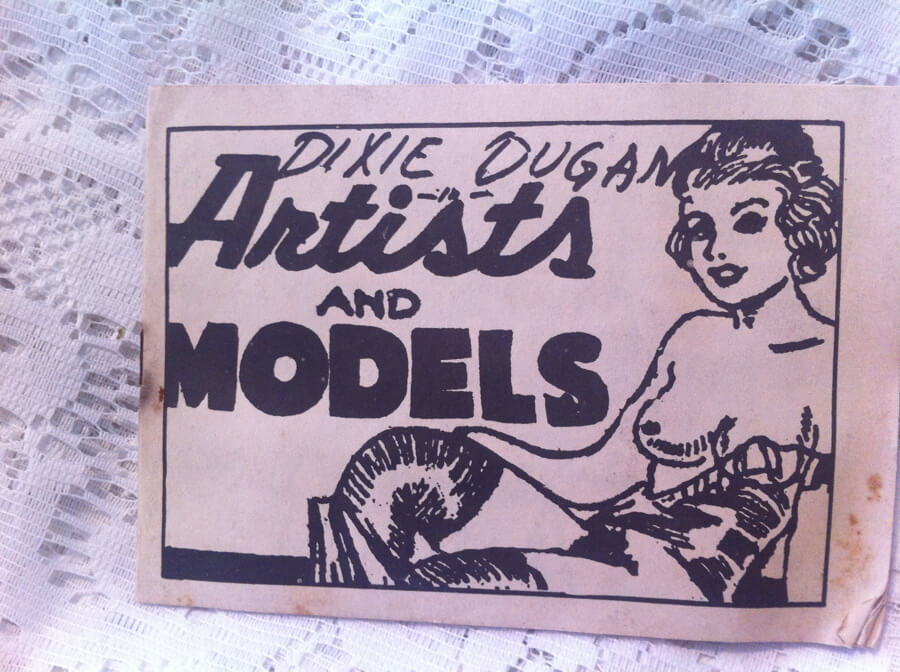
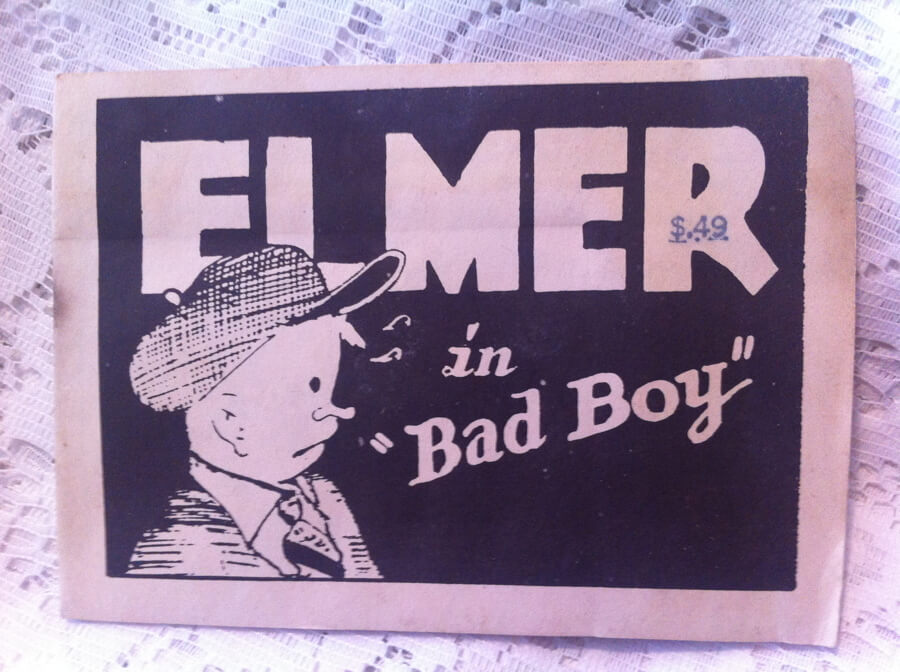 Elmer in "Bad Boy" / Dixie Dugan in Artists and Models, (n.p., n.d.) 5" x 3.5", 8pp. double pamphlet, stapled Tijuana bibles (also known as eight-pagers, bluesies, gray-backs, Jiggs-and-Maggie books, jo-jo books, Tillie-and-Mac books, and two-by-fours) were little pornographic comic books produced in the United States from the 1920s to the early 1960s. This book is two books in one, featuring reprints of the originals printed on both sides of the paper. Flip the book over and it's a different book.
Elmer in "Bad Boy" / Dixie Dugan in Artists and Models, (n.p., n.d.) 5" x 3.5", 8pp. double pamphlet, stapled Tijuana bibles (also known as eight-pagers, bluesies, gray-backs, Jiggs-and-Maggie books, jo-jo books, Tillie-and-Mac books, and two-by-fours) were little pornographic comic books produced in the United States from the 1920s to the early 1960s. This book is two books in one, featuring reprints of the originals printed on both sides of the paper. Flip the book over and it's a different book. -
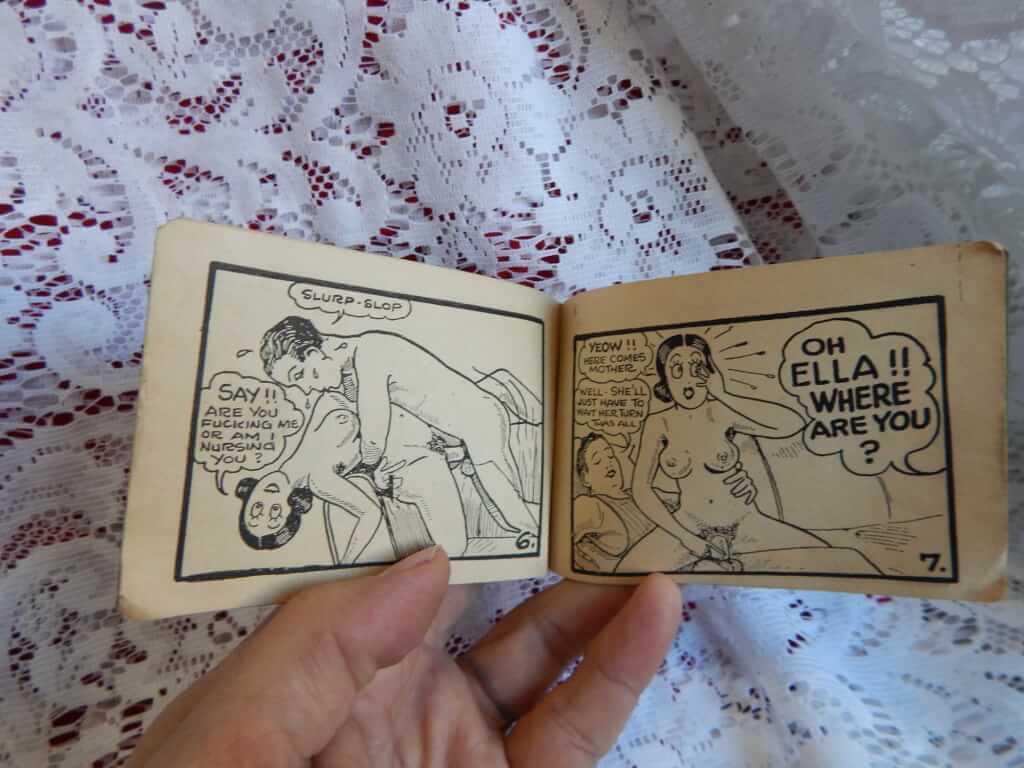
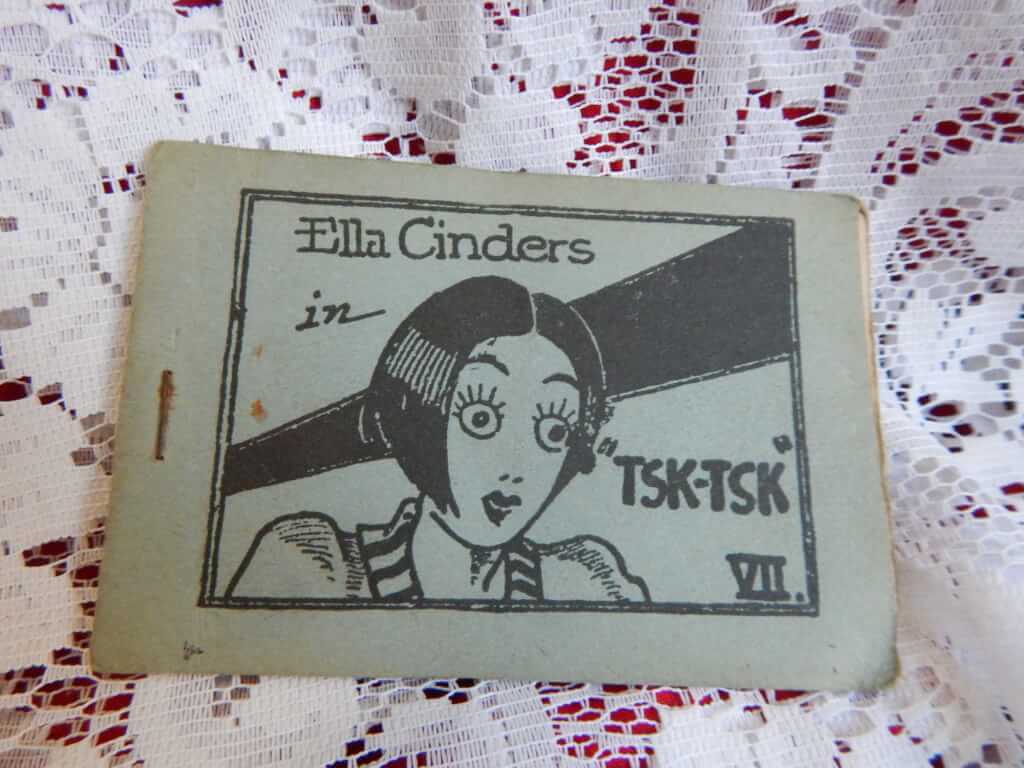 Ella Cinders in "Tsk-Tsk", (n.p. n.d.) 4.5" x 3", 8pp. pamphlet, stapled Tijuana bibles (also known as eight-pagers, bluesies, gray-backs, Jiggs-and-Maggie books, jo-jo books, Tillie-and-Mac books, and two-by-fours) were little pornographic comic books produced in the United States from the 1920s to the early 1960s.
Ella Cinders in "Tsk-Tsk", (n.p. n.d.) 4.5" x 3", 8pp. pamphlet, stapled Tijuana bibles (also known as eight-pagers, bluesies, gray-backs, Jiggs-and-Maggie books, jo-jo books, Tillie-and-Mac books, and two-by-fours) were little pornographic comic books produced in the United States from the 1920s to the early 1960s. -
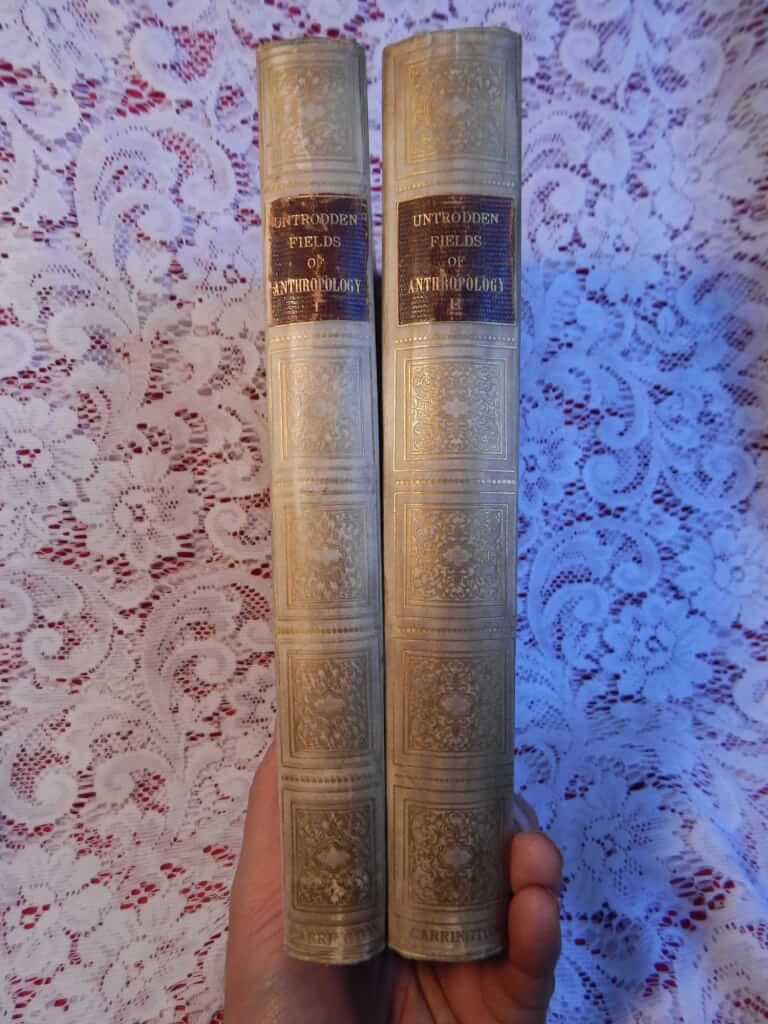
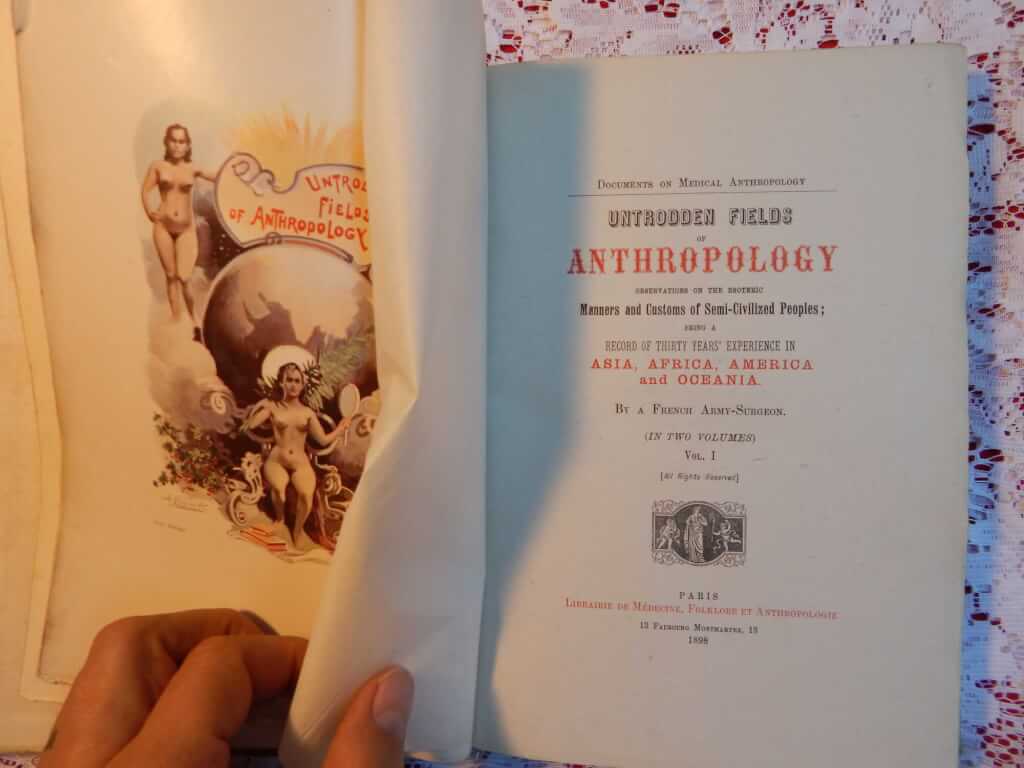 Documents on Medical Anthropology | Untrodden Fields of Anthropology | observations on the esoteric Manners and Customs of Semi-Civilized Peoples; being a record of thirty years' experience in asia, africa, america, and oceana., "By a French Army-Surgeon [in later books identified as "Jacobus X.."] (Charles Carrington, Paris, 1898, "second enlarged and revised edition [was there a first?]", #52/150, "printed on papier de chine") 7"x10" 2 vol., xl+ 341pp, xiv+502pp, Hardbound with paper wrappers inside, 1/2-bound in vellum over marbled boards, gilt lettering on spine, top edge gilt, other edges deckle/uncut, fine hand-laid paper, marlbled endpapers, binding tight, color frontispiece and numerous B&W full page engravings with descriptive tissue guards, very rare copy, bookplates of Frederic Roa This work of ''anthropology'' seems in fact intended to serve the purposes of titillation with its detailed descriptions of exotic sexual practices. Also present in this edition (to be presumably studied) are illustrations of naked women from all over the world. This is a rare book, often mentioned but not seen.
Documents on Medical Anthropology | Untrodden Fields of Anthropology | observations on the esoteric Manners and Customs of Semi-Civilized Peoples; being a record of thirty years' experience in asia, africa, america, and oceana., "By a French Army-Surgeon [in later books identified as "Jacobus X.."] (Charles Carrington, Paris, 1898, "second enlarged and revised edition [was there a first?]", #52/150, "printed on papier de chine") 7"x10" 2 vol., xl+ 341pp, xiv+502pp, Hardbound with paper wrappers inside, 1/2-bound in vellum over marbled boards, gilt lettering on spine, top edge gilt, other edges deckle/uncut, fine hand-laid paper, marlbled endpapers, binding tight, color frontispiece and numerous B&W full page engravings with descriptive tissue guards, very rare copy, bookplates of Frederic Roa This work of ''anthropology'' seems in fact intended to serve the purposes of titillation with its detailed descriptions of exotic sexual practices. Also present in this edition (to be presumably studied) are illustrations of naked women from all over the world. This is a rare book, often mentioned but not seen. -
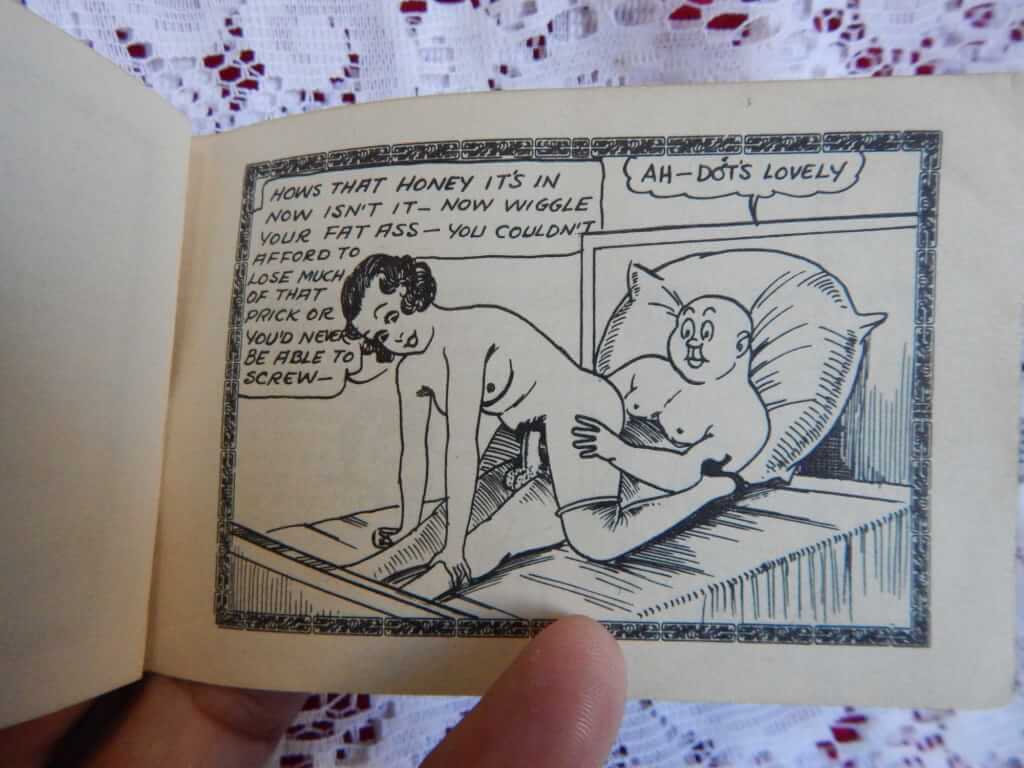
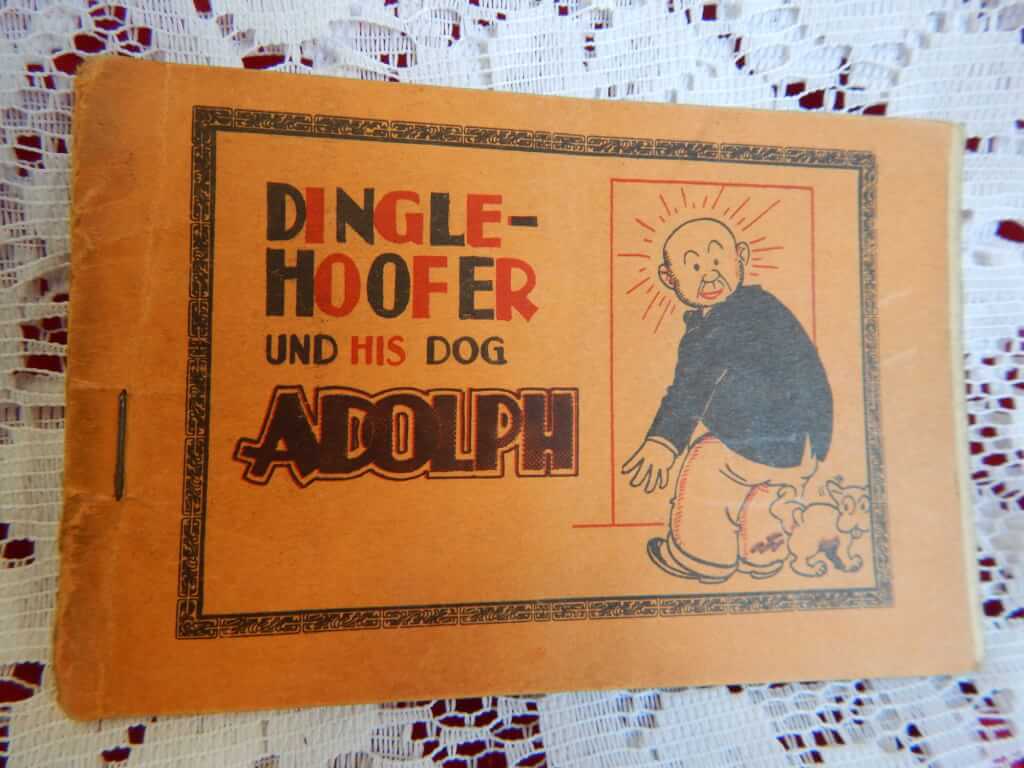 Dingle-Hoofer und his dog Adolph, (np. nd.) 4.5" x 3", 8pp. pamphlet, stapled Tijuana bibles (also known as eight-pagers, bluesies, gray-backs, Jiggs-and-Maggie books, jo-jo books, Tillie-and-Mac books, and two-by-fours) were little pornographic comic books produced in the United States from the 1920s to the early 1960s.
Dingle-Hoofer und his dog Adolph, (np. nd.) 4.5" x 3", 8pp. pamphlet, stapled Tijuana bibles (also known as eight-pagers, bluesies, gray-backs, Jiggs-and-Maggie books, jo-jo books, Tillie-and-Mac books, and two-by-fours) were little pornographic comic books produced in the United States from the 1920s to the early 1960s. -
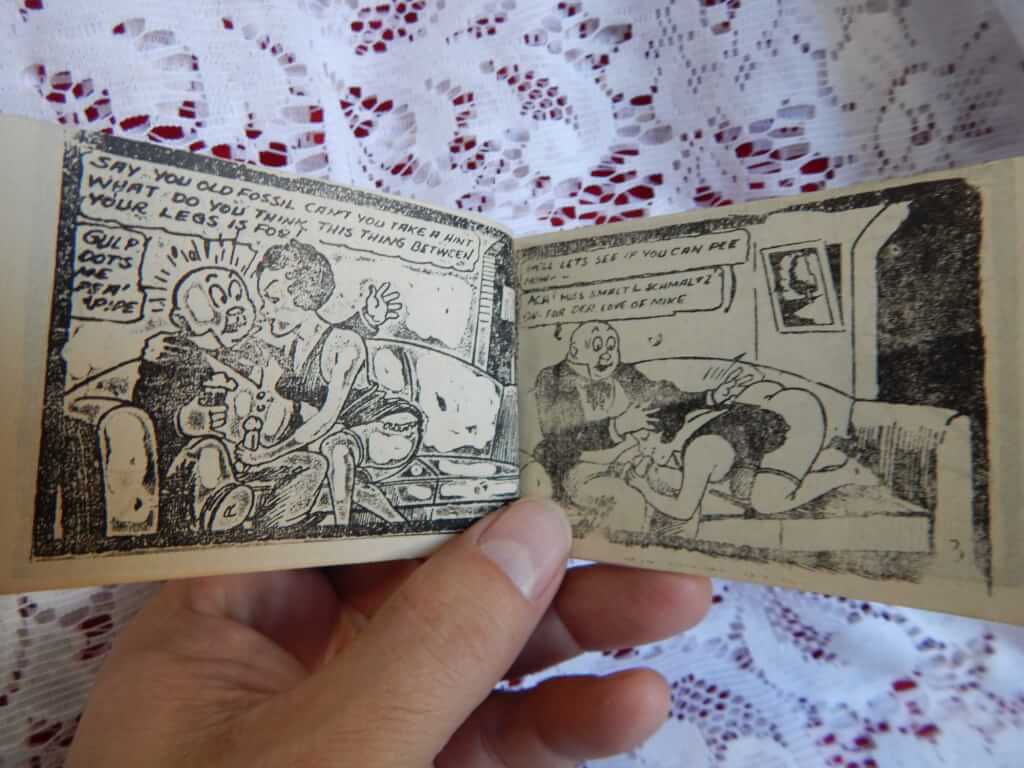
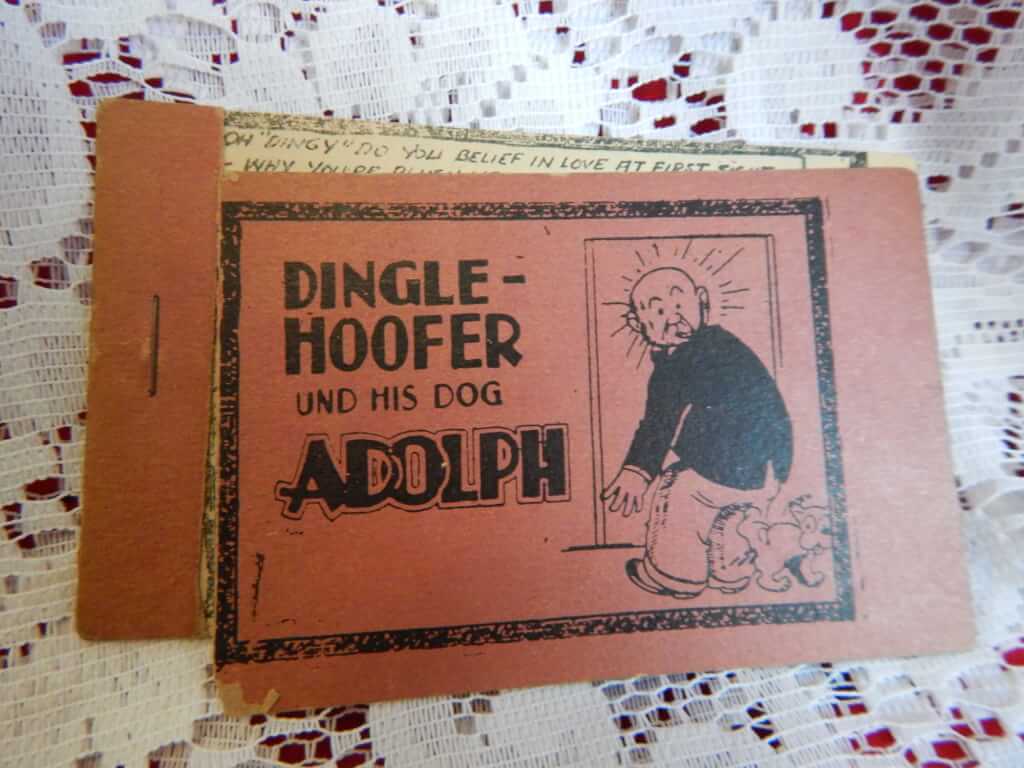 Dingle Hoofer and his Dog Aolph, (n.p. n.d.) 4.5" x 3", 8pp. pamphlet, stapled, cover detatched Tijuana bibles (also known as eight-pagers, bluesies, gray-backs, Jiggs-and-Maggie books, jo-jo books, Tillie-and-Mac books, and two-by-fours) were little pornographic comic books produced in the United States from the 1920s to the early 1960s.
Dingle Hoofer and his Dog Aolph, (n.p. n.d.) 4.5" x 3", 8pp. pamphlet, stapled, cover detatched Tijuana bibles (also known as eight-pagers, bluesies, gray-backs, Jiggs-and-Maggie books, jo-jo books, Tillie-and-Mac books, and two-by-fours) were little pornographic comic books produced in the United States from the 1920s to the early 1960s. -
 Die Weiberherrschaft in der Geschichte der Menschheit [The Rule of Women in the History of Mankind], Eduard Fuchs, Alfred Kind (Albert Langen, München, 1913) 8.75″ X 11″, complete set, 2 volumes plus supplementary volume, x+1-348pp, 349-711pp, ix+319pp, decorated green cloth boards, decorated cloth endpapers, binding loose by design and very much intact on all volumes (binding is often a problem with this edition), Vol. 1&2 contain 665 illustrations and 90 tipped in illustrations. The supplemental volume contains 317 illustrations and 34 tipped in illustrations. Minor bumping on covers, in excellent condition for age. Compiling 665+317 reproductions of drawings, prints and paintings from the collection of Eduard Fuchs, this edition shows how the image of female domination and male submission was widespread in Europe from the Renaissance to the early 20th century. Edward Fuchs (1870-1940). Fuchs' father was a shopkeeper. Early in his life, the younger Fuchs developed socialist and Marxist political convictions. In 1886, he joined the outlawed political party Sozialistische Arbeiterpartei (the precursor of the modern SPD, Sozialdemokratische Partei Deutschlands). Fuchs received a doctor of law degree and practiced as an attorney. In 1892, he became editor-in-chief of the satiric weekly Süddeutscher Postillon and later co-editor of the Leipziger Volkszeitung. His inflammatory articles in newspapers—one accusing the Kaiser of being a mass murderer—resulted in periodic jail sentences. During his periods of confinement, Fuchs wrote various social histories utilizing images as one of his primary sources. The first of these was his Karikatur der europäischen Völker (Caricatures of European Peoples), 1902. He moved to Berlin that same year where he edited the socialist newspaper Vorwärts. The following year he began his magnum opus, an examination of moral practice, Sittengeschichte, eventually running to six volumes by 1912. While engaged in this series, he followed up his interest in caricatures with one devoted to the representation of women, Die Frau in der Karikatur, 1905 (3 vols). Another book documenting the stereotypical representations of Jews appeared in 1912. Fuchs traveled with the artist Max Slevogt to Egypt in 1914, shortly before the outbreak of World War I. He was a pacifist during the War. Lenin's government put him in charge of prisoner exchange with Germany after the war; he was among the leaders of the German Comintern in Berlin in 1919. His interest in societal concerns in caricature led to a research interest in Daumier. Beginning in 1920, Fuchs published a catalogue raisonné on the artist in three volumes. He resigned from the party in 1929, following the expulsion of several stalwarts. At Hitler's ascension to power in Germany in 1933, Fuchs moved to France.
Die Weiberherrschaft in der Geschichte der Menschheit [The Rule of Women in the History of Mankind], Eduard Fuchs, Alfred Kind (Albert Langen, München, 1913) 8.75″ X 11″, complete set, 2 volumes plus supplementary volume, x+1-348pp, 349-711pp, ix+319pp, decorated green cloth boards, decorated cloth endpapers, binding loose by design and very much intact on all volumes (binding is often a problem with this edition), Vol. 1&2 contain 665 illustrations and 90 tipped in illustrations. The supplemental volume contains 317 illustrations and 34 tipped in illustrations. Minor bumping on covers, in excellent condition for age. Compiling 665+317 reproductions of drawings, prints and paintings from the collection of Eduard Fuchs, this edition shows how the image of female domination and male submission was widespread in Europe from the Renaissance to the early 20th century. Edward Fuchs (1870-1940). Fuchs' father was a shopkeeper. Early in his life, the younger Fuchs developed socialist and Marxist political convictions. In 1886, he joined the outlawed political party Sozialistische Arbeiterpartei (the precursor of the modern SPD, Sozialdemokratische Partei Deutschlands). Fuchs received a doctor of law degree and practiced as an attorney. In 1892, he became editor-in-chief of the satiric weekly Süddeutscher Postillon and later co-editor of the Leipziger Volkszeitung. His inflammatory articles in newspapers—one accusing the Kaiser of being a mass murderer—resulted in periodic jail sentences. During his periods of confinement, Fuchs wrote various social histories utilizing images as one of his primary sources. The first of these was his Karikatur der europäischen Völker (Caricatures of European Peoples), 1902. He moved to Berlin that same year where he edited the socialist newspaper Vorwärts. The following year he began his magnum opus, an examination of moral practice, Sittengeschichte, eventually running to six volumes by 1912. While engaged in this series, he followed up his interest in caricatures with one devoted to the representation of women, Die Frau in der Karikatur, 1905 (3 vols). Another book documenting the stereotypical representations of Jews appeared in 1912. Fuchs traveled with the artist Max Slevogt to Egypt in 1914, shortly before the outbreak of World War I. He was a pacifist during the War. Lenin's government put him in charge of prisoner exchange with Germany after the war; he was among the leaders of the German Comintern in Berlin in 1919. His interest in societal concerns in caricature led to a research interest in Daumier. Beginning in 1920, Fuchs published a catalogue raisonné on the artist in three volumes. He resigned from the party in 1929, following the expulsion of several stalwarts. At Hitler's ascension to power in Germany in 1933, Fuchs moved to France. -
 Die Abenteuer des Chevalier Faublas | Erzählt von Louvet de Couvray [[The adventures of the Chevalier Faublas | Told by Louvet de Couvray], etchings by Karl Walser (Georg Müller, Munich, 1910, #1411/1500) 8.25"x5.5", 4 volumes, x+216pp, 279pp, 295pp, 344pp, half calf over decorated silk (from a drawing by Karl Walser), black title and vol. label with gilt lettering and decorations on spine, 4 etched title vignettes and 12 toned etchings by Karl Walser on 12 panels with green tissue guard, ribbons present in all volumes, good+ condition. Karl Walser (1877-1943) was a Swiss painter, set designer and illustrator. His artwork, although very popular during his lifetime, has mostly been forgotten by the art world, unlike his brother, author Robert Walser, who was never able to support himself through writing which gained notoriety after his death. Jean-Baptiste Louvet de Couvrai (1760 - 1797) was born in Paris as the son of a stationer, he became a bookseller's clerk, and first attracted attention with the first part of his novel "Les Amours du chevalier de Faublas" (5 parts) in 1787; it was followed in 1788 by "Six semaines de la vie du chevalier de Faublas" (8 parts) and in 1790 by "La Fin des amours du chevalier de Faublas" (6 parts). The heroine, Lodoiska, was modeled on the wife of a jeweler in the Palais Royal, with whom he had an affair. She divorced her husband in 1792 and married Louvet in 1793. This is considered a so-called "libertine" novel. It dwells mainly on the sexual escapades of its hero, a sort of amiable young libertine, and on the corrupted morals of eighteenth-century France. At the start of this novel the young Chevalier de Faublas attends a party dressed as a woman and is knowingly seduced by the lady of the house ('. I receive with equal astonishment and pleasure a charming lesson, which I repeated more than once .') Oxford Comp. to French Literature says it is "typical of many frivolous, licentious novels of its time, and still mentioned. Faublas, the amiable hero, is the victim of his own charms. His amorous adventures, recounted with a certain lively force, begin with his entry into society at the age of sixteen. He loves several women by the way and three in particular. A jealous husband and a despairing suicide reduce the three to one. The novel ends on a moral note: Faublas , who had happened to settle down with his remaining love, is haunted by the avenging phantoms of the other two and goes mad."
Die Abenteuer des Chevalier Faublas | Erzählt von Louvet de Couvray [[The adventures of the Chevalier Faublas | Told by Louvet de Couvray], etchings by Karl Walser (Georg Müller, Munich, 1910, #1411/1500) 8.25"x5.5", 4 volumes, x+216pp, 279pp, 295pp, 344pp, half calf over decorated silk (from a drawing by Karl Walser), black title and vol. label with gilt lettering and decorations on spine, 4 etched title vignettes and 12 toned etchings by Karl Walser on 12 panels with green tissue guard, ribbons present in all volumes, good+ condition. Karl Walser (1877-1943) was a Swiss painter, set designer and illustrator. His artwork, although very popular during his lifetime, has mostly been forgotten by the art world, unlike his brother, author Robert Walser, who was never able to support himself through writing which gained notoriety after his death. Jean-Baptiste Louvet de Couvrai (1760 - 1797) was born in Paris as the son of a stationer, he became a bookseller's clerk, and first attracted attention with the first part of his novel "Les Amours du chevalier de Faublas" (5 parts) in 1787; it was followed in 1788 by "Six semaines de la vie du chevalier de Faublas" (8 parts) and in 1790 by "La Fin des amours du chevalier de Faublas" (6 parts). The heroine, Lodoiska, was modeled on the wife of a jeweler in the Palais Royal, with whom he had an affair. She divorced her husband in 1792 and married Louvet in 1793. This is considered a so-called "libertine" novel. It dwells mainly on the sexual escapades of its hero, a sort of amiable young libertine, and on the corrupted morals of eighteenth-century France. At the start of this novel the young Chevalier de Faublas attends a party dressed as a woman and is knowingly seduced by the lady of the house ('. I receive with equal astonishment and pleasure a charming lesson, which I repeated more than once .') Oxford Comp. to French Literature says it is "typical of many frivolous, licentious novels of its time, and still mentioned. Faublas, the amiable hero, is the victim of his own charms. His amorous adventures, recounted with a certain lively force, begin with his entry into society at the age of sixteen. He loves several women by the way and three in particular. A jealous husband and a despairing suicide reduce the three to one. The novel ends on a moral note: Faublas , who had happened to settle down with his remaining love, is haunted by the avenging phantoms of the other two and goes mad." -
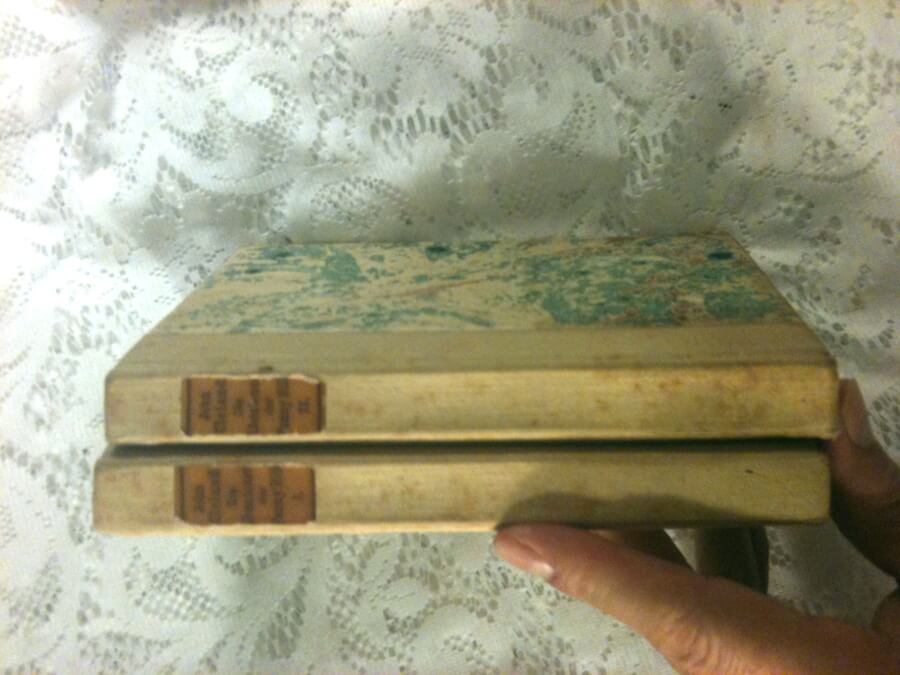
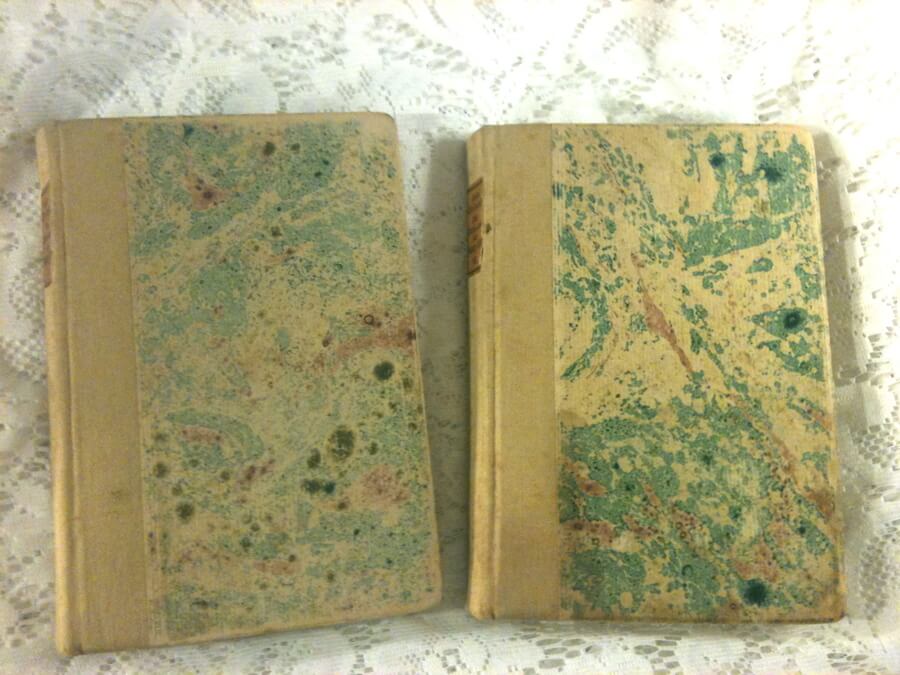 Die Abenteuer der Fanny Hill, John Cleland (np, München, 1919) 7.25" x 5", 2 vol., 178pp, 179-370pp, hardbound, marbled paper boards with cloth spine. Paper label on spine. Good condition for age, showing wear at hinges, both slightly cocked, pages yellowing. Boards worn at edges and corners Written while the author was in debtor's prison in London and first published in 1749, Fanny Hill is considered the first original English prose pornography, and the first pornography to use the form of the novel. One of the most prosecuted and banned books in history, it has become a synonym for obscenity. This German version of Fanny Hill is without mention of publisher. This was German "Bückware" or an item that was kept under the counter only for customers who asked for it. A nice 2 volume set in German.
Die Abenteuer der Fanny Hill, John Cleland (np, München, 1919) 7.25" x 5", 2 vol., 178pp, 179-370pp, hardbound, marbled paper boards with cloth spine. Paper label on spine. Good condition for age, showing wear at hinges, both slightly cocked, pages yellowing. Boards worn at edges and corners Written while the author was in debtor's prison in London and first published in 1749, Fanny Hill is considered the first original English prose pornography, and the first pornography to use the form of the novel. One of the most prosecuted and banned books in history, it has become a synonym for obscenity. This German version of Fanny Hill is without mention of publisher. This was German "Bückware" or an item that was kept under the counter only for customers who asked for it. A nice 2 volume set in German. -
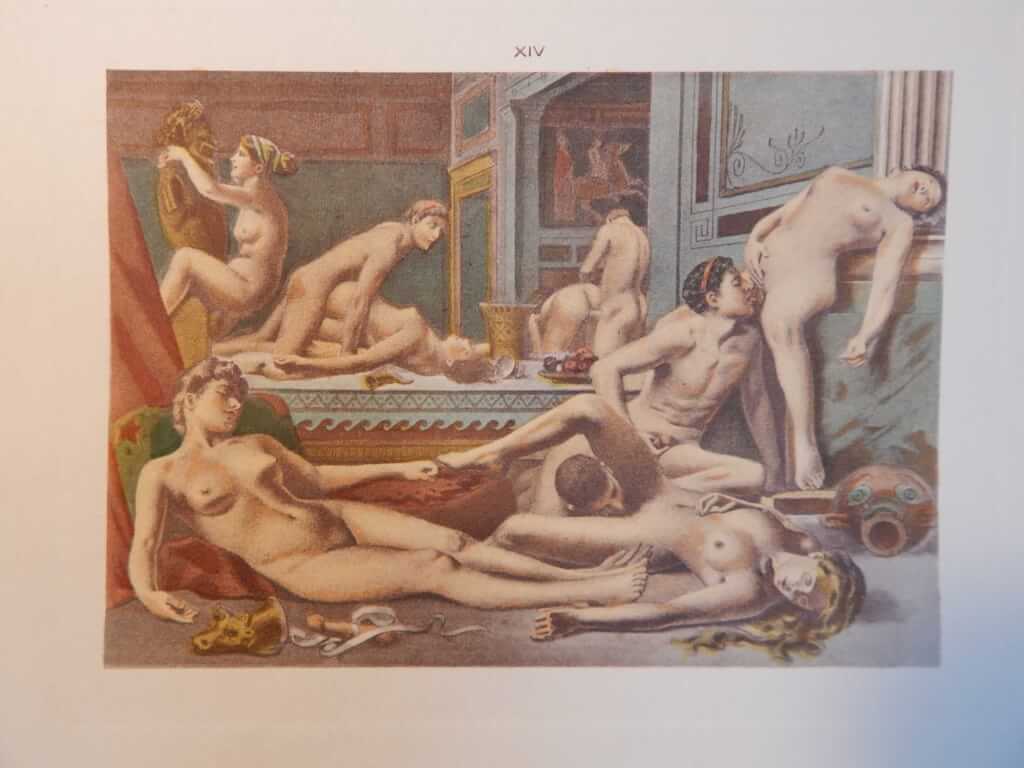
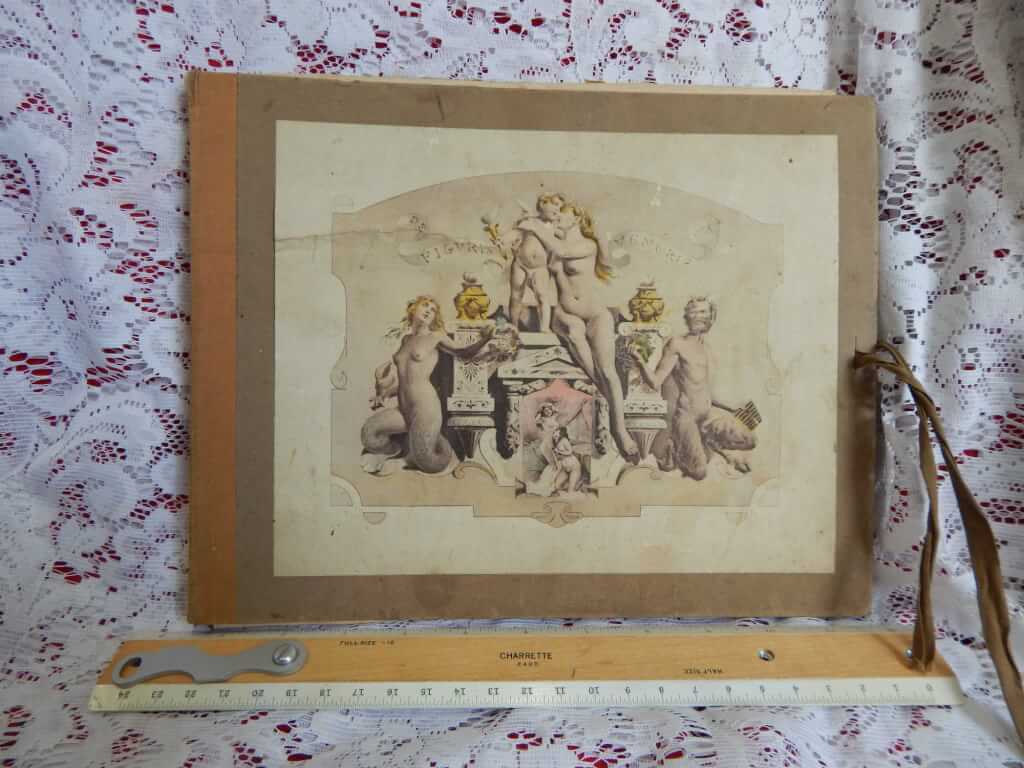 De Figuris Veneris, suite de 19 gravures en couleurs et un frontispice, Paul Avril, np. nd., [Charles Hirsch, Paris 1906] 11"x9" portfolio book with frontispiece with 19 loose hand-colored lithographs (10.5"x8.5") each with tissue guard describing scene and page where they are to be inserted into book. String ties intact. Soiling and rip to frontispiece on cover and some rips and soiling on inner flaps that hold the artwork. Lithographs are in good+ condition some minor soiling on paper but not on the art. Previous owner's inscription on inside front board, "Le H. Avril 1938 | Toulouse | G. A France's" When publishers sold books in the early 19th century, they often sold the illustrations separately. These illustrations are for F.K. Forbergs Manuel d'Erotologie Classique (de Figuris Veneris) [Charles Hirsch, Paris 1906]. These (and the illustrations he did for Carrington's Fanny Hill) are the most explicit, rare, and sought after illustrations by Paul Avril. Most copies of Manuel d'Erotologie Classique have a combination of black, red, or sepia monochromatic illustrations. I have yet to find a copy of the book with all 19 hand-colored illustrations. The only lithograph prints of this work I've seen have been black & white (probably ripped out of books). This is the only "un-inserted" loosely bound portfolio of the hand-colored lithographs I have found anywhere. Édouard-Henri Avril (1849-1928) used the pseudonym "Paul Avril" for his erotic work. He was a French painter and commercial artist. His career saw collaboration with influential people like Octave Uzanne, Henry Spencer Ashbee and Friedrich Karl Forberg. He is one of the most celebrated erotic artists of his age. Avril was a soldier before starting his career in art. He was awarded with the Legion of Honour for his actions in the Franco-Prussian War.
De Figuris Veneris, suite de 19 gravures en couleurs et un frontispice, Paul Avril, np. nd., [Charles Hirsch, Paris 1906] 11"x9" portfolio book with frontispiece with 19 loose hand-colored lithographs (10.5"x8.5") each with tissue guard describing scene and page where they are to be inserted into book. String ties intact. Soiling and rip to frontispiece on cover and some rips and soiling on inner flaps that hold the artwork. Lithographs are in good+ condition some minor soiling on paper but not on the art. Previous owner's inscription on inside front board, "Le H. Avril 1938 | Toulouse | G. A France's" When publishers sold books in the early 19th century, they often sold the illustrations separately. These illustrations are for F.K. Forbergs Manuel d'Erotologie Classique (de Figuris Veneris) [Charles Hirsch, Paris 1906]. These (and the illustrations he did for Carrington's Fanny Hill) are the most explicit, rare, and sought after illustrations by Paul Avril. Most copies of Manuel d'Erotologie Classique have a combination of black, red, or sepia monochromatic illustrations. I have yet to find a copy of the book with all 19 hand-colored illustrations. The only lithograph prints of this work I've seen have been black & white (probably ripped out of books). This is the only "un-inserted" loosely bound portfolio of the hand-colored lithographs I have found anywhere. Édouard-Henri Avril (1849-1928) used the pseudonym "Paul Avril" for his erotic work. He was a French painter and commercial artist. His career saw collaboration with influential people like Octave Uzanne, Henry Spencer Ashbee and Friedrich Karl Forberg. He is one of the most celebrated erotic artists of his age. Avril was a soldier before starting his career in art. He was awarded with the Legion of Honour for his actions in the Franco-Prussian War. -
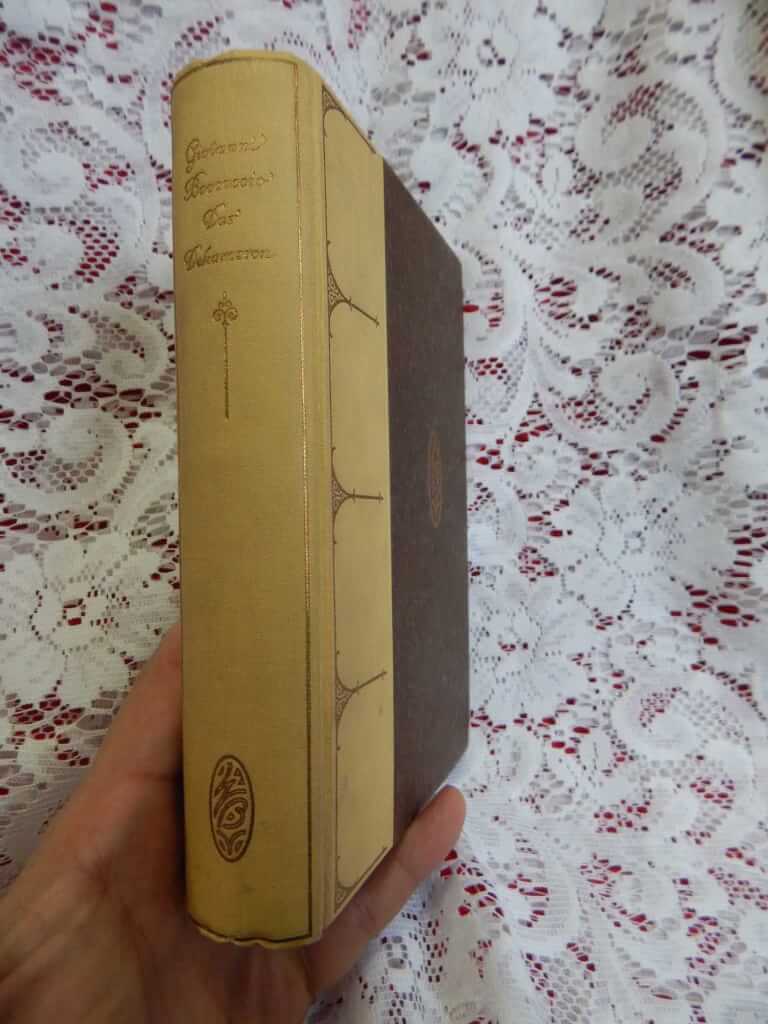
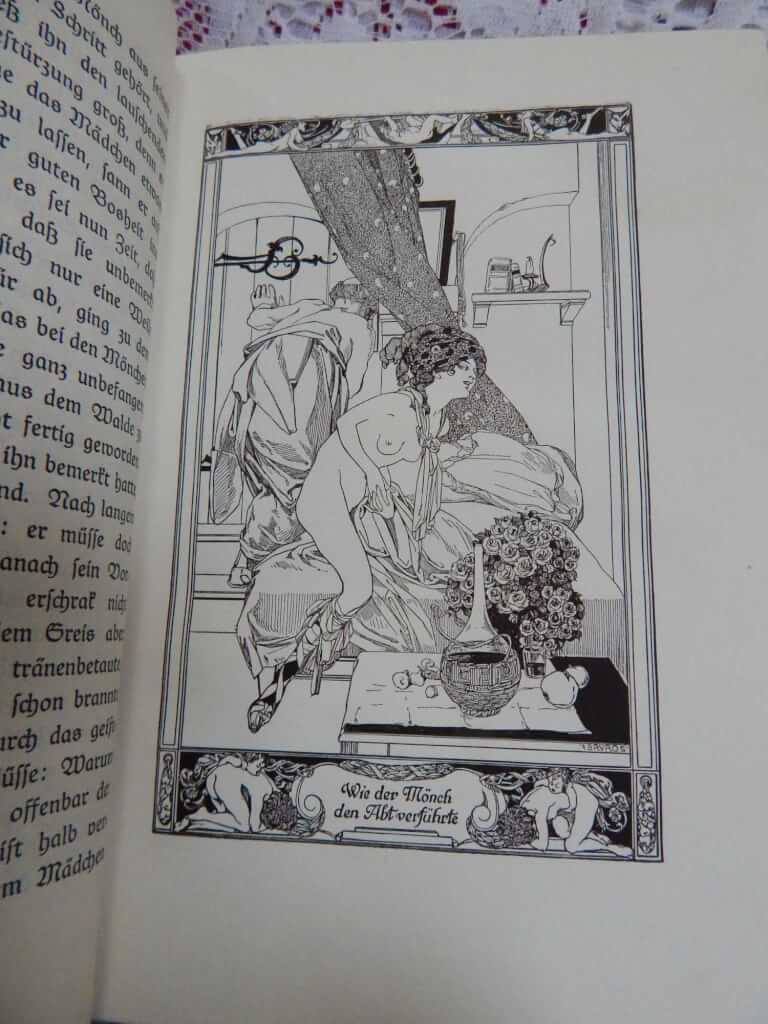 Das Dekameron, by Giovanni Baccaccio, illustrated by F. v. Bayros. With a foreword by Hanns Heinz Ewers (Wilhelm Borngräber Verlag, Berlin., 1913) 5.25"x7.5", 612pp + 4 pages of ads, hardcover, half buckram with gilt title and decorations, very good condition. German language of Boccaccio's Decameron with 6 illustrations by Franz von Bayros. The Decameron, (subtitled Prencipe Galeotto or Prince Galehaut), is a collection of novellas by the 14th-century Italian author Giovanni Boccaccio (1313–1375). The book is structured as a frame story containing 100 tales told by a group of seven young women and three young men sheltering in a secluded villa just outside Florence to escape the Black Death, which was afflicting the city. To make their exile more pleasant each of the ten tells the others one story every day. The Decameron records the narratives of ten days -- 100 stories. Boccaccio probably conceived of The Decameron after the epidemic of 1348, and completed it by 1353. These tales run the entire range of human emotion: grief, love, humor, anger, revenge. Many are based on oral folklore. Boccaccio's ten narrators thus retell already familiar stories about errant priests, rascally husbands, and mischievous wives. Variants of these stories are known in many cultures, but no one formulates them more cleverly or relates them more eloquently than does Boccaccio. In addition to its literary value and widespread influence, it provides a document of life at the time. Written in the vernacular of the Florentine language, it is considered a masterpiece of classical early Italian prose.
Das Dekameron, by Giovanni Baccaccio, illustrated by F. v. Bayros. With a foreword by Hanns Heinz Ewers (Wilhelm Borngräber Verlag, Berlin., 1913) 5.25"x7.5", 612pp + 4 pages of ads, hardcover, half buckram with gilt title and decorations, very good condition. German language of Boccaccio's Decameron with 6 illustrations by Franz von Bayros. The Decameron, (subtitled Prencipe Galeotto or Prince Galehaut), is a collection of novellas by the 14th-century Italian author Giovanni Boccaccio (1313–1375). The book is structured as a frame story containing 100 tales told by a group of seven young women and three young men sheltering in a secluded villa just outside Florence to escape the Black Death, which was afflicting the city. To make their exile more pleasant each of the ten tells the others one story every day. The Decameron records the narratives of ten days -- 100 stories. Boccaccio probably conceived of The Decameron after the epidemic of 1348, and completed it by 1353. These tales run the entire range of human emotion: grief, love, humor, anger, revenge. Many are based on oral folklore. Boccaccio's ten narrators thus retell already familiar stories about errant priests, rascally husbands, and mischievous wives. Variants of these stories are known in many cultures, but no one formulates them more cleverly or relates them more eloquently than does Boccaccio. In addition to its literary value and widespread influence, it provides a document of life at the time. Written in the vernacular of the Florentine language, it is considered a masterpiece of classical early Italian prose. -
Out of stock
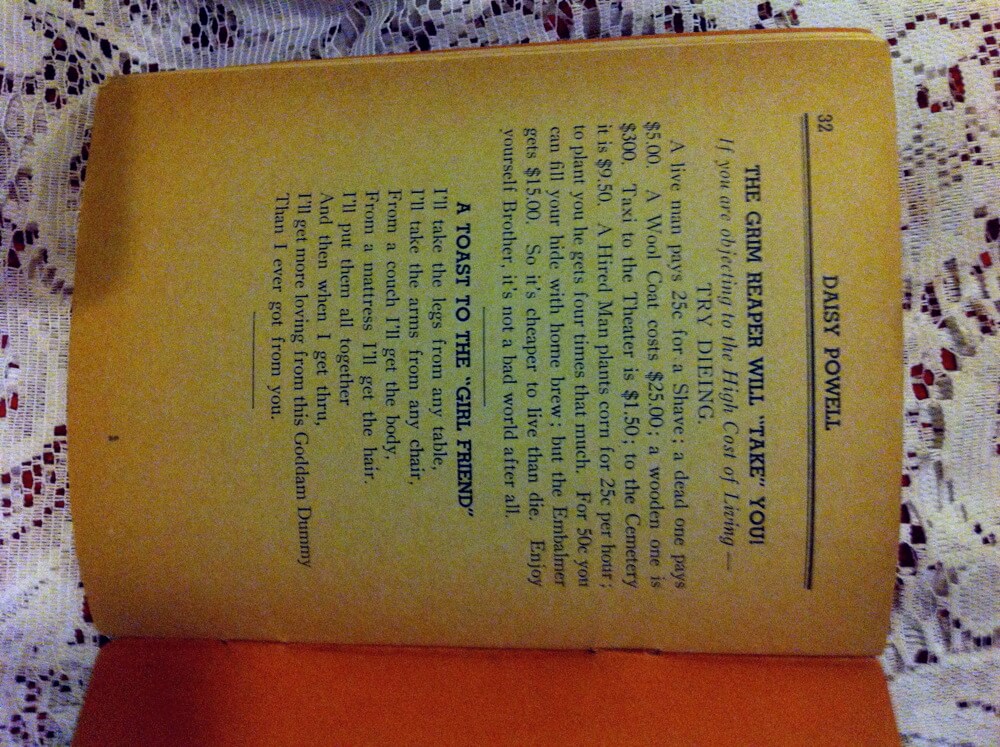
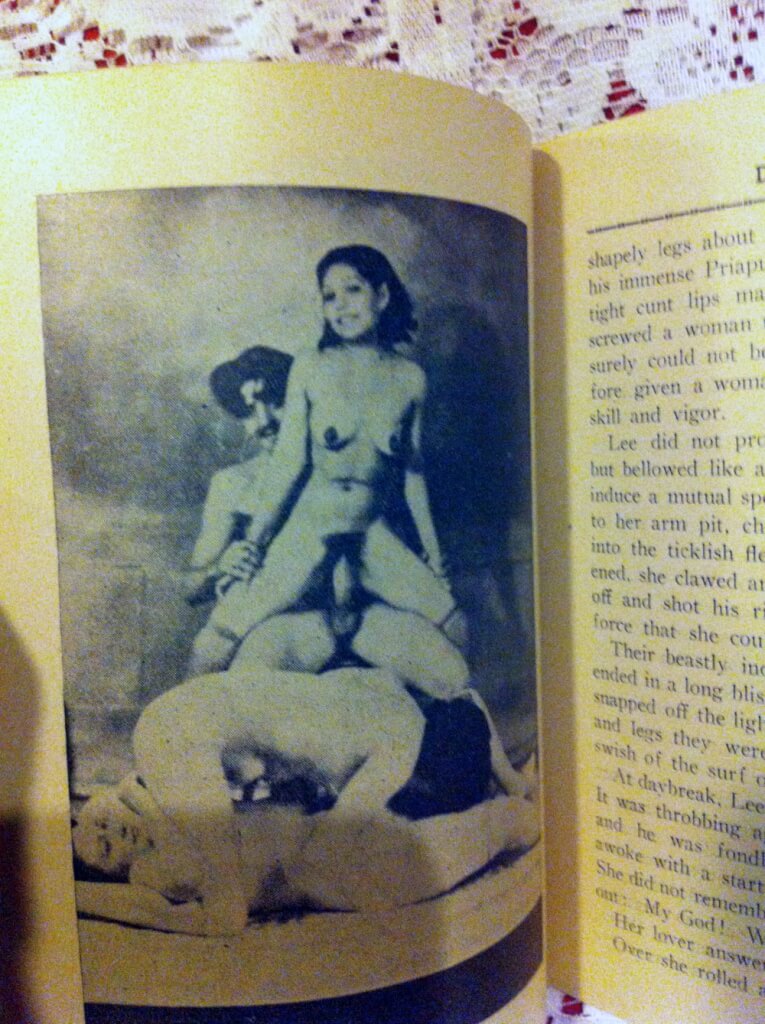 anonymous (Paris, France, nd.) 5.5" X 4.25", 32pp, softcover, good quality for age, illustrated with pornographic photos
anonymous (Paris, France, nd.) 5.5" X 4.25", 32pp, softcover, good quality for age, illustrated with pornographic photos -
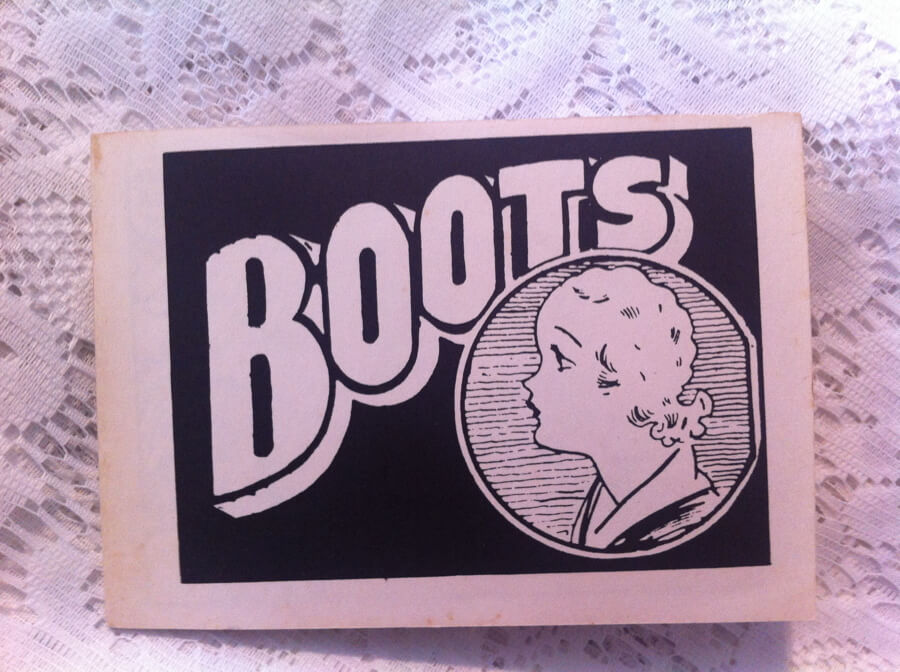
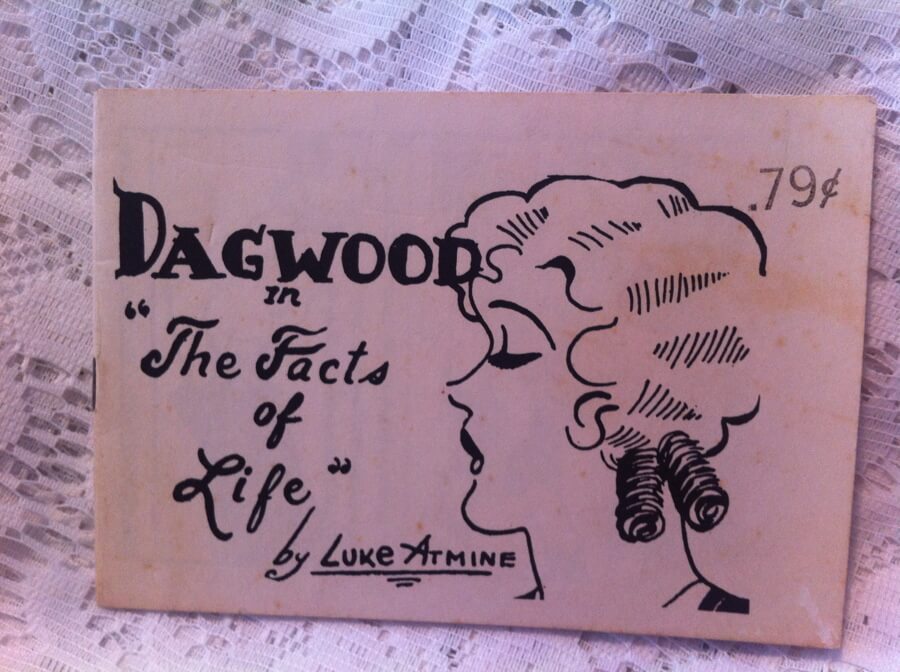 Dagwood in "The Facts of Life" / Boots, by Luke Armine (n.p., n.d.) 5" x 3.5", 8pp. double pamphlet, stapled Tijuana bibles (also known as eight-pagers, bluesies, gray-backs, Jiggs-and-Maggie books, jo-jo books, Tillie-and-Mac books, and two-by-fours) were little pornographic comic books produced in the United States from the 1920s to the early 1960s. This book is two books in one, featuring reprints of the originals printed on both sides of the paper. Flip the book over and it's a different book. "Boots and Her Buddies" was an American comic strip that ran from 1924 to 1969. Some newspapers presented the strip under the shortened title "Boots". The character of Boots was variously labeled the "Sweetheart of the Comics", the "Sweetheart of America" and "Everybody's Sweetheart".
Dagwood in "The Facts of Life" / Boots, by Luke Armine (n.p., n.d.) 5" x 3.5", 8pp. double pamphlet, stapled Tijuana bibles (also known as eight-pagers, bluesies, gray-backs, Jiggs-and-Maggie books, jo-jo books, Tillie-and-Mac books, and two-by-fours) were little pornographic comic books produced in the United States from the 1920s to the early 1960s. This book is two books in one, featuring reprints of the originals printed on both sides of the paper. Flip the book over and it's a different book. "Boots and Her Buddies" was an American comic strip that ran from 1924 to 1969. Some newspapers presented the strip under the shortened title "Boots". The character of Boots was variously labeled the "Sweetheart of the Comics", the "Sweetheart of America" and "Everybody's Sweetheart". -

 John Putz presents Daddy Warbucks in It's a Small World, (n.p. n.d.) 4.5" x 3", 8pp. pamphlet, stapled Tijuana bibles (also known as eight-pagers, bluesies, gray-backs, Jiggs-and-Maggie books, jo-jo books, Tillie-and-Mac books, and two-by-fours) were little pornographic comic books produced in the United States from the 1920s to the early 1960s.
John Putz presents Daddy Warbucks in It's a Small World, (n.p. n.d.) 4.5" x 3", 8pp. pamphlet, stapled Tijuana bibles (also known as eight-pagers, bluesies, gray-backs, Jiggs-and-Maggie books, jo-jo books, Tillie-and-Mac books, and two-by-fours) were little pornographic comic books produced in the United States from the 1920s to the early 1960s. -
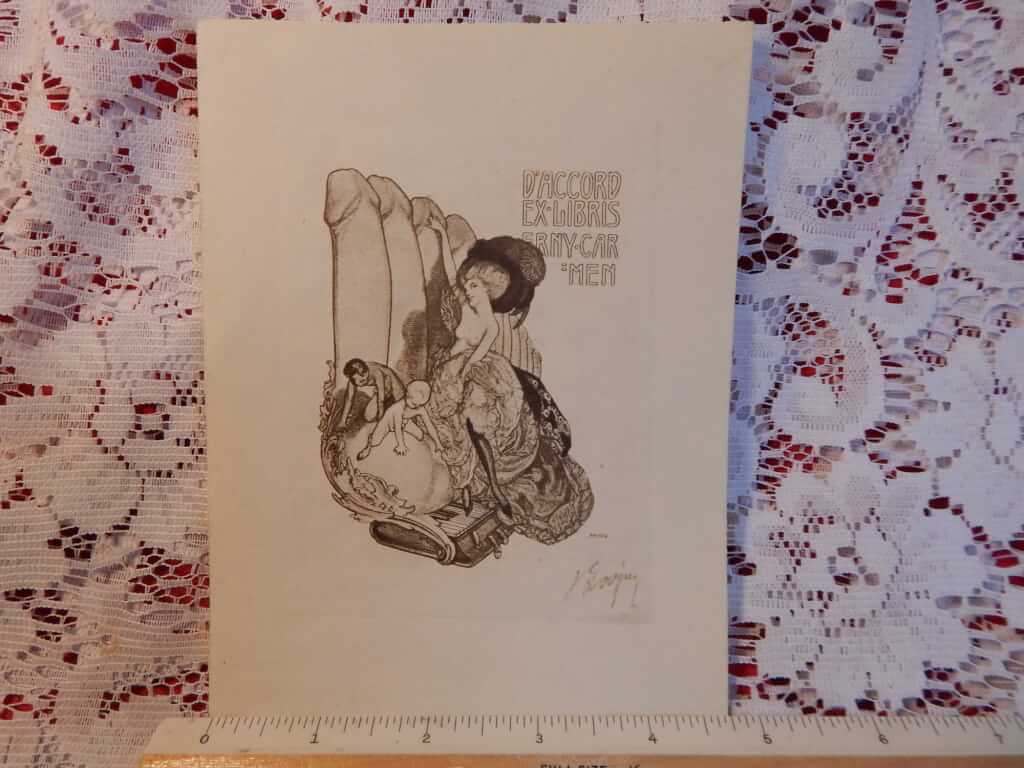 D'Accord Ex Libris Erny Camen, by Franz von Bayros paper size 4.75 x 6.25", print size 3.25 x 4.5" topless woman and two children lounging on a long line of erect penises, unknown signature in lower right corner not seen in other copies Franz von Bayros (1866 – 1924) was an Austrian commercial artist, illustrator, and painter, now he is best known for his erotic work. He belonged to the Decadent movement in art, often utilizing erotic themes and phantasmagoric imagery. At the age 17, Bayros passed the entrance exam for the Vienna Academy with Eduard von Engerth. Bayros mixed in elegant society and soon belonged to the circle of friends of Johann Straub, whose step daughter Alice he married on 1896. The next year, Bayros moved to Munich. In 1904, Bayros gave his first exhibition in Munich, which was a great success. From 1904 until 1908, Bayros traveled to Paris and Italy for his studies. Typically, for an artist dealing with such imagery, von Bayros produced work under several pseudonyms, most notably Choisy Le Conin, and was hounded by authorities for much of his life for his “indecent” art often very imaginative, and including such taboo subjects as sadomasochism and bestiality. He became equally well-known for his masterly drawn figures of elegant modestly nude and non-nude women.
D'Accord Ex Libris Erny Camen, by Franz von Bayros paper size 4.75 x 6.25", print size 3.25 x 4.5" topless woman and two children lounging on a long line of erect penises, unknown signature in lower right corner not seen in other copies Franz von Bayros (1866 – 1924) was an Austrian commercial artist, illustrator, and painter, now he is best known for his erotic work. He belonged to the Decadent movement in art, often utilizing erotic themes and phantasmagoric imagery. At the age 17, Bayros passed the entrance exam for the Vienna Academy with Eduard von Engerth. Bayros mixed in elegant society and soon belonged to the circle of friends of Johann Straub, whose step daughter Alice he married on 1896. The next year, Bayros moved to Munich. In 1904, Bayros gave his first exhibition in Munich, which was a great success. From 1904 until 1908, Bayros traveled to Paris and Italy for his studies. Typically, for an artist dealing with such imagery, von Bayros produced work under several pseudonyms, most notably Choisy Le Conin, and was hounded by authorities for much of his life for his “indecent” art often very imaginative, and including such taboo subjects as sadomasochism and bestiality. He became equally well-known for his masterly drawn figures of elegant modestly nude and non-nude women. -
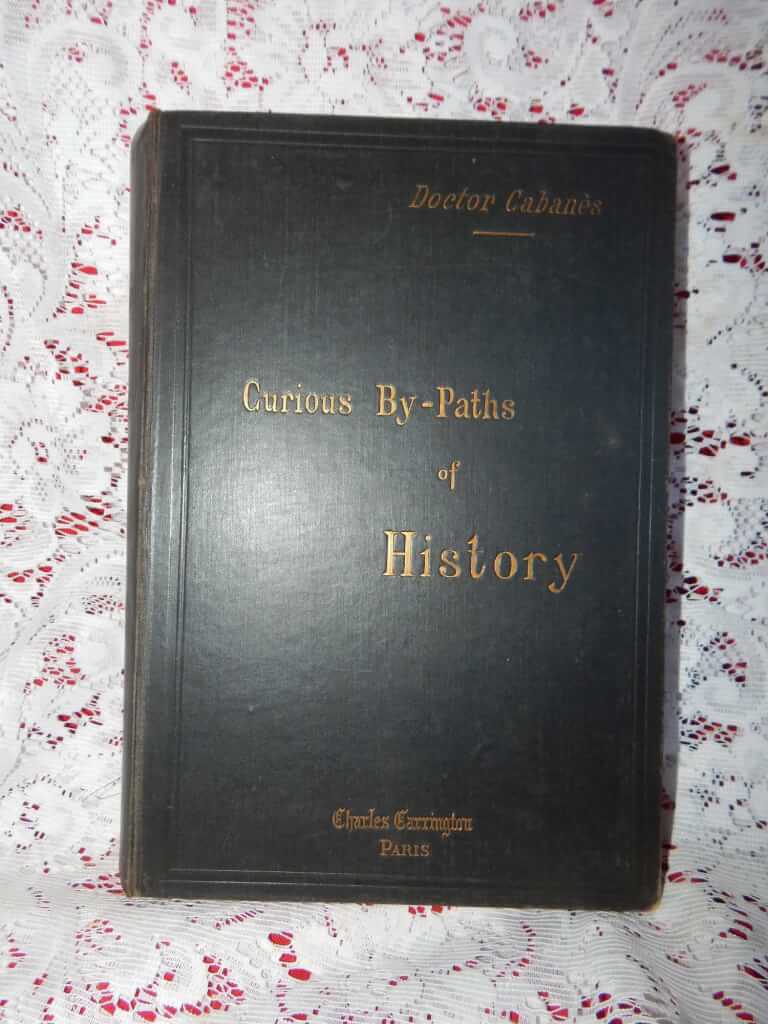
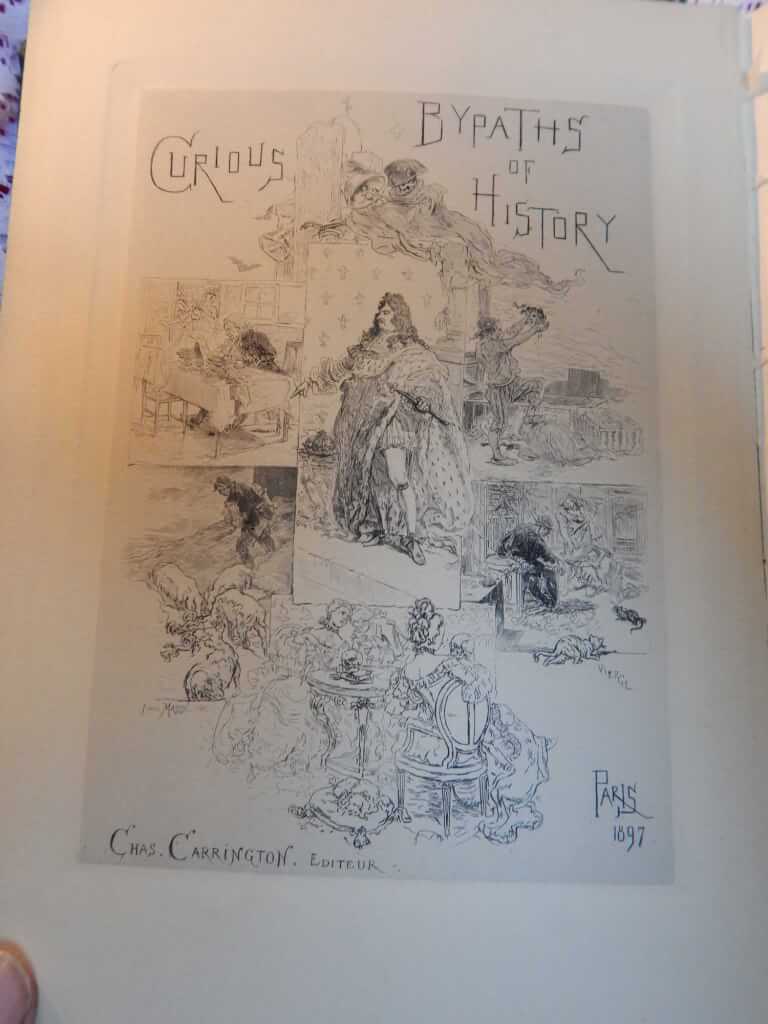 Curious Bypaths of History: Being Medico-Historical Studies and Observations, by Dr. [Augustin] Cabanès, frontispiece by Daniel Vierge engraved on copper by F. Massé (Librairie Des Bibliophiles, Charles Carrington, Éditeur, Paris 1898, #238/500) 7"x10", xx+367pp, black cloth with gilt titles on cover and spine (spine titles faded), front boards loose but holding, marbled endpapers, printed on "Van Gelder's vellum paper", gilt top edge, other edges deckled. Charles Carrington published a series of 3 books looking into the private lives of the French aristocracy titled, "Pathological studies of the past". The books are Secret Cabinet of History Peeped into By a Doctor (1897), Curious Bypaths of History: Being Medico-Historical Studies and Observations (1898), Flagellation in France from a medical and historical standpoint (1898). The first two and possibly the third were written by Dr. Augustin Cabanès (1862-1928), a French doctor, historian and author. Contents of this book, Curious Bypaths of History, include: The Teeth of Louis Xi, The Clandestine Accouchements of Mdlle De La Valliere (Louise de La Vallière was a mistress of Louis XIV of France from 1661 to 1667.), Illustrious Remains And Anatomical Relics. — the Skeleton of Mme De Maintenon And the Skull of Mme De Sevigne, The Infirmities of Sophie Arnould (a very popular French operatic soprano), Was Dr. Guillotin the Inventor Or the God-Father, of the Guillotine?, the Real Charlotte Corday. — Her Personal Appearance (Marie-Anne Charlotte de Corday d'Armont was a figure of the French Revolution. In 1793, she was executed by guillotine for the assassination of Jacobin leader Jean-Paul Marat, who was in part responsible for the more radical course the Revolution had taken through his role as a politician and journalist.), The Superstitions of Napoleon I, A Romance With Three Actors: Alfred De Musset, George Sand, And Doctor Pagello.
Curious Bypaths of History: Being Medico-Historical Studies and Observations, by Dr. [Augustin] Cabanès, frontispiece by Daniel Vierge engraved on copper by F. Massé (Librairie Des Bibliophiles, Charles Carrington, Éditeur, Paris 1898, #238/500) 7"x10", xx+367pp, black cloth with gilt titles on cover and spine (spine titles faded), front boards loose but holding, marbled endpapers, printed on "Van Gelder's vellum paper", gilt top edge, other edges deckled. Charles Carrington published a series of 3 books looking into the private lives of the French aristocracy titled, "Pathological studies of the past". The books are Secret Cabinet of History Peeped into By a Doctor (1897), Curious Bypaths of History: Being Medico-Historical Studies and Observations (1898), Flagellation in France from a medical and historical standpoint (1898). The first two and possibly the third were written by Dr. Augustin Cabanès (1862-1928), a French doctor, historian and author. Contents of this book, Curious Bypaths of History, include: The Teeth of Louis Xi, The Clandestine Accouchements of Mdlle De La Valliere (Louise de La Vallière was a mistress of Louis XIV of France from 1661 to 1667.), Illustrious Remains And Anatomical Relics. — the Skeleton of Mme De Maintenon And the Skull of Mme De Sevigne, The Infirmities of Sophie Arnould (a very popular French operatic soprano), Was Dr. Guillotin the Inventor Or the God-Father, of the Guillotine?, the Real Charlotte Corday. — Her Personal Appearance (Marie-Anne Charlotte de Corday d'Armont was a figure of the French Revolution. In 1793, she was executed by guillotine for the assassination of Jacobin leader Jean-Paul Marat, who was in part responsible for the more radical course the Revolution had taken through his role as a politician and journalist.), The Superstitions of Napoleon I, A Romance With Three Actors: Alfred De Musset, George Sand, And Doctor Pagello. -
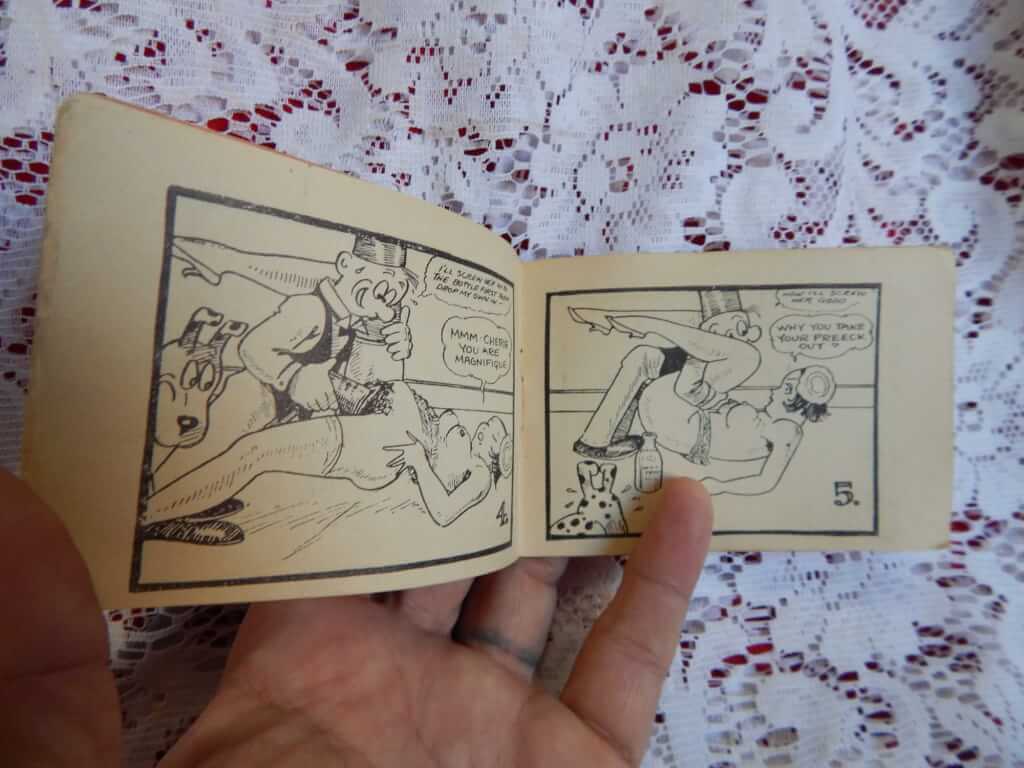
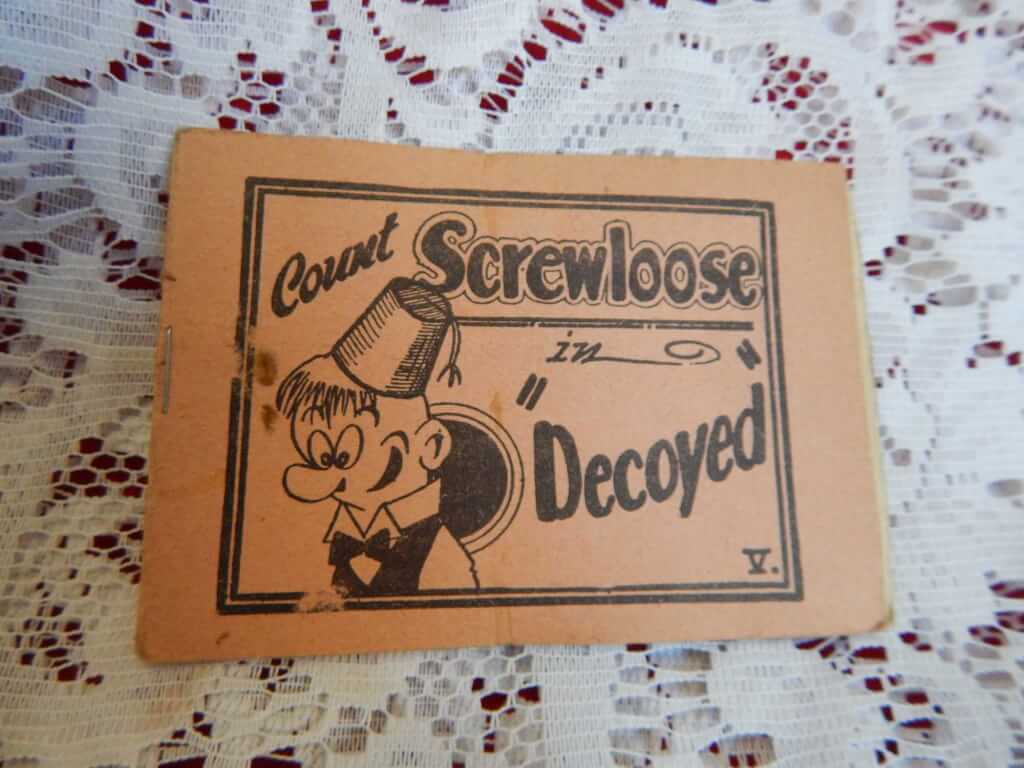 Count Screwloose in "Decoyed", (n.p. n.d.) 4.5" x 3", 8pp. pamphlet, stapled Tijuana bibles (also known as eight-pagers, bluesies, gray-backs, Jiggs-and-Maggie books, jo-jo books, Tillie-and-Mac books, and two-by-fours) were little pornographic comic books produced in the United States from the 1920s to the early 1960s.
Count Screwloose in "Decoyed", (n.p. n.d.) 4.5" x 3", 8pp. pamphlet, stapled Tijuana bibles (also known as eight-pagers, bluesies, gray-backs, Jiggs-and-Maggie books, jo-jo books, Tillie-and-Mac books, and two-by-fours) were little pornographic comic books produced in the United States from the 1920s to the early 1960s. -

 Confessions of a Lady's Waiting Maid: being a true record of her marvelous adventures in both hemispheres, Fanny Beresford [Charles Paul de Kock (probably pseudonyms of George Thompson)] (J. H. Farrell, New York, nd [1848]) 9.5" X 5.75", 340pp, original soft covers, back cover missing, front cover and original orange paper front illustration page detached. Top and bottom edges untrimmed. Poor condition but for the age in good shape for a cheaply made and well read paperback. A museum piece. This is a very rare surviving paperback from the publisher Jeremiah H. Farrell. One of three main publishers of erotica of the time, According to Comstock (famous New York prosecutor of obscenity) "Farrell published about 109 different books. He had been at it about sixteen years, at the time of his death in 1873." The story was written by George Thompson who was the most prolific author of American erotica of the mid-nineteenth century, who got his start in Boston and later relocated to New York. Thompson wrote under numerous pseudonyms. The name of Charles Paul de Kock (a popular French novelist of the time) was a popular pseudonym of erotic work in America for obvious reasons.
Confessions of a Lady's Waiting Maid: being a true record of her marvelous adventures in both hemispheres, Fanny Beresford [Charles Paul de Kock (probably pseudonyms of George Thompson)] (J. H. Farrell, New York, nd [1848]) 9.5" X 5.75", 340pp, original soft covers, back cover missing, front cover and original orange paper front illustration page detached. Top and bottom edges untrimmed. Poor condition but for the age in good shape for a cheaply made and well read paperback. A museum piece. This is a very rare surviving paperback from the publisher Jeremiah H. Farrell. One of three main publishers of erotica of the time, According to Comstock (famous New York prosecutor of obscenity) "Farrell published about 109 different books. He had been at it about sixteen years, at the time of his death in 1873." The story was written by George Thompson who was the most prolific author of American erotica of the mid-nineteenth century, who got his start in Boston and later relocated to New York. Thompson wrote under numerous pseudonyms. The name of Charles Paul de Kock (a popular French novelist of the time) was a popular pseudonym of erotic work in America for obvious reasons. -
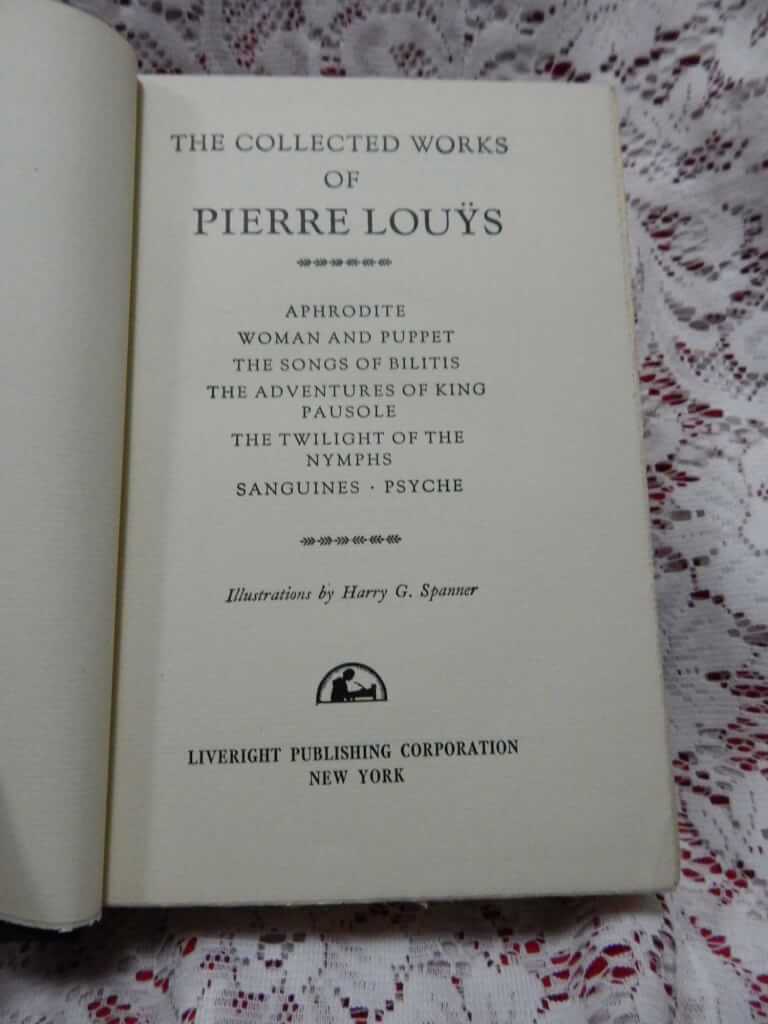
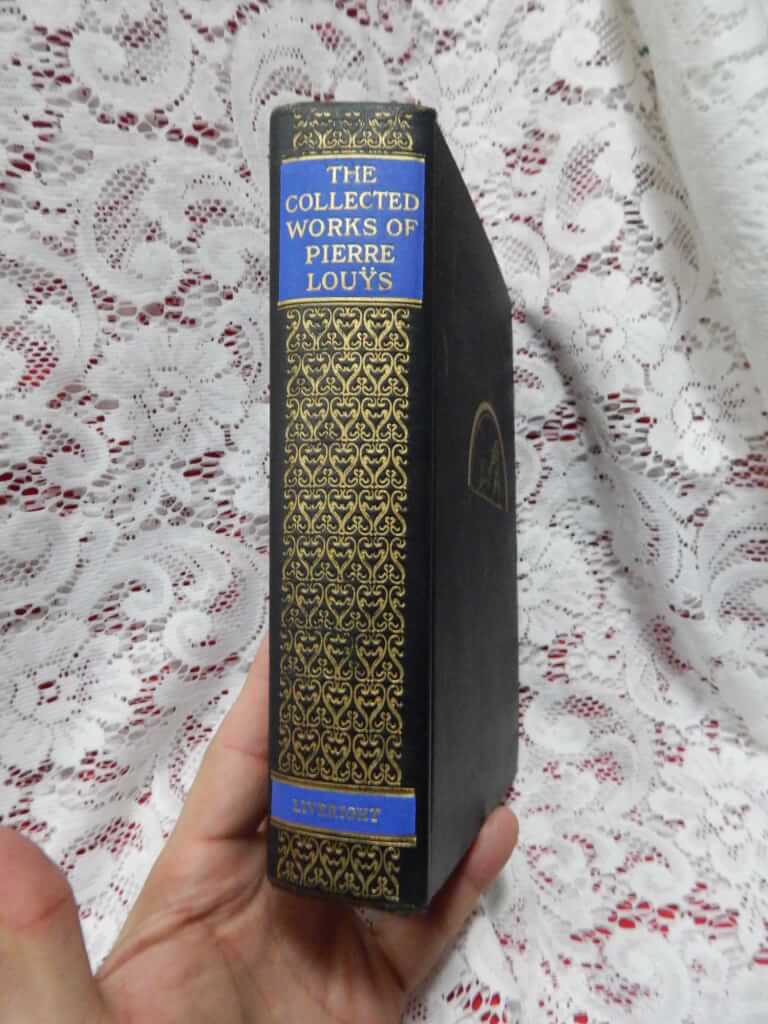 Collected Works of Pierre Louys, Aphrodite, Woman and Puppet, The Songs of Billitis, The Adventures of King Pausole, The Twilight of the Nymphs, Sanguines, Psyche, Pierre Louys, Illust. by Harry G. Spanner, trans. by Mitchell S. Buck (Liveright Publishing Corporation, New York, 1932) 5.75" X 7.75", xii+742pp., black boards with gilt nude on cover, gilt and blue titles and decorations on spine, top edge inked, other edges deckled, printed on fine hand-layed paper Pierre Louys (1870 - 1925) was a French poet and writer, most renowned for lesbian and classical themes in some of his writings. He is known as a writer who "expressed pagan sensuality with stylistic perfection." Mitchell Starrett Buck (February 10, 1887 – May 12, 1959) was an American poet, translator and classical scholar. His volumes of verse and prose poetry were deeply influenced by 1890s aestheticism as well as classical Greek and Roman Literature. Buck’s writing was secondary to his work as a heating engineer, and the money he made professionally allowed him to become a noted book-collector, specializing in first editions, English literature, Greek and Latin classics. Buck’s first book was a translation of Aphrodite by the French decadent Pierre Louÿs (1870-1925). It appeared in 1913, and was “privately printed”, probably at Buck’s expense. It may have been arranged through the Philadelphia bookseller Nicholas L. Brown, who officially became a publisher in 1916, and thereafter issued most of Buck’s output. Between 1916 and 1932, Brown published small editions of poetry, belles lettres, translations, sometimes without his imprint but stating that the title has been “issued privately for subscribers” (in order to evade prosecution for dealing in obscene materials). Such classical erotica is very tame by modern standards, but in the teens and twenties such material was policed by self-appointed authorities such as John S. Sumner of the New York Society for the Suppression of Vice.
Collected Works of Pierre Louys, Aphrodite, Woman and Puppet, The Songs of Billitis, The Adventures of King Pausole, The Twilight of the Nymphs, Sanguines, Psyche, Pierre Louys, Illust. by Harry G. Spanner, trans. by Mitchell S. Buck (Liveright Publishing Corporation, New York, 1932) 5.75" X 7.75", xii+742pp., black boards with gilt nude on cover, gilt and blue titles and decorations on spine, top edge inked, other edges deckled, printed on fine hand-layed paper Pierre Louys (1870 - 1925) was a French poet and writer, most renowned for lesbian and classical themes in some of his writings. He is known as a writer who "expressed pagan sensuality with stylistic perfection." Mitchell Starrett Buck (February 10, 1887 – May 12, 1959) was an American poet, translator and classical scholar. His volumes of verse and prose poetry were deeply influenced by 1890s aestheticism as well as classical Greek and Roman Literature. Buck’s writing was secondary to his work as a heating engineer, and the money he made professionally allowed him to become a noted book-collector, specializing in first editions, English literature, Greek and Latin classics. Buck’s first book was a translation of Aphrodite by the French decadent Pierre Louÿs (1870-1925). It appeared in 1913, and was “privately printed”, probably at Buck’s expense. It may have been arranged through the Philadelphia bookseller Nicholas L. Brown, who officially became a publisher in 1916, and thereafter issued most of Buck’s output. Between 1916 and 1932, Brown published small editions of poetry, belles lettres, translations, sometimes without his imprint but stating that the title has been “issued privately for subscribers” (in order to evade prosecution for dealing in obscene materials). Such classical erotica is very tame by modern standards, but in the teens and twenties such material was policed by self-appointed authorities such as John S. Sumner of the New York Society for the Suppression of Vice. -
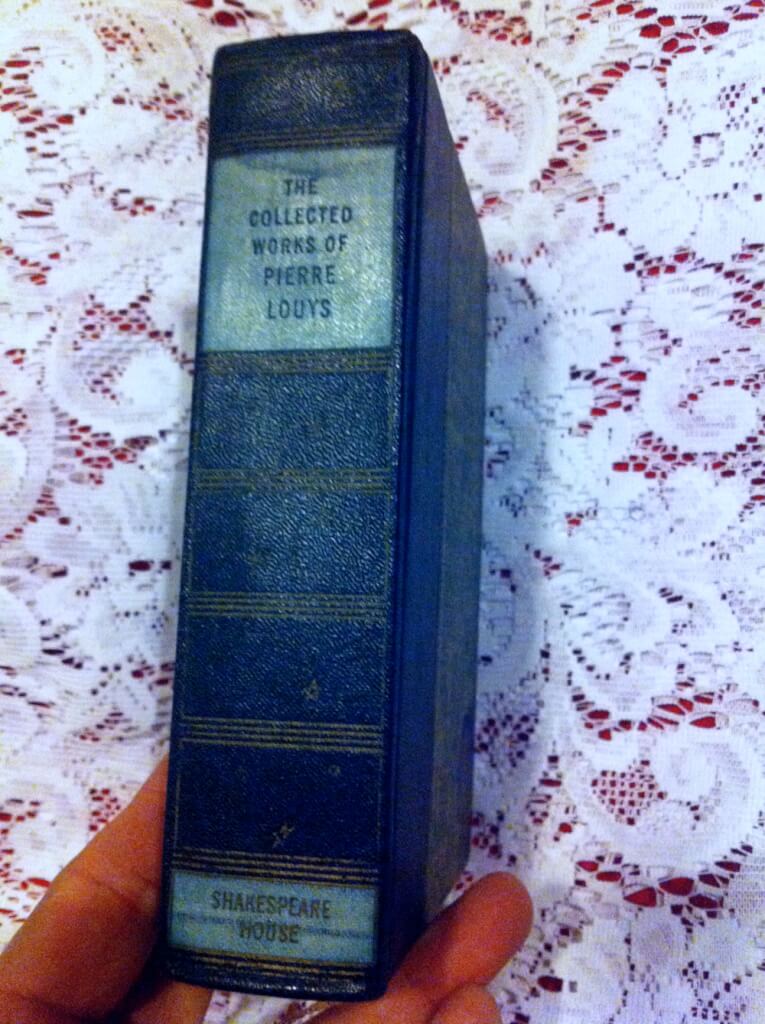
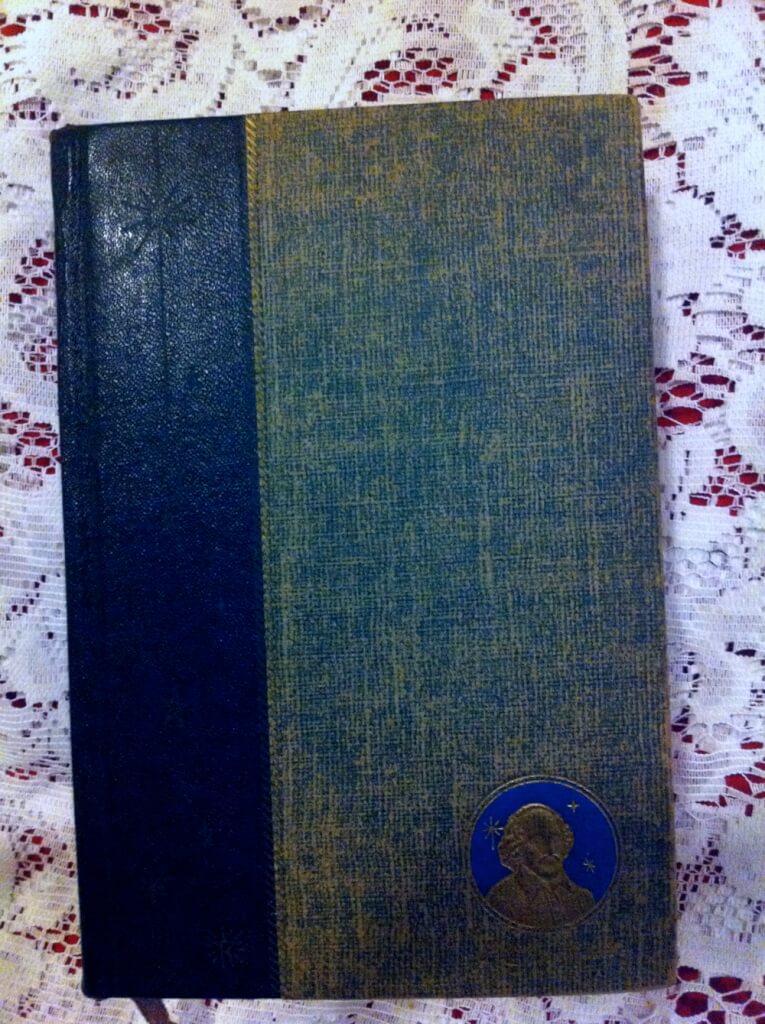 Collected Works of Pierre Louys, Pierre Louys (Shakespeare House, New York, 1951) 6.75" X 4.5", 628pp., hardbound in blue-grey buckram boards with simulated leather spine, gilt decorations (portrait of Shakespear) on cover. Fine condition, ribbon intact. Pierre Louys (1870 - 1925) was a French poet and writer, most renowned for lesbian and classical themes in some of his writings. He is known as a writer who "expressed pagan sensuality with stylistic perfection." This is a collection which contains Aphrodite, The Songs of Bilitis, The Adventures of King Pausole, and 9 of his short stories.
Collected Works of Pierre Louys, Pierre Louys (Shakespeare House, New York, 1951) 6.75" X 4.5", 628pp., hardbound in blue-grey buckram boards with simulated leather spine, gilt decorations (portrait of Shakespear) on cover. Fine condition, ribbon intact. Pierre Louys (1870 - 1925) was a French poet and writer, most renowned for lesbian and classical themes in some of his writings. He is known as a writer who "expressed pagan sensuality with stylistic perfection." This is a collection which contains Aphrodite, The Songs of Bilitis, The Adventures of King Pausole, and 9 of his short stories. -
Out of stock

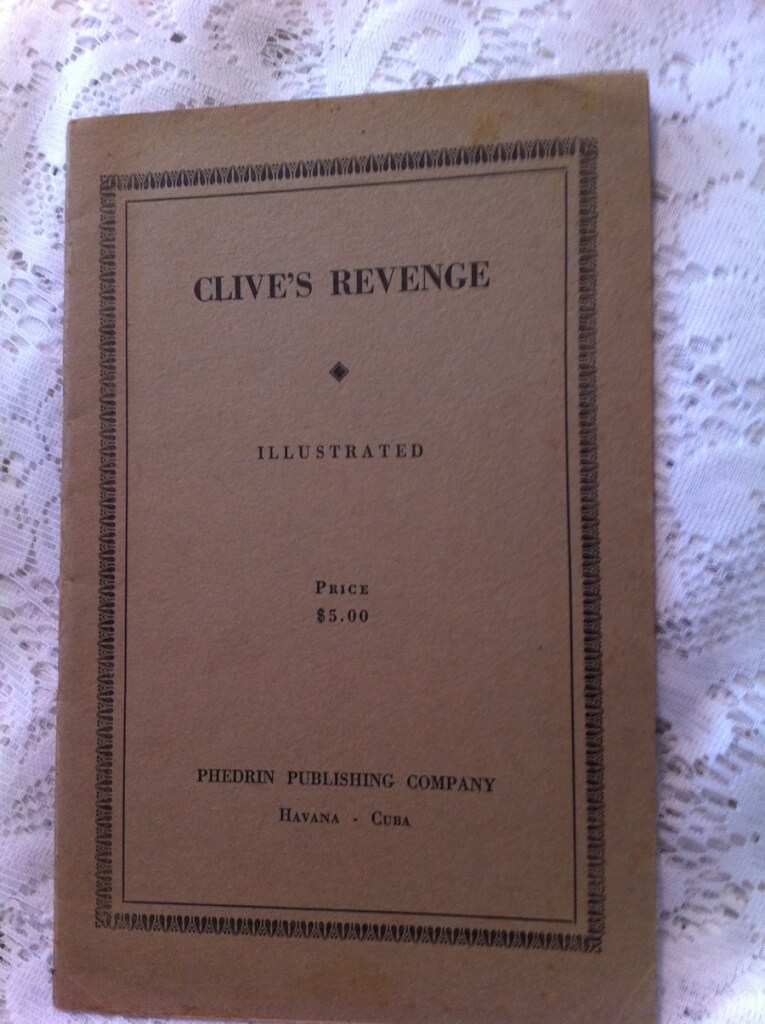 Clives Revenge, (Phedrin Publishing Company, Havana, Cuba) 8.25" x 5.5", 32pp., pamphlet, good condition
Clives Revenge, (Phedrin Publishing Company, Havana, Cuba) 8.25" x 5.5", 32pp., pamphlet, good condition -
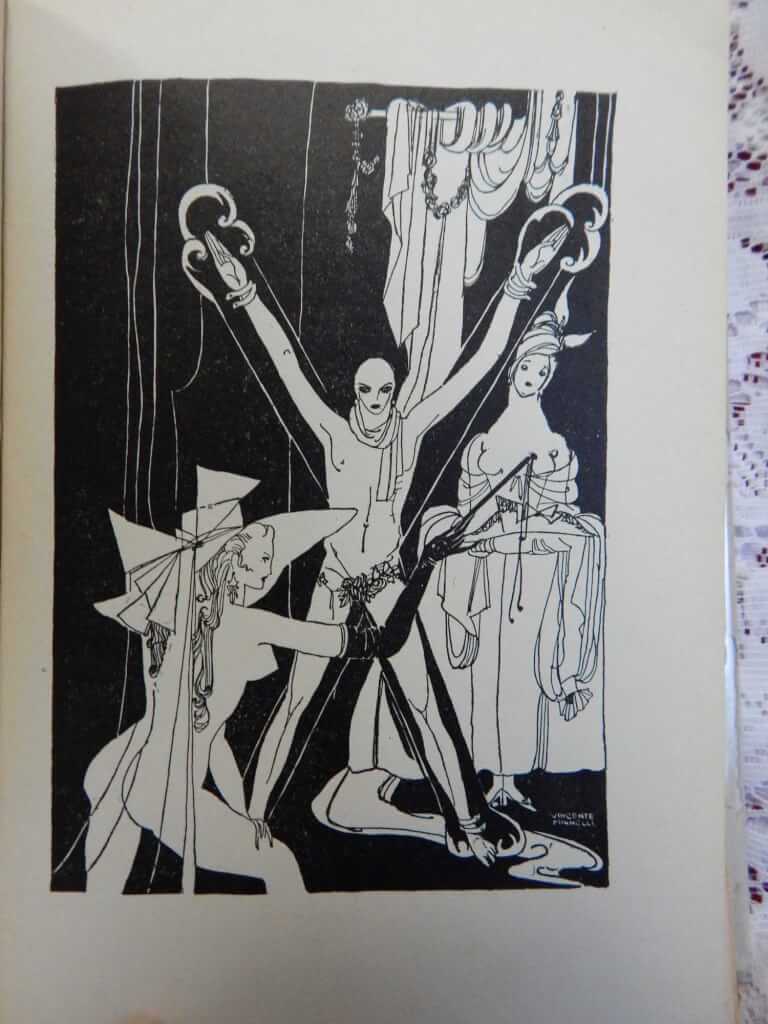
 Casanova's Memoirs, by Casanova, Ed. Joseph Monét, illus. Vincente Minnilli (Willey Book Company, New York, 1946) 6.25"x9.25", 290pp, mylar protected DJ with some rips and tears over red boards with gilt lettering, boards loose but holding Giovanni Giacomo Casanova (1725-1798) was an ecclesiastic, writer, soldier, spy, and diplomatist, chiefly remembered as the prince of Italian adventurers and as the man who made the name Casanova synonymous with "libertine." His autobiography, which perhaps exaggerates some of his escapades, is a splendid description of 18th-century society in the capitals of Europe. As far as I can tell this is the only illustration work done by Vincente Minnelli [obscure at the time but later famous director and husband of Judy Garland]. It was done soon after he moved to New York from Chicago and before he landed a steady job at Radio City Music Hall. In his autobiography he described the work as "in the Aubrey Beardsley style".
Casanova's Memoirs, by Casanova, Ed. Joseph Monét, illus. Vincente Minnilli (Willey Book Company, New York, 1946) 6.25"x9.25", 290pp, mylar protected DJ with some rips and tears over red boards with gilt lettering, boards loose but holding Giovanni Giacomo Casanova (1725-1798) was an ecclesiastic, writer, soldier, spy, and diplomatist, chiefly remembered as the prince of Italian adventurers and as the man who made the name Casanova synonymous with "libertine." His autobiography, which perhaps exaggerates some of his escapades, is a splendid description of 18th-century society in the capitals of Europe. As far as I can tell this is the only illustration work done by Vincente Minnelli [obscure at the time but later famous director and husband of Judy Garland]. It was done soon after he moved to New York from Chicago and before he landed a steady job at Radio City Music Hall. In his autobiography he described the work as "in the Aubrey Beardsley style". -
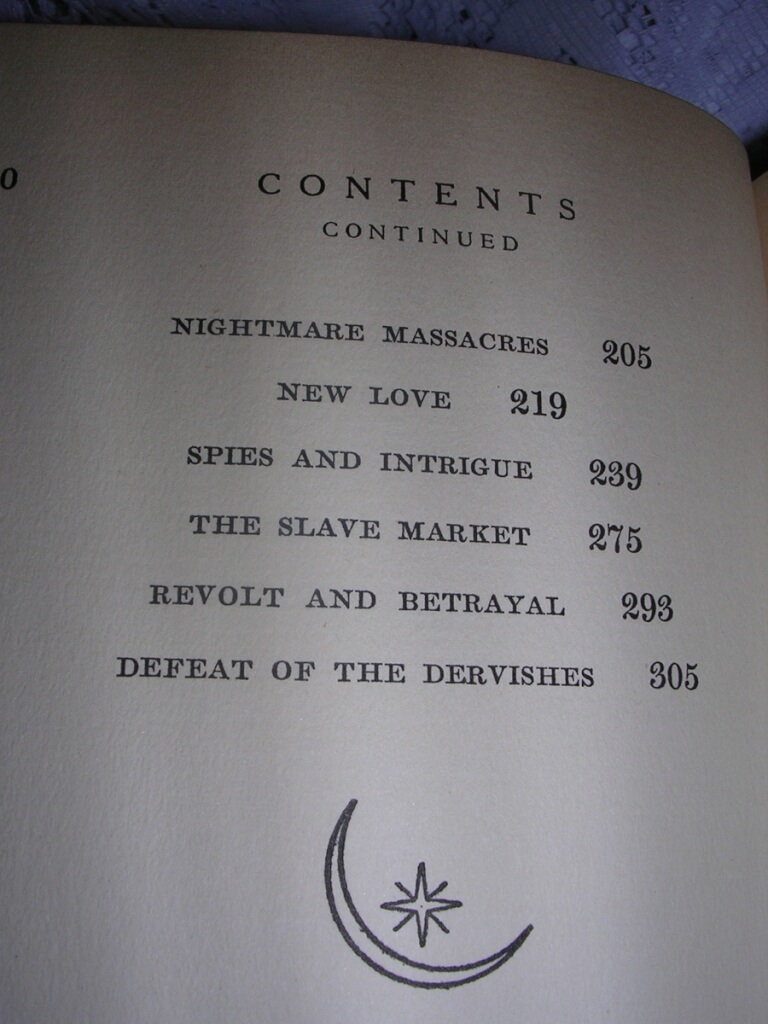
 Black Lust, Jean de Villiot [George Grassal (Hugues Rebell)] (Privately printed by The Panurge Press, Inc., New York, 1931, #365/2000) 8 5/8" X 6", 312pp, hardbound no DJ, cream cloth boards with black stamped decorations, top edge dyed blue, other edges deckle, good condition, slight soiling to boards, binding tight Jean de Villiot was a pseudonym used by several authors and compilers working for the publisher Charles Carrington writing novels and "studies" concerning flagellation, including Hugues Rebell (Georges Grassal), Hector France, Stéphane Arnoulin and Charles Carrington, himself. This novel is attributed to George Grassal (Hugues Rebell) originally written in French, in 1902, as "La Femme et son maître" (The Woman and her Master). In 1904 "Woman and her Master" was published in English by Charles Carrington. Panurge Press published this work as "Black Lust" in 1931. This book is a numbered limited edition copy of the Panurge Press edition.
Black Lust, Jean de Villiot [George Grassal (Hugues Rebell)] (Privately printed by The Panurge Press, Inc., New York, 1931, #365/2000) 8 5/8" X 6", 312pp, hardbound no DJ, cream cloth boards with black stamped decorations, top edge dyed blue, other edges deckle, good condition, slight soiling to boards, binding tight Jean de Villiot was a pseudonym used by several authors and compilers working for the publisher Charles Carrington writing novels and "studies" concerning flagellation, including Hugues Rebell (Georges Grassal), Hector France, Stéphane Arnoulin and Charles Carrington, himself. This novel is attributed to George Grassal (Hugues Rebell) originally written in French, in 1902, as "La Femme et son maître" (The Woman and her Master). In 1904 "Woman and her Master" was published in English by Charles Carrington. Panurge Press published this work as "Black Lust" in 1931. This book is a numbered limited edition copy of the Panurge Press edition. -
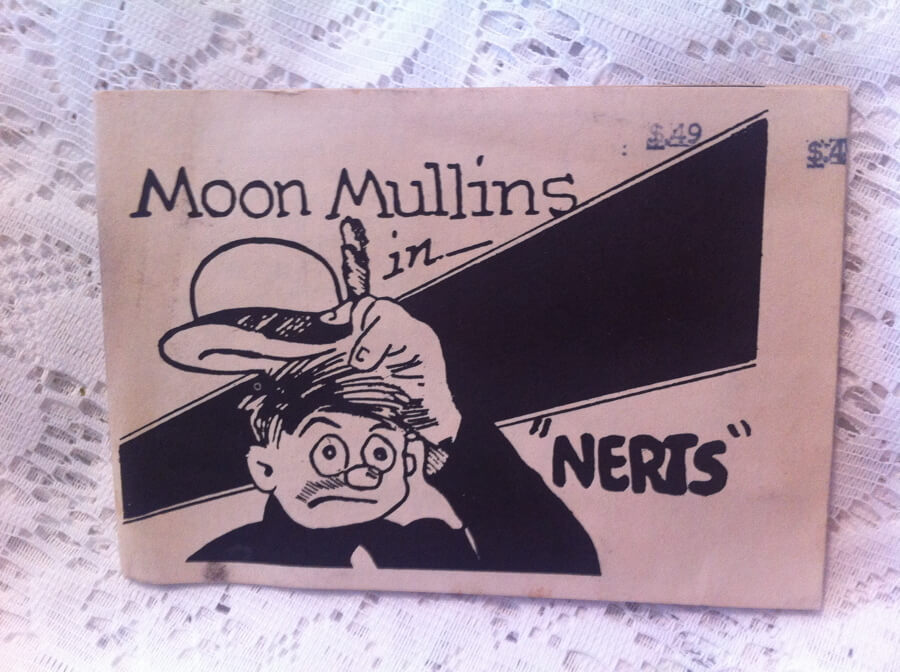
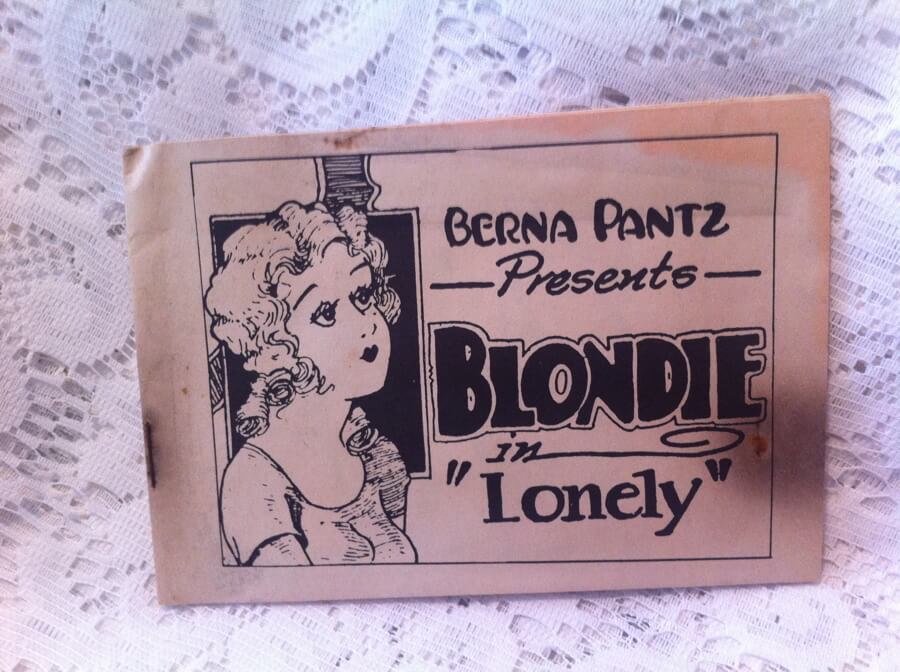 Berna Pantz Presents Blondie in "Lonely" / Moon Mullins in "Nerts", (n.p., n.d.) 5" x 3.5", 8pp. double pamphlet, stapled Tijuana bibles (also known as eight-pagers, bluesies, gray-backs, Jiggs-and-Maggie books, jo-jo books, Tillie-and-Mac books, and two-by-fours) were little pornographic comic books produced in the United States from the 1920s to the early 1960s. This book is two books in one, featuring reprints of the originals printed on both sides of the paper. Flip the book over and it's a different book.
Berna Pantz Presents Blondie in "Lonely" / Moon Mullins in "Nerts", (n.p., n.d.) 5" x 3.5", 8pp. double pamphlet, stapled Tijuana bibles (also known as eight-pagers, bluesies, gray-backs, Jiggs-and-Maggie books, jo-jo books, Tillie-and-Mac books, and two-by-fours) were little pornographic comic books produced in the United States from the 1920s to the early 1960s. This book is two books in one, featuring reprints of the originals printed on both sides of the paper. Flip the book over and it's a different book. -
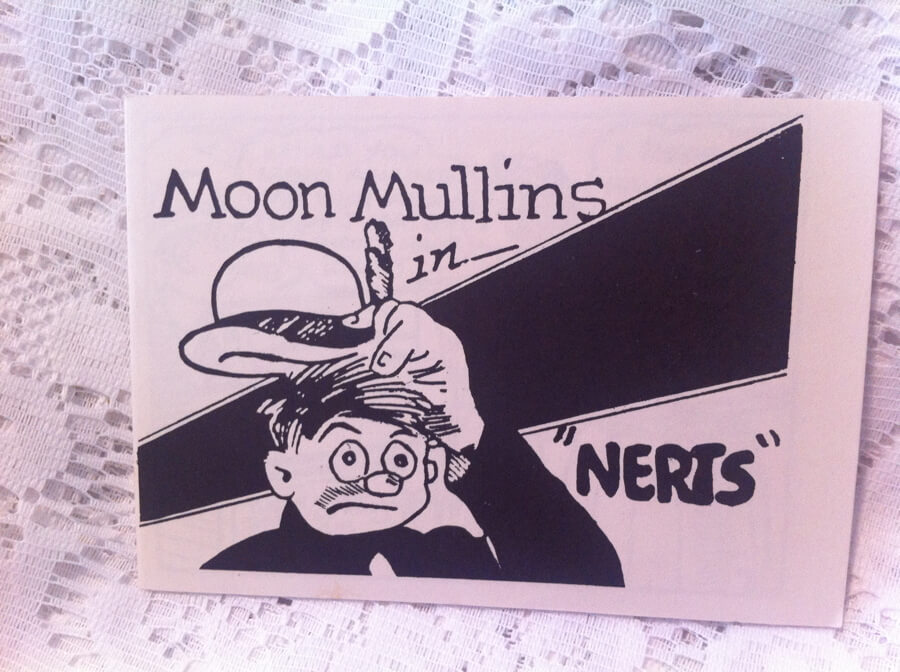
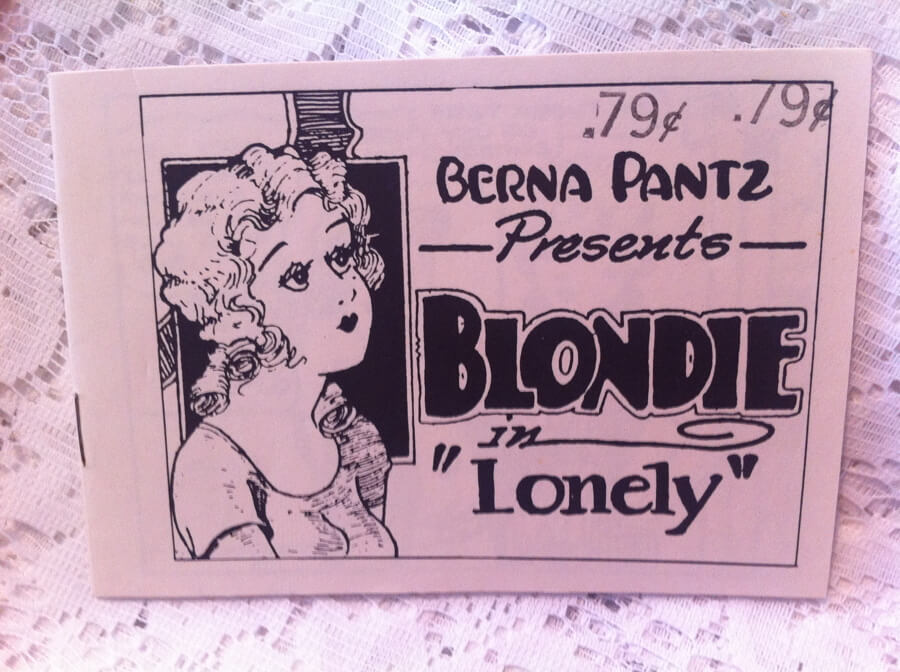 Berna Pantz Presents Blondie in "Lonely" / Moon Mullins in "Nerts", (n.p., n.d.) 5" x 3.5", 8pp. double pamphlet, stapled Tijuana bibles (also known as eight-pagers, bluesies, gray-backs, Jiggs-and-Maggie books, jo-jo books, Tillie-and-Mac books, and two-by-fours) were little pornographic comic books produced in the United States from the 1920s to the early 1960s. This book is two books in one, featuring reprints of the originals printed on both sides of the paper. Flip the book over and it's a different book.
Berna Pantz Presents Blondie in "Lonely" / Moon Mullins in "Nerts", (n.p., n.d.) 5" x 3.5", 8pp. double pamphlet, stapled Tijuana bibles (also known as eight-pagers, bluesies, gray-backs, Jiggs-and-Maggie books, jo-jo books, Tillie-and-Mac books, and two-by-fours) were little pornographic comic books produced in the United States from the 1920s to the early 1960s. This book is two books in one, featuring reprints of the originals printed on both sides of the paper. Flip the book over and it's a different book. -
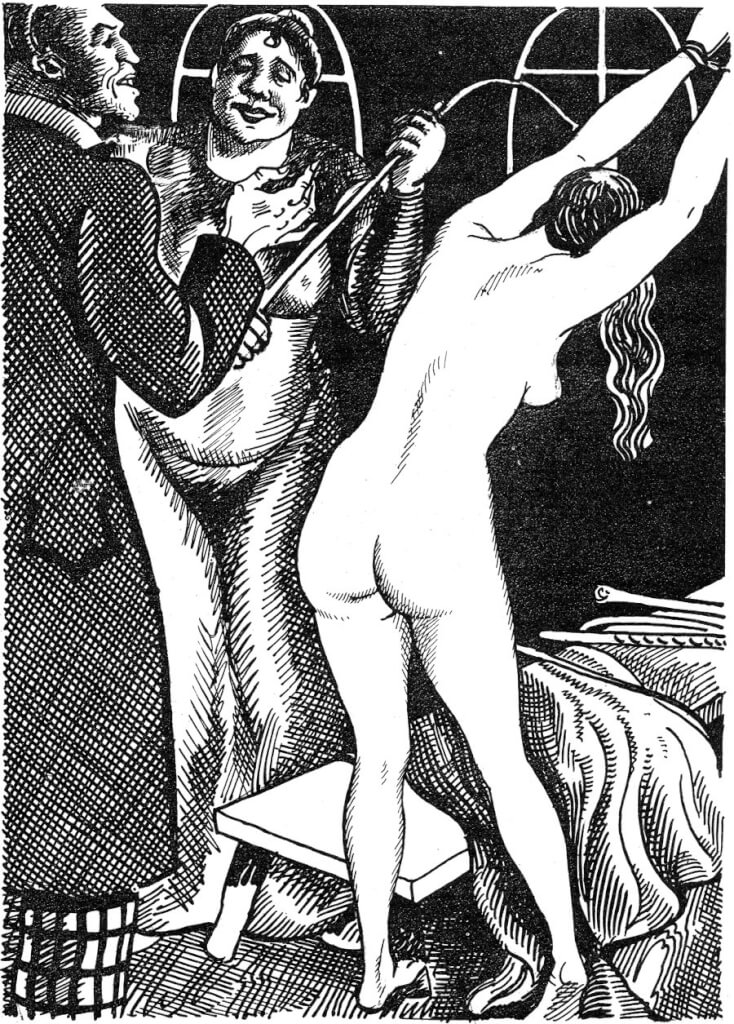 Before Caning, artist unknown Print from: Nell in Bridewell: Description of the System of Corporal Punishment (Flagellation) in the Female Prisons of South Germany up to the year 1848 W. Reinhard, trans. W.C. Costello Ph. D. and A. R. Allinson M. A. (Psych Press [New York], 1932) Image: 7" x 10", high-resolution ink-jet print Paper: 8.5" x 11", 65lb White paper
Before Caning, artist unknown Print from: Nell in Bridewell: Description of the System of Corporal Punishment (Flagellation) in the Female Prisons of South Germany up to the year 1848 W. Reinhard, trans. W.C. Costello Ph. D. and A. R. Allinson M. A. (Psych Press [New York], 1932) Image: 7" x 10", high-resolution ink-jet print Paper: 8.5" x 11", 65lb White paper -
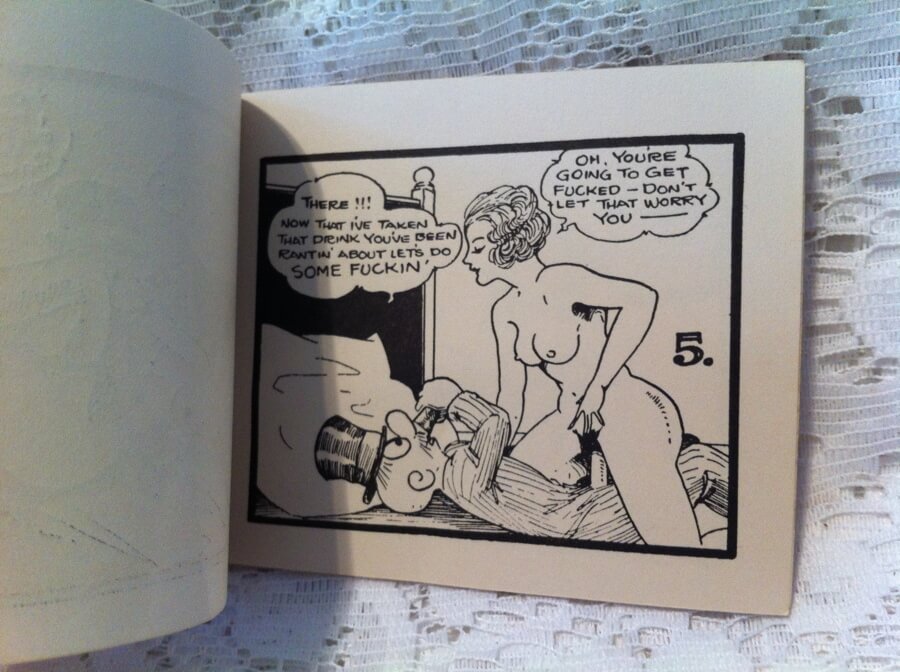
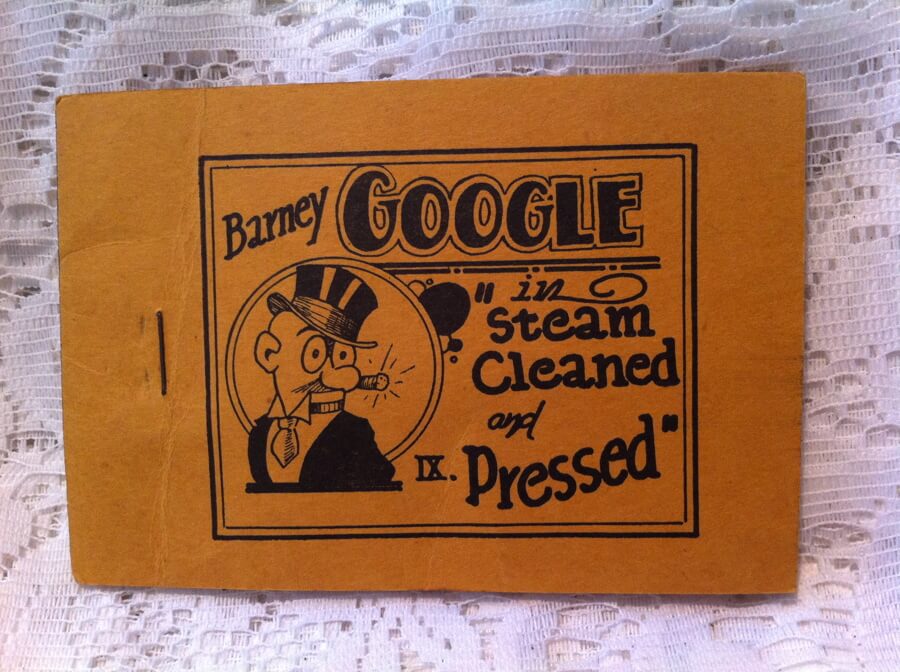 Barney Google in "Steam Cleaned and Pressed", (n.p. n.d.) 4.5" x 3", 8pp. pamphlet, stapled Tijuana bibles (also known as eight-pagers, bluesies, gray-backs, Jiggs-and-Maggie books, jo-jo books, Tillie-and-Mac books, and two-by-fours) were little pornographic comic books produced in the United States from the 1920s to the early 1960s. This parodies "Barney Google and Snuffy Smith" an widely read (even today) comic strip that has been around since 1919.
Barney Google in "Steam Cleaned and Pressed", (n.p. n.d.) 4.5" x 3", 8pp. pamphlet, stapled Tijuana bibles (also known as eight-pagers, bluesies, gray-backs, Jiggs-and-Maggie books, jo-jo books, Tillie-and-Mac books, and two-by-fours) were little pornographic comic books produced in the United States from the 1920s to the early 1960s. This parodies "Barney Google and Snuffy Smith" an widely read (even today) comic strip that has been around since 1919. -
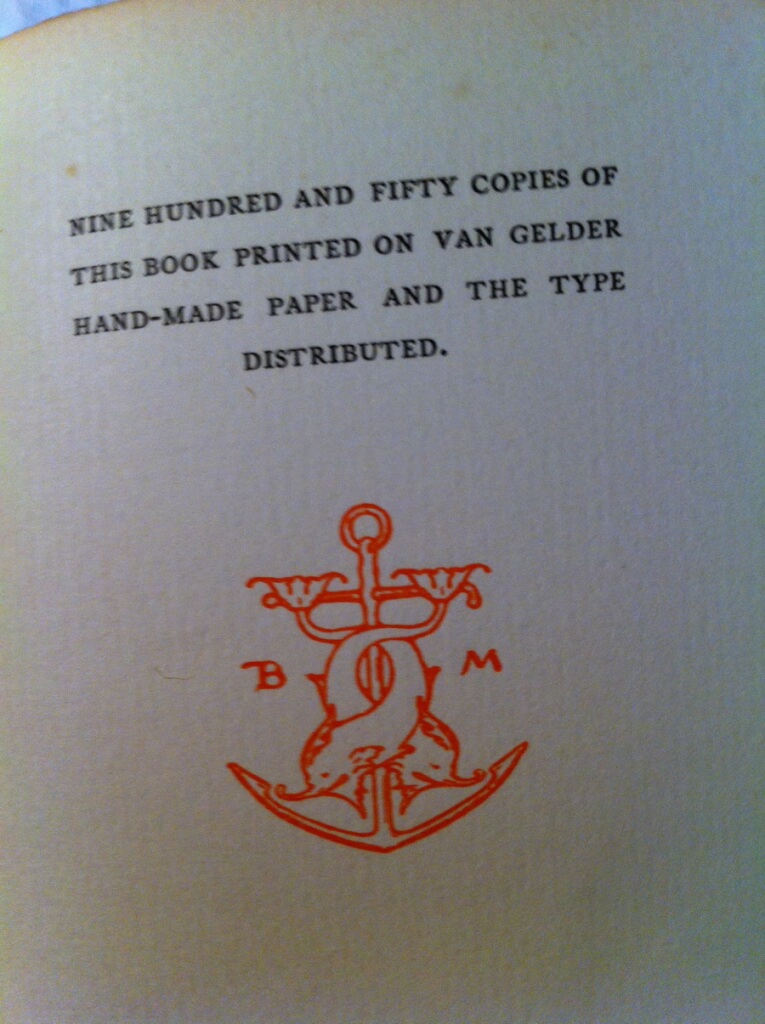
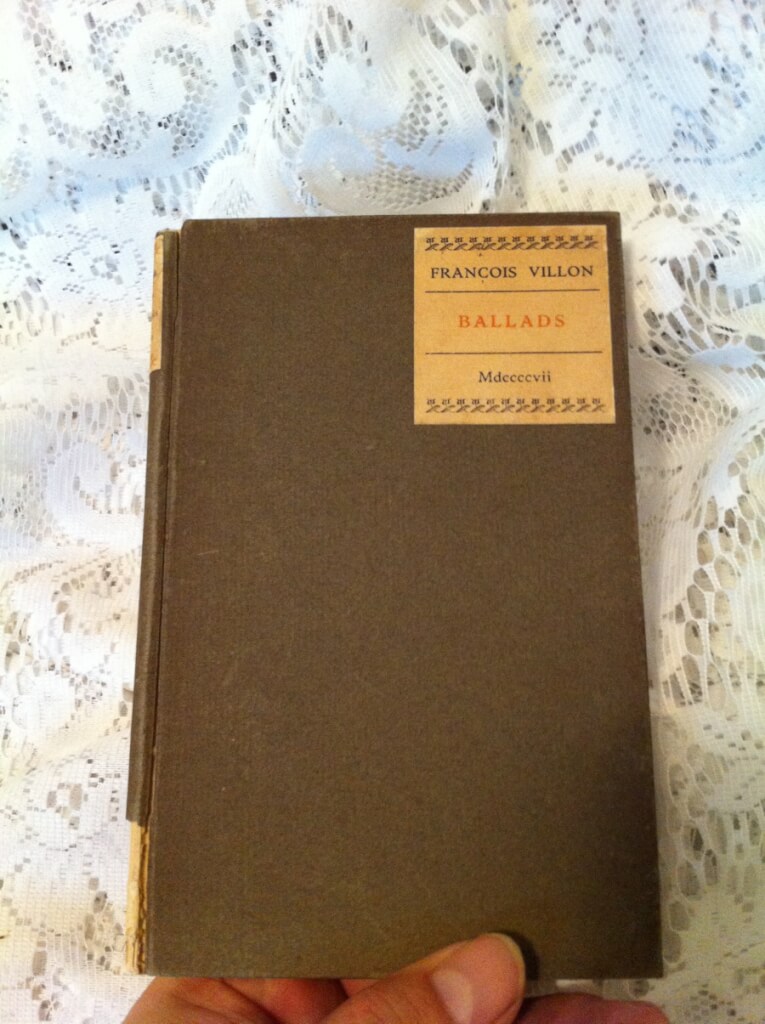 Ballands Done Into English from the French of Francois Villon, Francois Villon (Thomas B. Mosher, 1907) 7" X 4.5", 43pp, hardbound, grey boards with paper labels on cover and spine. Fair condition for age, spine loose on one side but holding, hinges good, fore and bottom edges deckled, owner's signatures on front pastedown François Villon (c. 1431_1464) was a French poet. Most of what is known about Villon has been gathered from legal records and gleaned from his own writings. He was a thief, killer, barroom brawler, and vagabond. He is perhaps best known for his Testaments and his Ballades. He was the most famous realist poet of the Middle Ages.
Ballands Done Into English from the French of Francois Villon, Francois Villon (Thomas B. Mosher, 1907) 7" X 4.5", 43pp, hardbound, grey boards with paper labels on cover and spine. Fair condition for age, spine loose on one side but holding, hinges good, fore and bottom edges deckled, owner's signatures on front pastedown François Villon (c. 1431_1464) was a French poet. Most of what is known about Villon has been gathered from legal records and gleaned from his own writings. He was a thief, killer, barroom brawler, and vagabond. He is perhaps best known for his Testaments and his Ballades. He was the most famous realist poet of the Middle Ages. -
 Aristophanes: Lysistrata, Aristophanes, illus. by Aubrey Beardsley (Beardsley Press, 1927, one of 750 unnumbered) 8.25″ x 11.5″, 99pp, quarter silver over black cloth, with silver and black patterned endpapers, black lettering to spine, good condition for age, bumping and scraping present, Beardsley’s prints are tipped in. Aristophanes was the greatest writer of ancient Athenian “old comedy,” known for its satires of contemporary life and for its broad, often obscene humor. Lysistrata was first produced in 411 BC, when the Peloponnesian War had been devastating Greece for 20 years. Most people know the plot: Lysistrata assembles women from all of Greece, and they agree that they will not have sex until the men make peace. Aubrey Beardsley was the greatest and the most controversial Art Nouveau illustrator in England, famous for his illustrations of Mallory’s Morte d’Arthur, Oscar Wilde’s Salome, Pope’s The Rape of the Lock, and for several magazines. Because he was associated with Oscar Wilde, Beardsley lost his job as art editor of a magazine named The Yellow Book in 1895, soon after Wilde was arrested for homosexuality. He was approached by Leonard Smithers, a publisher of erotic books, who asked him to illustrate Lysistrata. His illustrations are very much in the spirit of Aristophanes, as funny as they are obscene. Beardsley converted to Catholicism in 1897, and soon after, he asked Smithers to “destroy all copies of Lysistrata” with its “obscene drawings,” but Smithers refused. Beardsley died of tuberculosis in 1898, at the age of 26. Smithers initially published Lysistrata in a limited edition of one hundred copies. It was occasionally reprinted in very small runs, usually clandestinely, often poorly, but copies have long been scarce and expensive. Few copies of Beardsley’s Lysistrata printed before 1966 are currently in circulation. This copy is a rare limited edition printed by the Beardsley Press, London and even rarer with the binding intact.
Aristophanes: Lysistrata, Aristophanes, illus. by Aubrey Beardsley (Beardsley Press, 1927, one of 750 unnumbered) 8.25″ x 11.5″, 99pp, quarter silver over black cloth, with silver and black patterned endpapers, black lettering to spine, good condition for age, bumping and scraping present, Beardsley’s prints are tipped in. Aristophanes was the greatest writer of ancient Athenian “old comedy,” known for its satires of contemporary life and for its broad, often obscene humor. Lysistrata was first produced in 411 BC, when the Peloponnesian War had been devastating Greece for 20 years. Most people know the plot: Lysistrata assembles women from all of Greece, and they agree that they will not have sex until the men make peace. Aubrey Beardsley was the greatest and the most controversial Art Nouveau illustrator in England, famous for his illustrations of Mallory’s Morte d’Arthur, Oscar Wilde’s Salome, Pope’s The Rape of the Lock, and for several magazines. Because he was associated with Oscar Wilde, Beardsley lost his job as art editor of a magazine named The Yellow Book in 1895, soon after Wilde was arrested for homosexuality. He was approached by Leonard Smithers, a publisher of erotic books, who asked him to illustrate Lysistrata. His illustrations are very much in the spirit of Aristophanes, as funny as they are obscene. Beardsley converted to Catholicism in 1897, and soon after, he asked Smithers to “destroy all copies of Lysistrata” with its “obscene drawings,” but Smithers refused. Beardsley died of tuberculosis in 1898, at the age of 26. Smithers initially published Lysistrata in a limited edition of one hundred copies. It was occasionally reprinted in very small runs, usually clandestinely, often poorly, but copies have long been scarce and expensive. Few copies of Beardsley’s Lysistrata printed before 1966 are currently in circulation. This copy is a rare limited edition printed by the Beardsley Press, London and even rarer with the binding intact. -
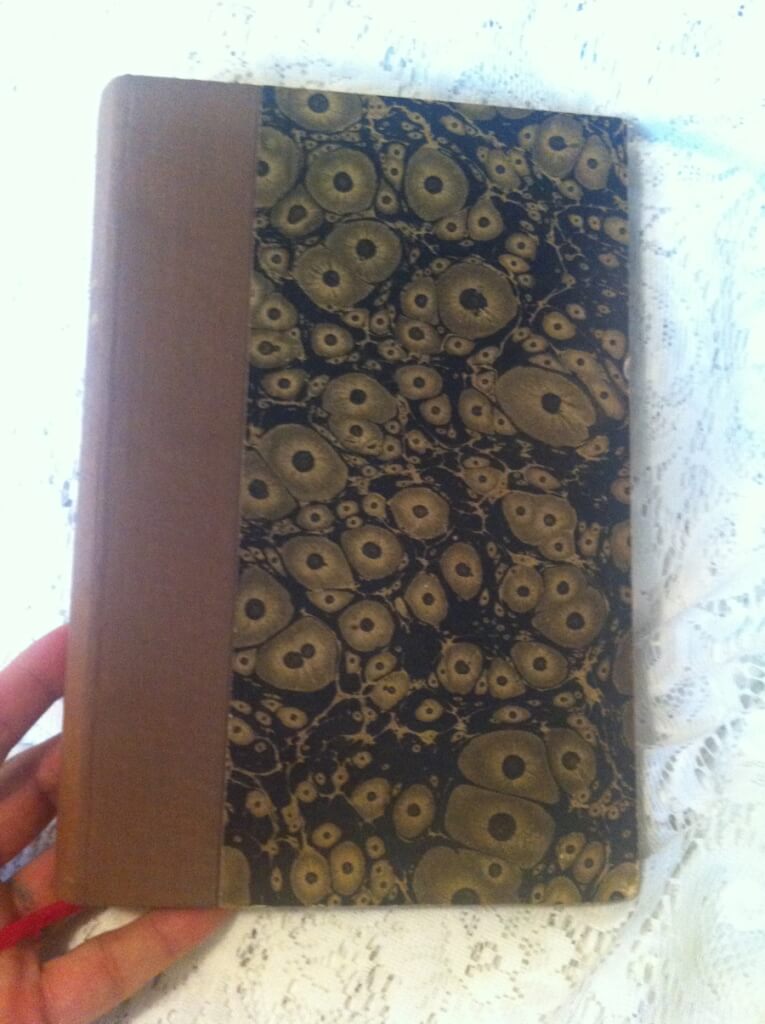
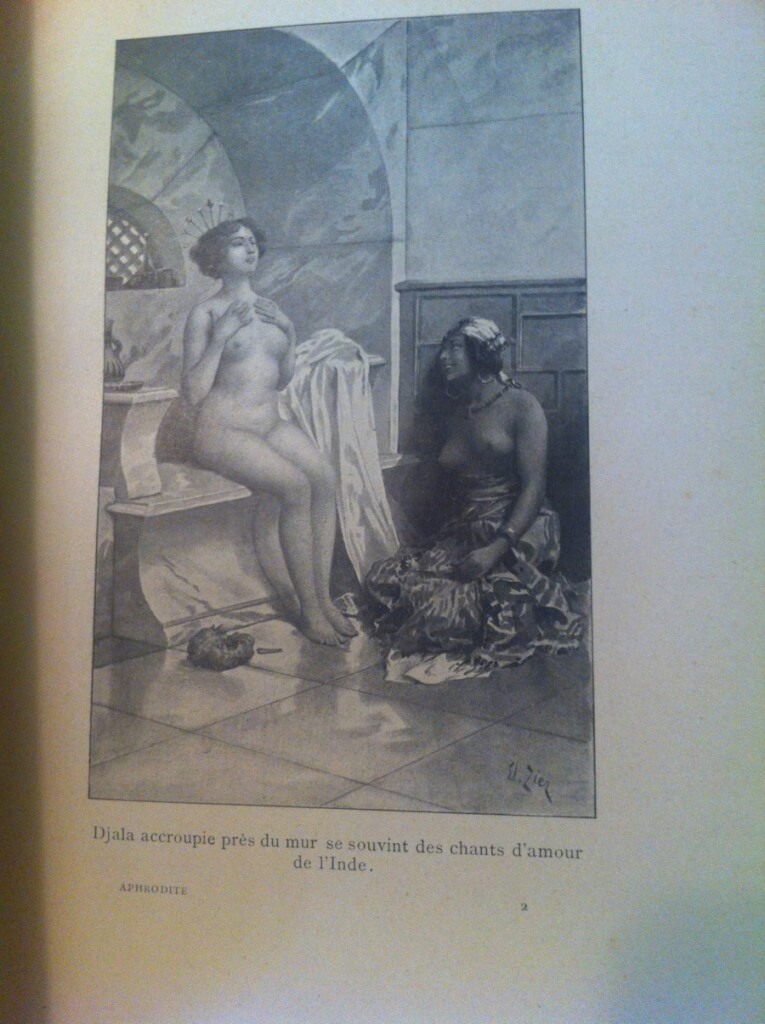 Aphrodite, mœurs antiques, by Pierre Louÿs, illus. Eduard Zier (Librairie Illustree, J. Tallandier, Éditeur, nd [c. 1900], Paris, printed by Charles Hérissey, engravings executed by Ruckert et Cie, on Champon, Bichelberger et Cie ) 6.75" x 10", 374pp, hardbound in half buckram over marbled boards, very good condition for age, some bumping to boards and foxing throughout pages, red ribbon intact Pierre Louys (1870 - 1925) was a French poet and writer, most renowned for lesbian and classical themes in some of his writings. He is known as a writer who "expressed pagan sensuality with stylistic perfection." "Aphrodite: mæurs antiques" (Ancient Manners) is a "libertine" story set in ancient Alexandria. Highlights include the loves of Chrysis, an orgy banquet ending in the crucifixion of a slave, the love of two young musician girls and the festivals of Aphrodite.
Aphrodite, mœurs antiques, by Pierre Louÿs, illus. Eduard Zier (Librairie Illustree, J. Tallandier, Éditeur, nd [c. 1900], Paris, printed by Charles Hérissey, engravings executed by Ruckert et Cie, on Champon, Bichelberger et Cie ) 6.75" x 10", 374pp, hardbound in half buckram over marbled boards, very good condition for age, some bumping to boards and foxing throughout pages, red ribbon intact Pierre Louys (1870 - 1925) was a French poet and writer, most renowned for lesbian and classical themes in some of his writings. He is known as a writer who "expressed pagan sensuality with stylistic perfection." "Aphrodite: mæurs antiques" (Ancient Manners) is a "libertine" story set in ancient Alexandria. Highlights include the loves of Chrysis, an orgy banquet ending in the crucifixion of a slave, the love of two young musician girls and the festivals of Aphrodite. -
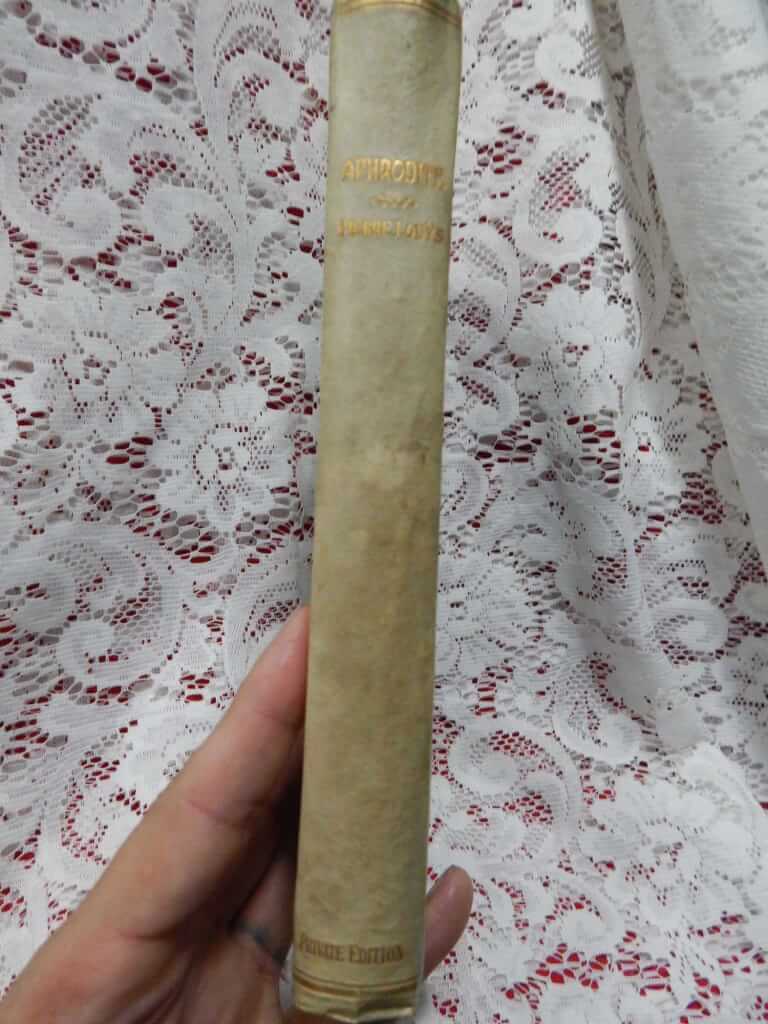
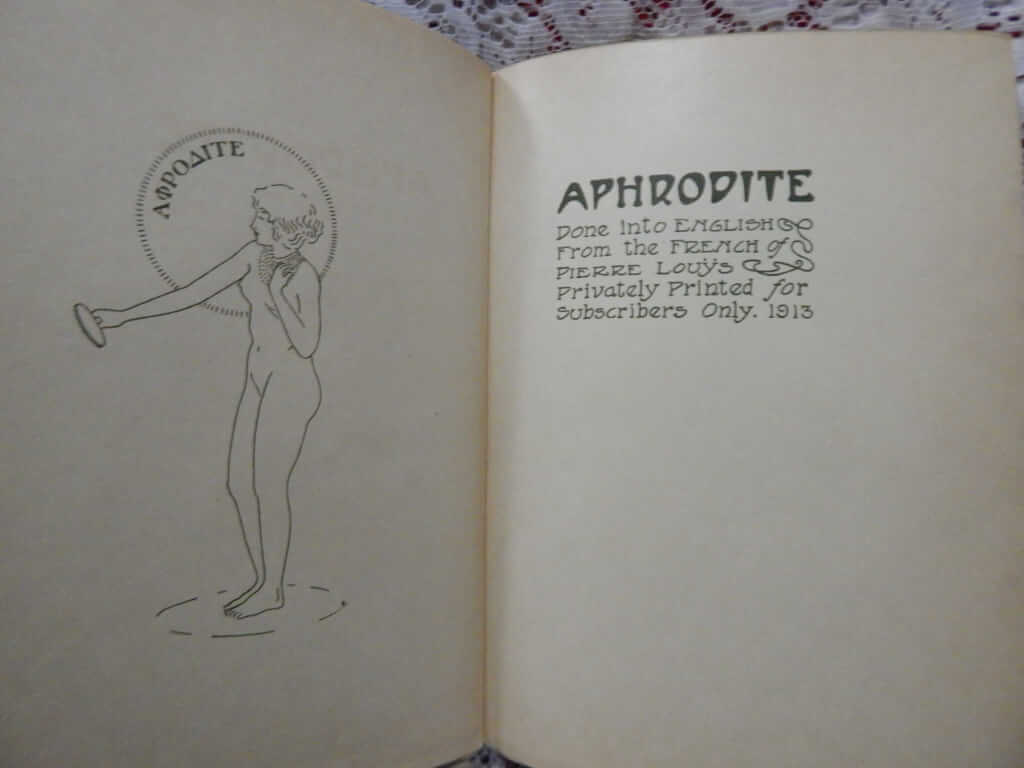 Aphrodite, done into English from the French of Pierre Louys, by Pierre Louÿs, illus. unknown, (Privately Printed for Subscribers Only[Mitchell S. Buck], 1913, #66/550) 6.5"x8.75", xi+258pp+Notes+Index, cream vellum spine over green boards, gilt titles on spine, good condition, some bumping and rubbing Buck's translation is easier to read than Carrington's translation a few years earlier. This was his first book, most likely, self-published and printed by Nicholas L. Brown. Pierre Louys (1870 - 1925) was a French poet and writer, most renowned for lesbian and classical themes in some of his writings. He is known as a writer who "expressed pagan sensuality with stylistic perfection." "Aphrodite: mæurs antiques" (Ancient Manners) is a "libertine" story set in ancient Alexandria. Highlights include the loves of Chrysis, an orgy banquet ending in the crucifixion of a slave, the love of two young musician girls and the festivals of Aphrodite." Mitchell Starrett Buck (February 10, 1887 – May 12, 1959) was an American poet, translator and classical scholar. His volumes of verse and prose poetry were deeply influenced by 1890s aestheticism as well as classical Greek and Roman Literature. Buck’s writing was secondary to his work as a heating engineer, and the money he made professionally allowed him to become a noted book-collector, specializing in first editions, English literature, Greek and Latin classics. Buck’s first book was a translation of Aphrodite by the French decadent Pierre Louÿs (1870-1925). It appeared in 1913, and was “privately printed”, probably at Buck’s expense. It may have been arranged through the Philadelphia bookseller Nicholas L. Brown, who officially became a publisher in 1916, and thereafter issued most of Buck’s output. Between 1916 and 1932, Brown published small editions of poetry, belles lettres, translations, sometimes without his imprint but stating that the title has been “issued privately for subscribers” (in order to evade prosecution for dealing in obscene materials). Such classical erotica is very tame by modern standards, but in the teens and twenties such material was policed by self-appointed authorities such as John S. Sumner of the New York Society for the Suppression of Vice.
Aphrodite, done into English from the French of Pierre Louys, by Pierre Louÿs, illus. unknown, (Privately Printed for Subscribers Only[Mitchell S. Buck], 1913, #66/550) 6.5"x8.75", xi+258pp+Notes+Index, cream vellum spine over green boards, gilt titles on spine, good condition, some bumping and rubbing Buck's translation is easier to read than Carrington's translation a few years earlier. This was his first book, most likely, self-published and printed by Nicholas L. Brown. Pierre Louys (1870 - 1925) was a French poet and writer, most renowned for lesbian and classical themes in some of his writings. He is known as a writer who "expressed pagan sensuality with stylistic perfection." "Aphrodite: mæurs antiques" (Ancient Manners) is a "libertine" story set in ancient Alexandria. Highlights include the loves of Chrysis, an orgy banquet ending in the crucifixion of a slave, the love of two young musician girls and the festivals of Aphrodite." Mitchell Starrett Buck (February 10, 1887 – May 12, 1959) was an American poet, translator and classical scholar. His volumes of verse and prose poetry were deeply influenced by 1890s aestheticism as well as classical Greek and Roman Literature. Buck’s writing was secondary to his work as a heating engineer, and the money he made professionally allowed him to become a noted book-collector, specializing in first editions, English literature, Greek and Latin classics. Buck’s first book was a translation of Aphrodite by the French decadent Pierre Louÿs (1870-1925). It appeared in 1913, and was “privately printed”, probably at Buck’s expense. It may have been arranged through the Philadelphia bookseller Nicholas L. Brown, who officially became a publisher in 1916, and thereafter issued most of Buck’s output. Between 1916 and 1932, Brown published small editions of poetry, belles lettres, translations, sometimes without his imprint but stating that the title has been “issued privately for subscribers” (in order to evade prosecution for dealing in obscene materials). Such classical erotica is very tame by modern standards, but in the teens and twenties such material was policed by self-appointed authorities such as John S. Sumner of the New York Society for the Suppression of Vice. -
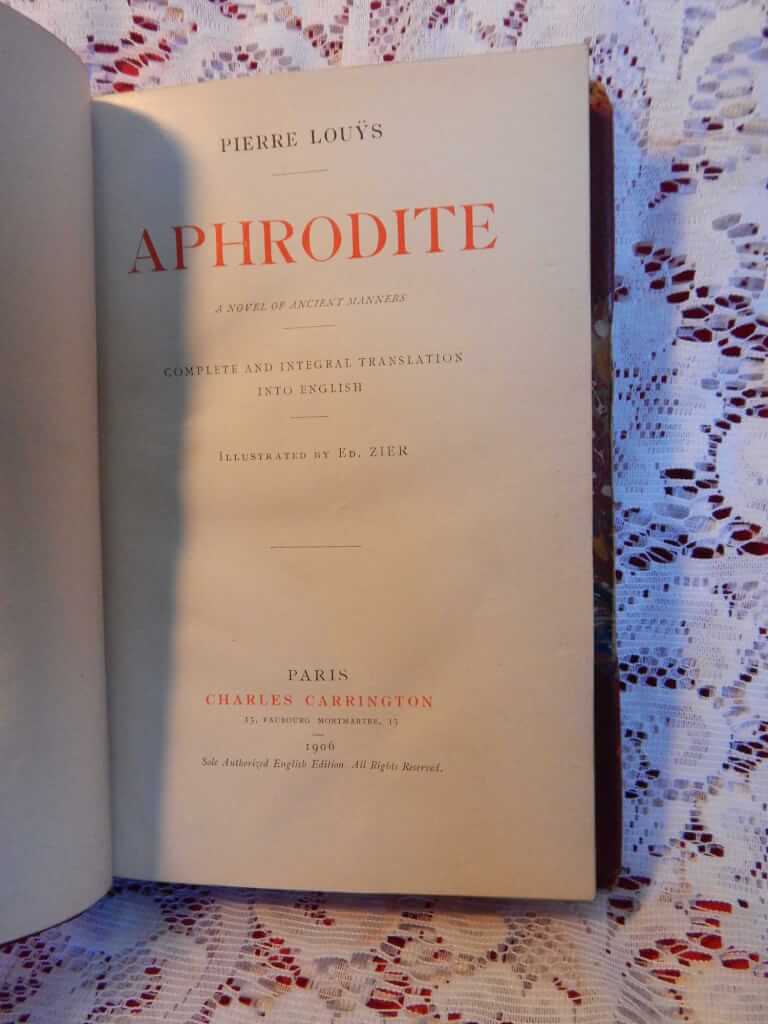
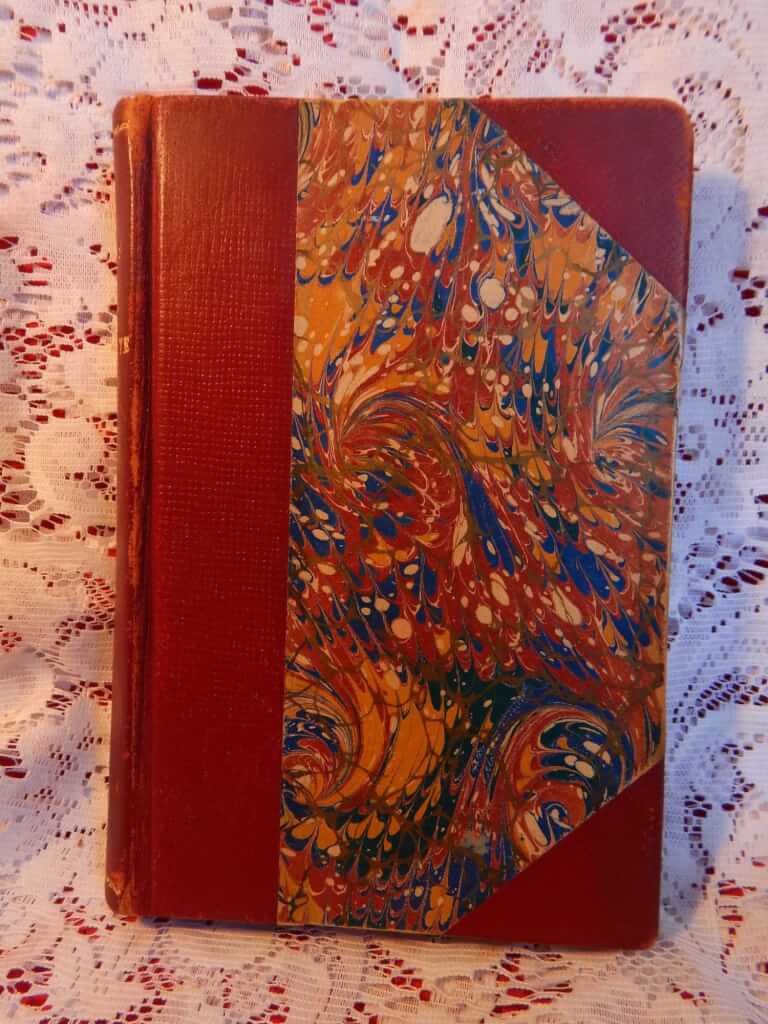 Aphrodite, a novel of ancient manners, by Pierre Louÿs, illus. Ed. Zier (Charles Carrington, 1906, first edition thus, first English translation) 5.25 x 8", 412pp, marbled boards with three quarter red cloth, gilt lettering and decoration on spine, very good condition for age, some slight bumping/scuffing Pierre Louys (1870 - 1925) was a French poet and writer, most renowned for lesbian and classical themes in some of his writings. He is known as a writer who "expressed pagan sensuality with stylistic perfection." "Aphrodite: mæurs antiques" (Ancient Manners) is a "libertine" story set in ancient Alexandria. Highlights include the loves of Chrysis, an orgy banquet ending in the crucifixion of a slave, the love of two young musician girls and the festivals of Aphrodite. "This Translation of Aphrodite was executed on the Printing Presses of Charles Herissey, at Evreux (France), for Mr. Charles Carrington, Paris, Bookseller et Publisher, and is the only complete English version extant." Édouard François Zier, (1856-1924) was a French illustrator and painter.
Aphrodite, a novel of ancient manners, by Pierre Louÿs, illus. Ed. Zier (Charles Carrington, 1906, first edition thus, first English translation) 5.25 x 8", 412pp, marbled boards with three quarter red cloth, gilt lettering and decoration on spine, very good condition for age, some slight bumping/scuffing Pierre Louys (1870 - 1925) was a French poet and writer, most renowned for lesbian and classical themes in some of his writings. He is known as a writer who "expressed pagan sensuality with stylistic perfection." "Aphrodite: mæurs antiques" (Ancient Manners) is a "libertine" story set in ancient Alexandria. Highlights include the loves of Chrysis, an orgy banquet ending in the crucifixion of a slave, the love of two young musician girls and the festivals of Aphrodite. "This Translation of Aphrodite was executed on the Printing Presses of Charles Herissey, at Evreux (France), for Mr. Charles Carrington, Paris, Bookseller et Publisher, and is the only complete English version extant." Édouard François Zier, (1856-1924) was a French illustrator and painter. -
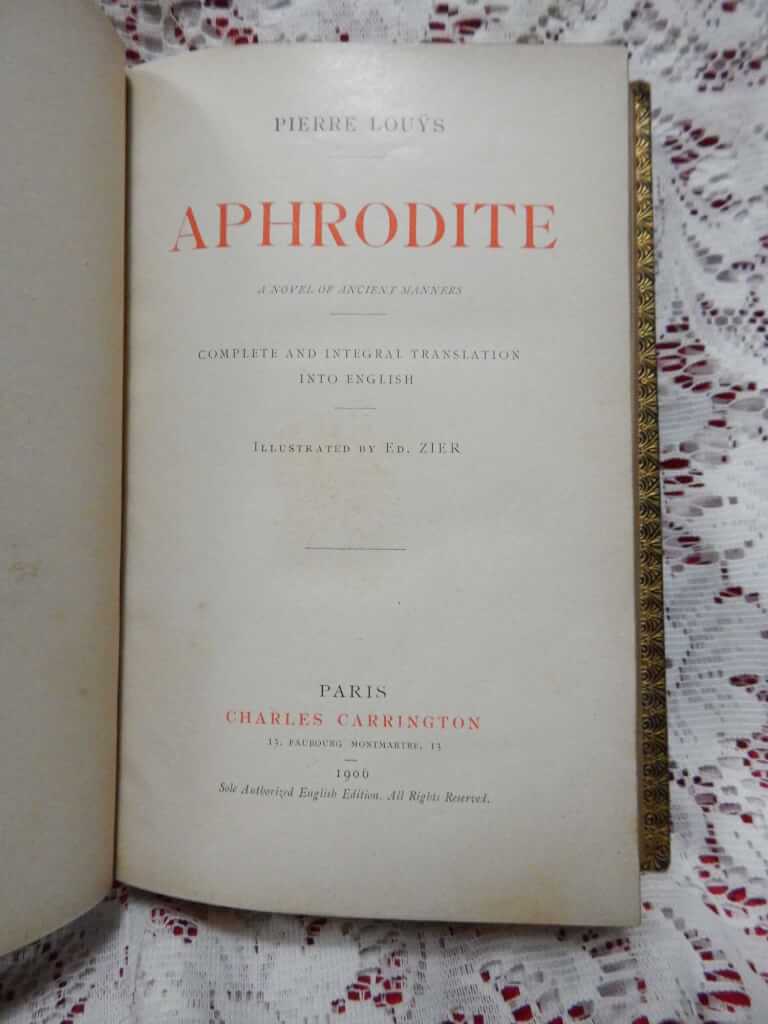
 Aphrodite, a novel of ancient manners, by Pierre Louÿs, illus. Ed. Zier (Charles Carrington, 1906, first edition thus, first English translation) 5.25 x 8", 412pp, full green moroccan, gilt lettering and decoration on spine and borders, 5 raised bands, gilt edges, gilt decorations boardering pastedown, near fine condition, some cracks in the hinges. Pierre Louys (1870 - 1925) was a French poet and writer, most renowned for lesbian and classical themes in some of his writings. He is known as a writer who "expressed pagan sensuality with stylistic perfection." "Aphrodite: mæurs antiques" (Ancient Manners) is a "libertine" story set in ancient Alexandria. Highlights include the loves of Chrysis, an orgy banquet ending in the crucifixion of a slave, the love of two young musician girls and the festivals of Aphrodite. "This Translation of Aphrodite was executed on the Printing Presses of Charles Herissey, at Evreux (France), for Mr. Charles Carrington, Paris, Bookseller et Publisher, and is the only complete English version extant." A beautiful example of this important first edition of the first translation. Very hard to find in full leather. Édouard François Zier (1856-1924) was a French illustrator and painter.
Aphrodite, a novel of ancient manners, by Pierre Louÿs, illus. Ed. Zier (Charles Carrington, 1906, first edition thus, first English translation) 5.25 x 8", 412pp, full green moroccan, gilt lettering and decoration on spine and borders, 5 raised bands, gilt edges, gilt decorations boardering pastedown, near fine condition, some cracks in the hinges. Pierre Louys (1870 - 1925) was a French poet and writer, most renowned for lesbian and classical themes in some of his writings. He is known as a writer who "expressed pagan sensuality with stylistic perfection." "Aphrodite: mæurs antiques" (Ancient Manners) is a "libertine" story set in ancient Alexandria. Highlights include the loves of Chrysis, an orgy banquet ending in the crucifixion of a slave, the love of two young musician girls and the festivals of Aphrodite. "This Translation of Aphrodite was executed on the Printing Presses of Charles Herissey, at Evreux (France), for Mr. Charles Carrington, Paris, Bookseller et Publisher, and is the only complete English version extant." A beautiful example of this important first edition of the first translation. Very hard to find in full leather. Édouard François Zier (1856-1924) was a French illustrator and painter. -
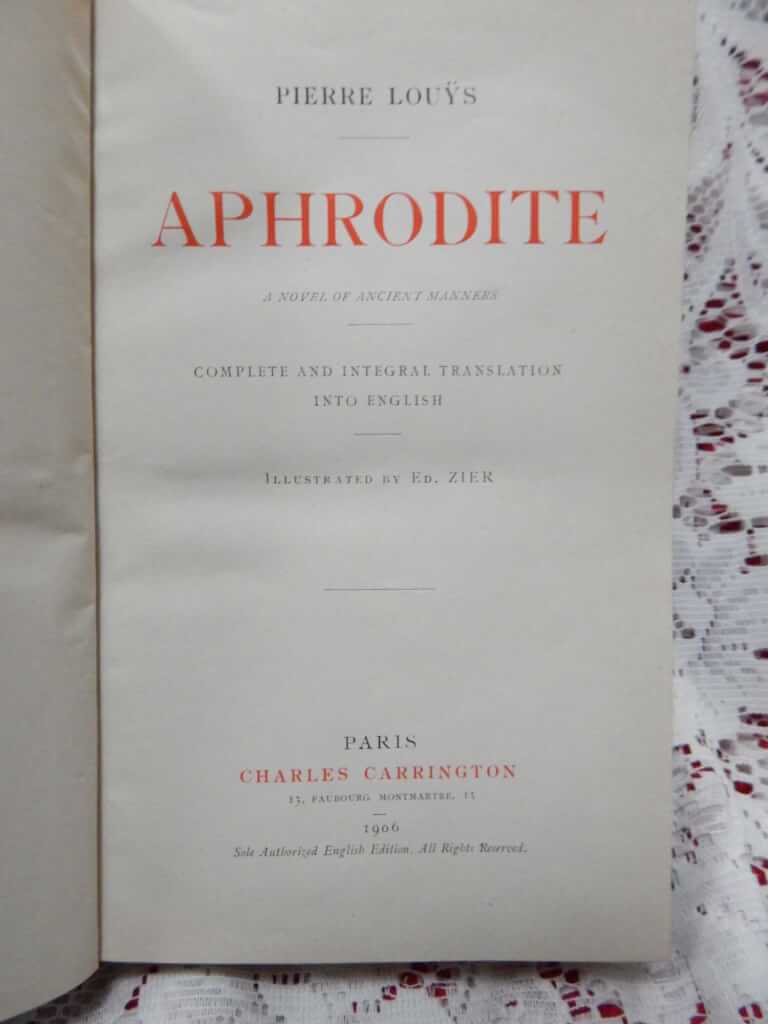
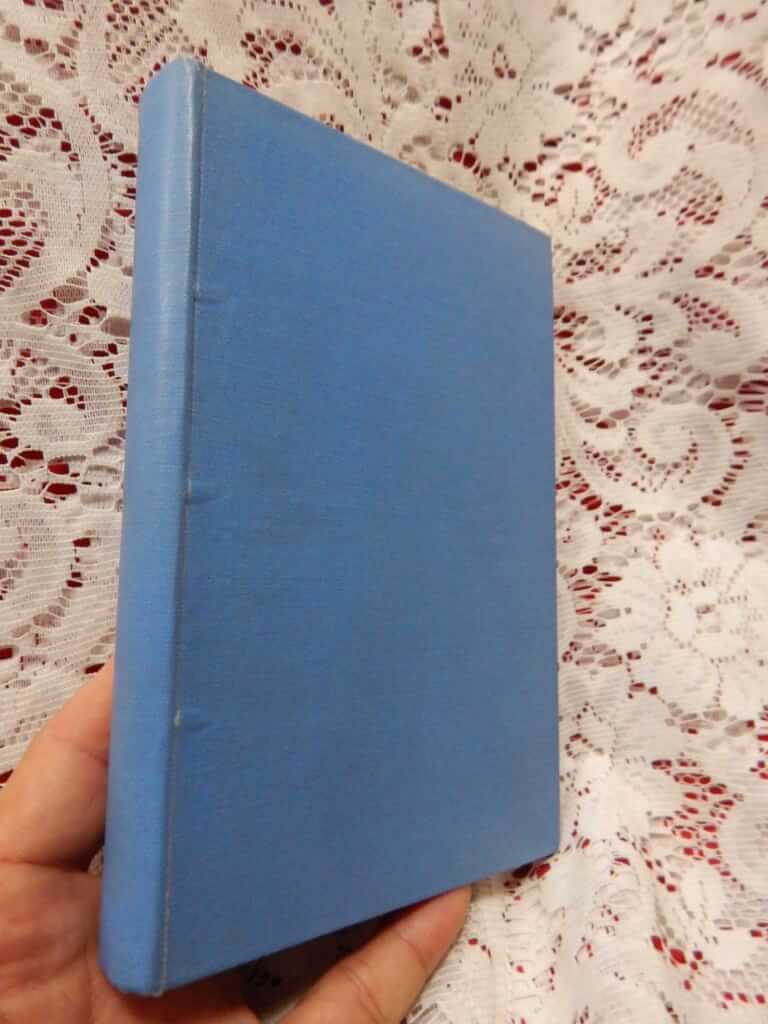 Aphrodite, a novel of ancient manners, by Pierre Louÿs, illus. Ed. Zier (Charles Carrington, 1906, first edition thus, first English translation) 5.25 x 7.75", xiv+412pp, rebound with plain blue boards, fine condition Pierre Louys (1870 - 1925) was a French poet and writer, most renowned for lesbian and classical themes in some of his writings. He is known as a writer who "expressed pagan sensuality with stylistic perfection." "Aphrodite: mæurs antiques" (Ancient Manners) is a "libertine" story set in ancient Alexandria. Highlights include the loves of Chrysis, an orgy banquet ending in the crucifixion of a slave, the love of two young musician girls and the festivals of Aphrodite. "This Translation of Aphrodite was executed on the Printing Presses of Charles Herissey, at Evreux (France), for Mr. Charles Carrington, Paris, Bookseller et Publisher, and is the only complete English version extant." Édouard François Zier (1856-1924) was a French illustrator and painter.
Aphrodite, a novel of ancient manners, by Pierre Louÿs, illus. Ed. Zier (Charles Carrington, 1906, first edition thus, first English translation) 5.25 x 7.75", xiv+412pp, rebound with plain blue boards, fine condition Pierre Louys (1870 - 1925) was a French poet and writer, most renowned for lesbian and classical themes in some of his writings. He is known as a writer who "expressed pagan sensuality with stylistic perfection." "Aphrodite: mæurs antiques" (Ancient Manners) is a "libertine" story set in ancient Alexandria. Highlights include the loves of Chrysis, an orgy banquet ending in the crucifixion of a slave, the love of two young musician girls and the festivals of Aphrodite. "This Translation of Aphrodite was executed on the Printing Presses of Charles Herissey, at Evreux (France), for Mr. Charles Carrington, Paris, Bookseller et Publisher, and is the only complete English version extant." Édouard François Zier (1856-1924) was a French illustrator and painter. -
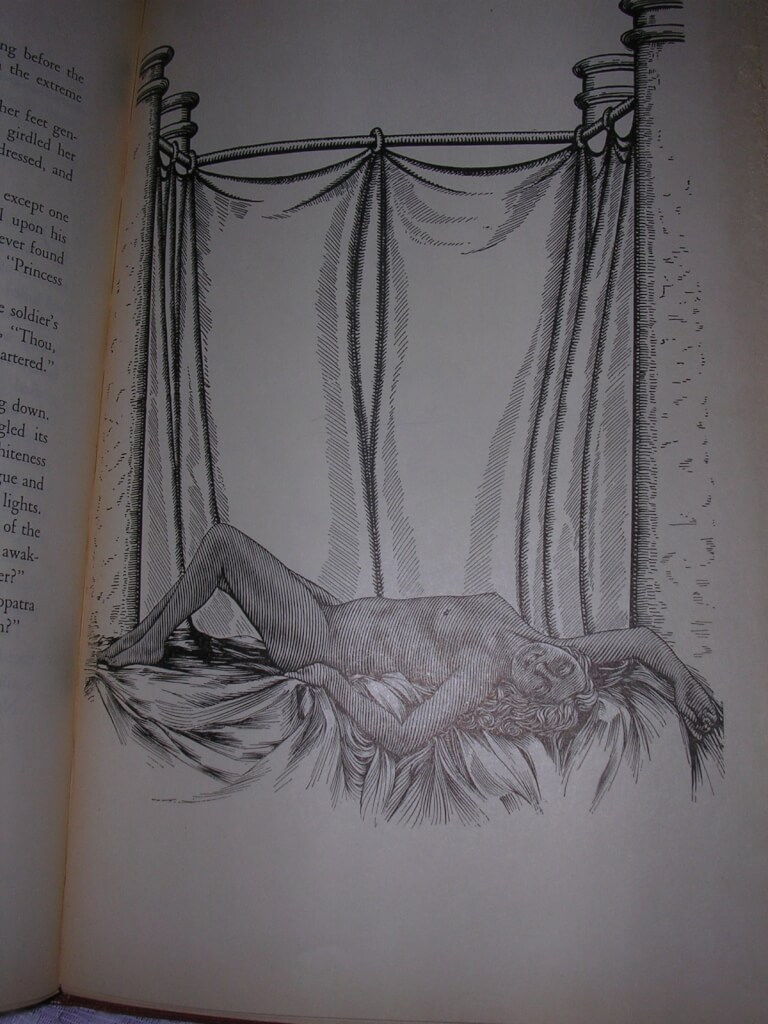
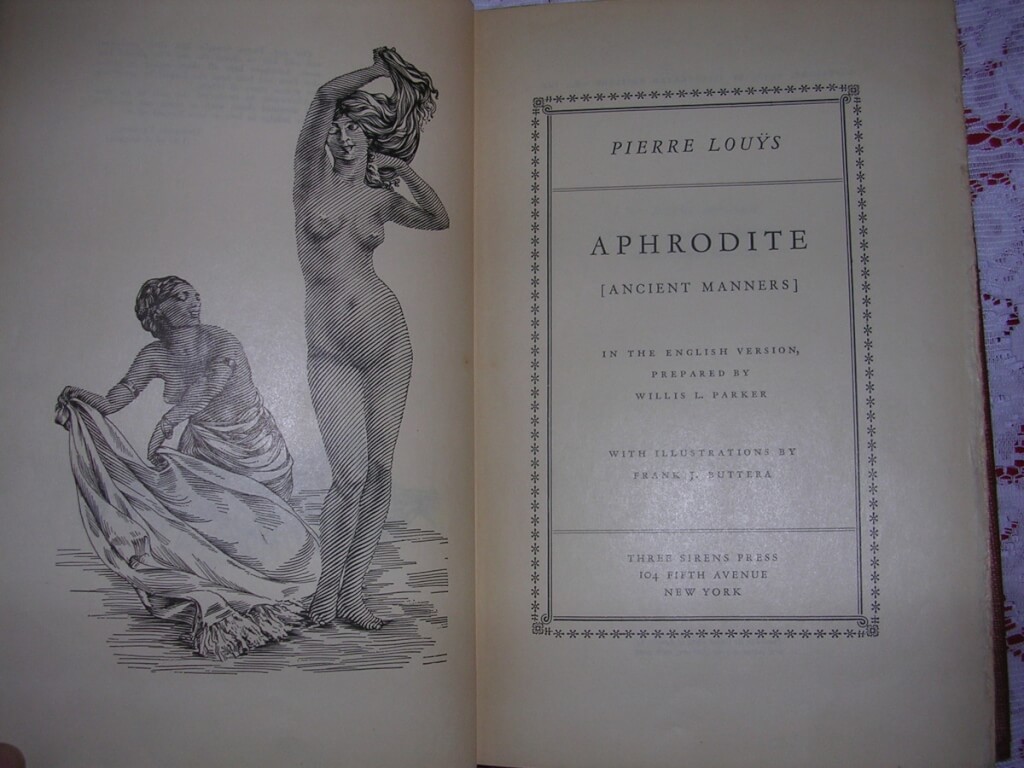 Aphrodite (Ancient Manners), Pierre Louys, trans. Willis L. Parker, illustrator Frank J. Buttera (Three Sirens Press, New York, 1932) 9 1/2" X 6 1/4", 251pp, hardbound no DJ, red cloth over boards with gilt decorations, deckle fore and bottom edge, inked top edge, very good condition, minor bumping to corners Pierre Louys (1870 - 1925) was a French poet and writer, most renowned for lesbian and classical themes in some of his writings. He is known as a writer who "expressed pagan sensuality with stylistic perfection." "Aphrodite: mæurs antiques" (Ancient Manners) is a "libertine" story set in ancient Alexandria. Highlights include the loves of Chrysis, an orgy banquet ending in the crucifixion of a slave, the love of two young musician girls and the festivals of Aphrodite. This edition is illustrated by Frank J. Buttera
Aphrodite (Ancient Manners), Pierre Louys, trans. Willis L. Parker, illustrator Frank J. Buttera (Three Sirens Press, New York, 1932) 9 1/2" X 6 1/4", 251pp, hardbound no DJ, red cloth over boards with gilt decorations, deckle fore and bottom edge, inked top edge, very good condition, minor bumping to corners Pierre Louys (1870 - 1925) was a French poet and writer, most renowned for lesbian and classical themes in some of his writings. He is known as a writer who "expressed pagan sensuality with stylistic perfection." "Aphrodite: mæurs antiques" (Ancient Manners) is a "libertine" story set in ancient Alexandria. Highlights include the loves of Chrysis, an orgy banquet ending in the crucifixion of a slave, the love of two young musician girls and the festivals of Aphrodite. This edition is illustrated by Frank J. Buttera -
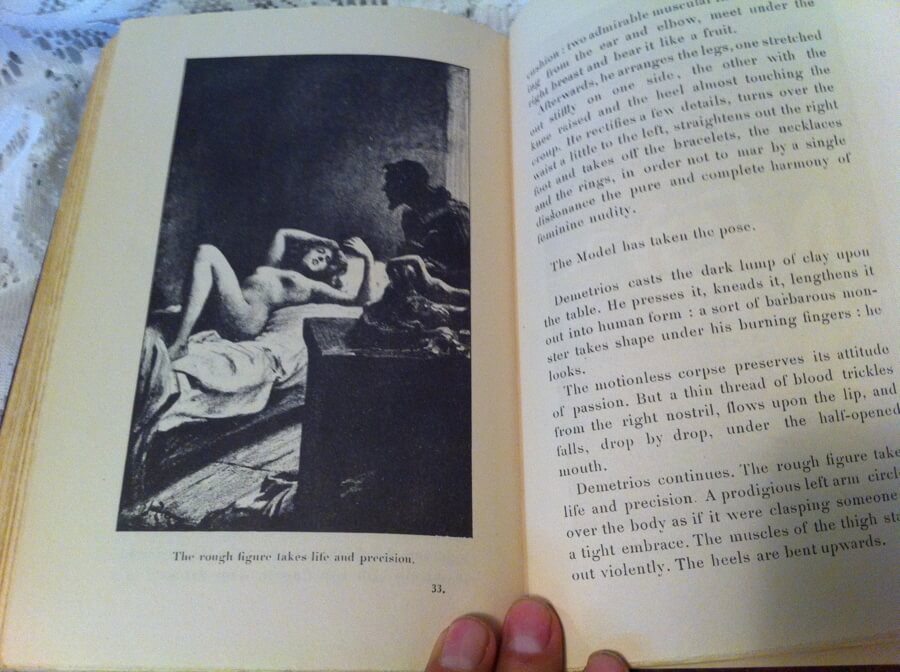
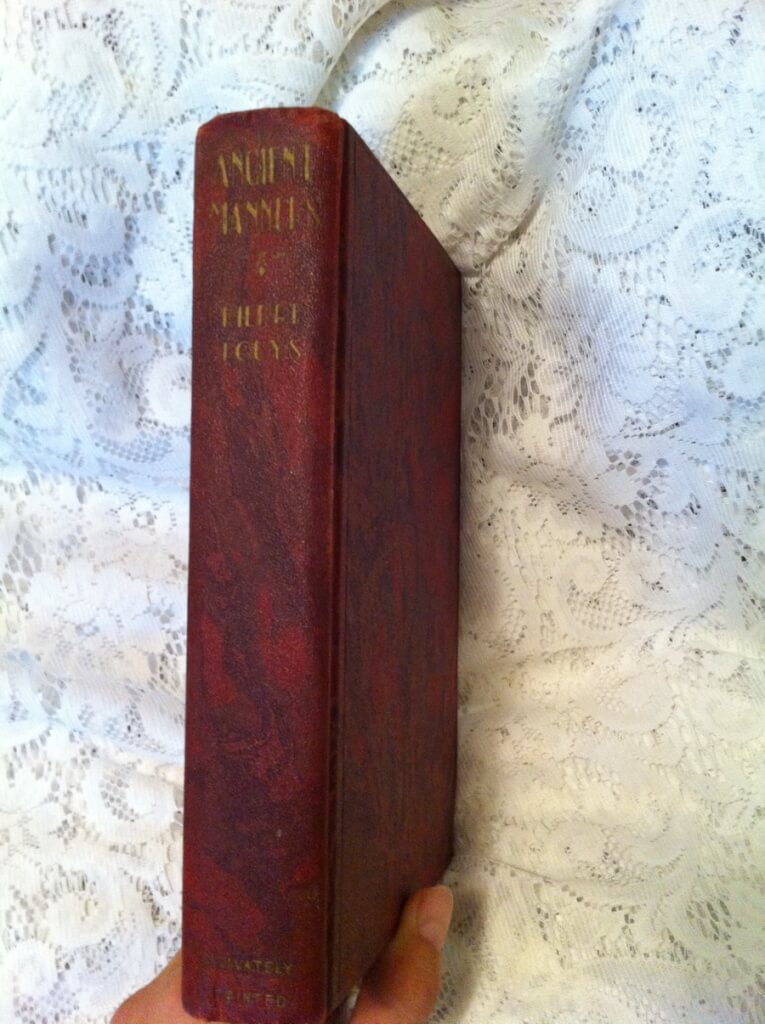 Ancient Manners, Pierre Louys (Privately printed for Subscribers only, Paris, nd. [c. 1920] ) 9.25" X 6", xvi 412pp, hardbound in marbled simulated leather cloth, edges deckled. Very good condition. Stated one of 1000, unnumbered. Owner's signature on front pastedown "E. D. York | Feb. 29, 1944." Pierre Louys (1870 - 1925) was a French poet and writer, most renowned for lesbian and classical themes in some of his writings. He is known as a writer who "expressed pagan sensuality with stylistic perfection." "Aphrodite: mæurs antiques" (Ancient Manners) is a "libertine" story set in ancient Alexandria. Highlights include the loves of Chrysis, an orgy banquet ending in the crucifixion of a slave, the love of two young musician girls and the festivals of Aphrodite. This edition states "This Translation of Ancient Manners was executed on the Printing Presses of Charles HERISSEY, at Evereux, (France), for Mr. Charles CARRINGTON, Paris, Bookseller et Publisher, and is the only complete English version extant." This is obviously a pirated copy of that edition.
Ancient Manners, Pierre Louys (Privately printed for Subscribers only, Paris, nd. [c. 1920] ) 9.25" X 6", xvi 412pp, hardbound in marbled simulated leather cloth, edges deckled. Very good condition. Stated one of 1000, unnumbered. Owner's signature on front pastedown "E. D. York | Feb. 29, 1944." Pierre Louys (1870 - 1925) was a French poet and writer, most renowned for lesbian and classical themes in some of his writings. He is known as a writer who "expressed pagan sensuality with stylistic perfection." "Aphrodite: mæurs antiques" (Ancient Manners) is a "libertine" story set in ancient Alexandria. Highlights include the loves of Chrysis, an orgy banquet ending in the crucifixion of a slave, the love of two young musician girls and the festivals of Aphrodite. This edition states "This Translation of Ancient Manners was executed on the Printing Presses of Charles HERISSEY, at Evereux, (France), for Mr. Charles CARRINGTON, Paris, Bookseller et Publisher, and is the only complete English version extant." This is obviously a pirated copy of that edition. -
Out of stock
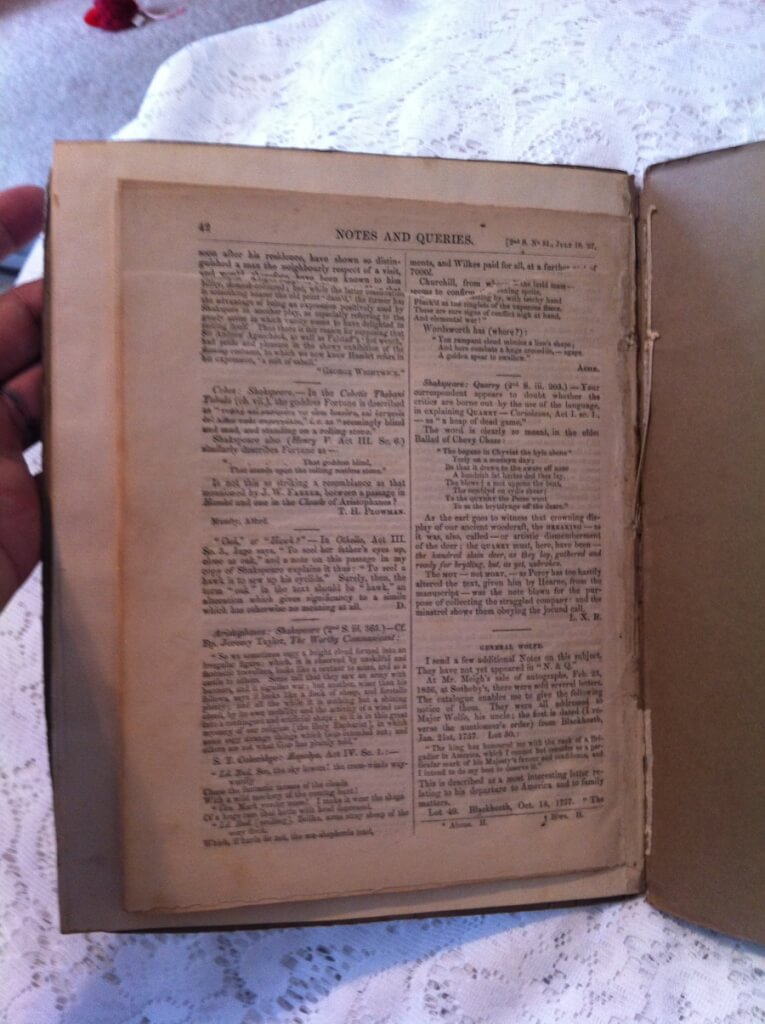
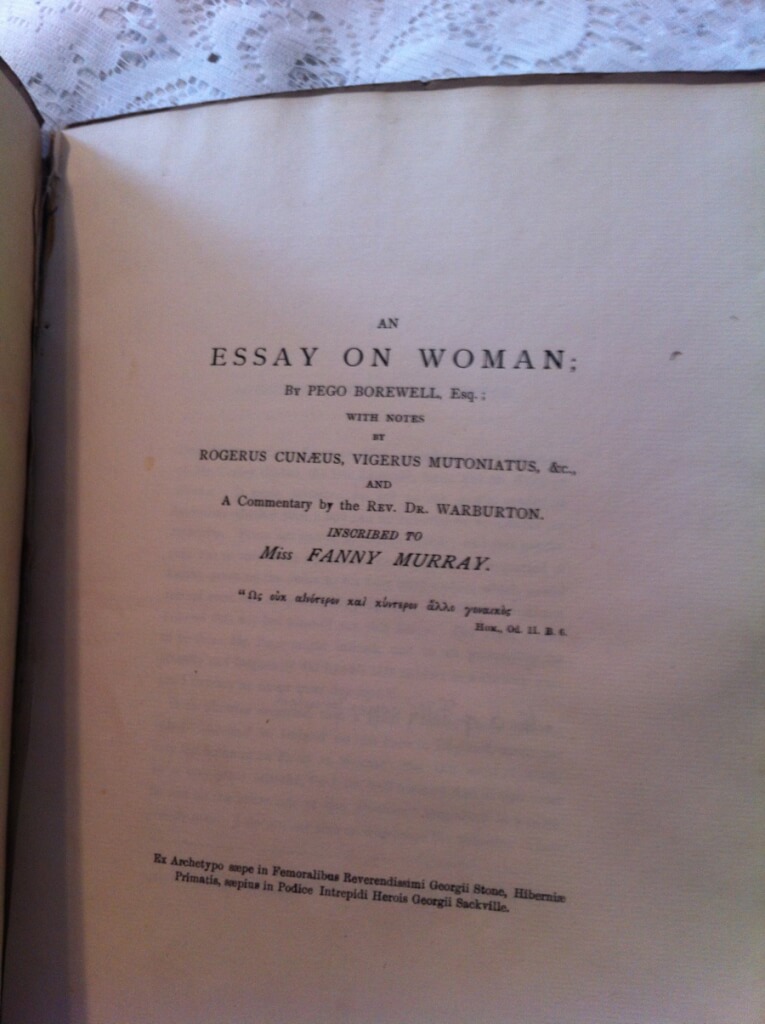 An Essay on Woman, by Pego Borewell, Esq., "with notes by Rogerus Cuneaus, Vigerus Mutoniatus, & Co. and A Commentary by the Rev. Dr. Warburton, inscribed to Miss Fanny Murray (np, bibliography on last page dated 1883) 7.5" X 9.75", 24pp., original soft wraps appear to be enclosed in brown wrap, appear to be two pages cut out before the title page, articles from "Notes and Queries" (dating July 11, 1857 and July 18, 1857) pasted into back of the book, followed by notes on legal paper from previous owner presumably trying to verify this edition Sometime in 1755, John Wilkes, together with fellow rake and son of the Archbishop of Cantebury, Thomas Potter (c. 1718-1759), composed a bawdy set of parodied Alexander Pope poems entitled An Essay on Woman, a satirical imitation of Pope's An Essay on Man. In 1763 he was put in jail for political reasons ("seditious libel for his anti-Jacobite smearing which appeared in his 'radical' weekly publication"). Upon release, his home was unlawfully searched and proofs of his "Essay on Woman" was discovered. This is an unknown reprint, as no original is known. I am still researching.
An Essay on Woman, by Pego Borewell, Esq., "with notes by Rogerus Cuneaus, Vigerus Mutoniatus, & Co. and A Commentary by the Rev. Dr. Warburton, inscribed to Miss Fanny Murray (np, bibliography on last page dated 1883) 7.5" X 9.75", 24pp., original soft wraps appear to be enclosed in brown wrap, appear to be two pages cut out before the title page, articles from "Notes and Queries" (dating July 11, 1857 and July 18, 1857) pasted into back of the book, followed by notes on legal paper from previous owner presumably trying to verify this edition Sometime in 1755, John Wilkes, together with fellow rake and son of the Archbishop of Cantebury, Thomas Potter (c. 1718-1759), composed a bawdy set of parodied Alexander Pope poems entitled An Essay on Woman, a satirical imitation of Pope's An Essay on Man. In 1763 he was put in jail for political reasons ("seditious libel for his anti-Jacobite smearing which appeared in his 'radical' weekly publication"). Upon release, his home was unlawfully searched and proofs of his "Essay on Woman" was discovered. This is an unknown reprint, as no original is known. I am still researching. -

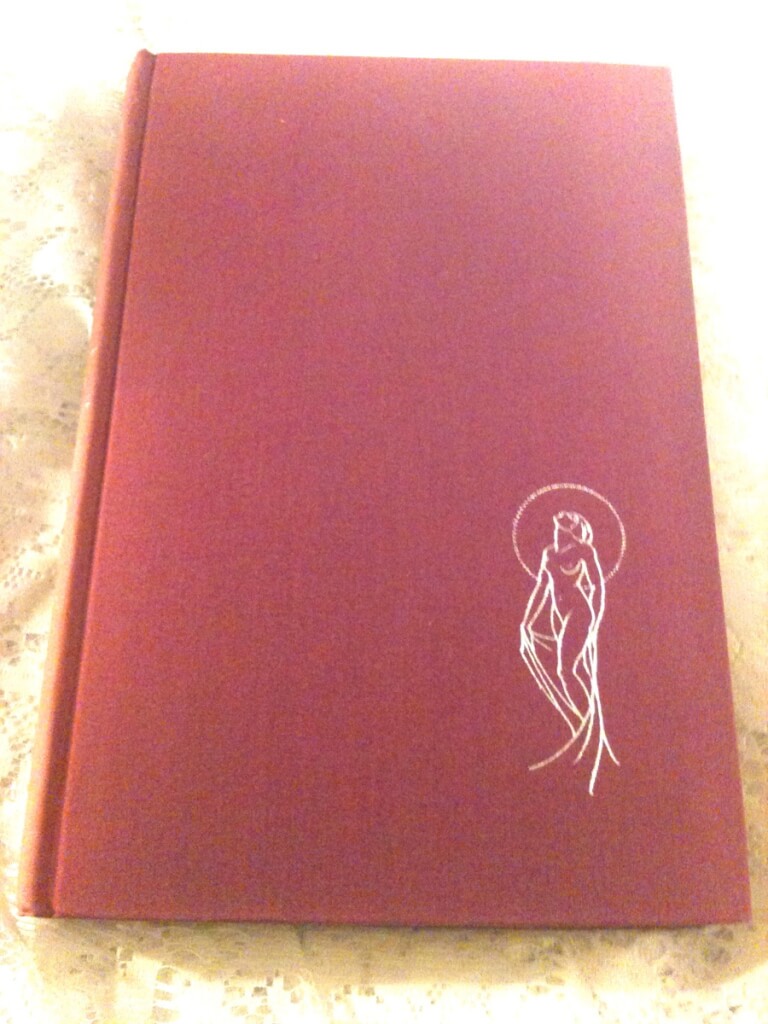 Amorous Fiammetta, Giovanni Boccaccio, introduction by Edward Hutton, trans. & illus. various unknown. (Rarity Press, New York, 1931 ) 9.5" X 6.5", 356pp, Hardcover no DJ, red cloth boards, botton and fore edges deckled. Good condition for age, a fading on spine, silver gilt lettering and decorations Originally titled "Elegia di Madonna Fiammetta" (The Elegy of Lady Fiammetta), this marvelous European romance was written by Giovanni Boccaccio somewhere between 1343 and 1344. It is a first-person confessional monologue narrated by a woman and is considered the first psychological novel in a modern language and a precursor of stream-of-consciousness fiction. Lady Fiammetta, recounts how, although a married woman, she falls in love with a handsome young foreigner named Panfilo and, becomes his lover. Panfilo subsequently abandons Fiammetta and returns to his native land, where his father is said to be dying. When he fails to keep his promise to return, Fiammetta, describes her longings, her anguish, and her despair. A host of contradictory sentiments drive her to desperation and to an unsuccessful suicide attempt. After a time, Fiammetta resumes her futile wait for Panfilo. She finally resolves to seek him out in his native land. Disguising her true intent from her husband, she secures his promise to help her in this undertaking. Addressing an exclusively female audience, Fiammetta warns them about the vicious ways of men. Her whole narrative adds up to an indictment of men as both readers and lovers. Fiammetta has been variously described as a pathetic victim of male cruelty; an irresponsible fool of a girl; a sophisticated, cunning, and wholly disingenuous female; and, finally, a genuinely modern woman. Whatever judgment we make of her, Fiammetta stands out among medieval women as an ardent and outspoken feminist. Sometime around 1330 Boccaccio fell in love and married his "Fiammetta" who most believe is Maria d'Aquino (?-1382), a royal bastard, an illegitimate daughter of Robert the Wise, King of Naples and Count of Provence. He wrote about her and their relationship in several of his literary works. She is traditionally identified as Fiammetta. According to him, Maria's mother was a Provençal noblewoman, Sibila Sabran, wife of Count Thomas IV of Aquino. She was born after Countess Sibila and King Robert committed adultery at his coronation festivities in 1310, but was given the family name of her mother's husband. Her putative father placed her in a convent. In 1345 she was an accomplice in the murder of King Andrew, the husband of her niece and Robert's successor, Queen Joanna I. For this Maria was sentenced to death and beheaded in 1382 on the orders of Queen Joanna I's successor, King Charles III.
Amorous Fiammetta, Giovanni Boccaccio, introduction by Edward Hutton, trans. & illus. various unknown. (Rarity Press, New York, 1931 ) 9.5" X 6.5", 356pp, Hardcover no DJ, red cloth boards, botton and fore edges deckled. Good condition for age, a fading on spine, silver gilt lettering and decorations Originally titled "Elegia di Madonna Fiammetta" (The Elegy of Lady Fiammetta), this marvelous European romance was written by Giovanni Boccaccio somewhere between 1343 and 1344. It is a first-person confessional monologue narrated by a woman and is considered the first psychological novel in a modern language and a precursor of stream-of-consciousness fiction. Lady Fiammetta, recounts how, although a married woman, she falls in love with a handsome young foreigner named Panfilo and, becomes his lover. Panfilo subsequently abandons Fiammetta and returns to his native land, where his father is said to be dying. When he fails to keep his promise to return, Fiammetta, describes her longings, her anguish, and her despair. A host of contradictory sentiments drive her to desperation and to an unsuccessful suicide attempt. After a time, Fiammetta resumes her futile wait for Panfilo. She finally resolves to seek him out in his native land. Disguising her true intent from her husband, she secures his promise to help her in this undertaking. Addressing an exclusively female audience, Fiammetta warns them about the vicious ways of men. Her whole narrative adds up to an indictment of men as both readers and lovers. Fiammetta has been variously described as a pathetic victim of male cruelty; an irresponsible fool of a girl; a sophisticated, cunning, and wholly disingenuous female; and, finally, a genuinely modern woman. Whatever judgment we make of her, Fiammetta stands out among medieval women as an ardent and outspoken feminist. Sometime around 1330 Boccaccio fell in love and married his "Fiammetta" who most believe is Maria d'Aquino (?-1382), a royal bastard, an illegitimate daughter of Robert the Wise, King of Naples and Count of Provence. He wrote about her and their relationship in several of his literary works. She is traditionally identified as Fiammetta. According to him, Maria's mother was a Provençal noblewoman, Sibila Sabran, wife of Count Thomas IV of Aquino. She was born after Countess Sibila and King Robert committed adultery at his coronation festivities in 1310, but was given the family name of her mother's husband. Her putative father placed her in a convent. In 1345 she was an accomplice in the murder of King Andrew, the husband of her niece and Robert's successor, Queen Joanna I. For this Maria was sentenced to death and beheaded in 1382 on the orders of Queen Joanna I's successor, King Charles III. -
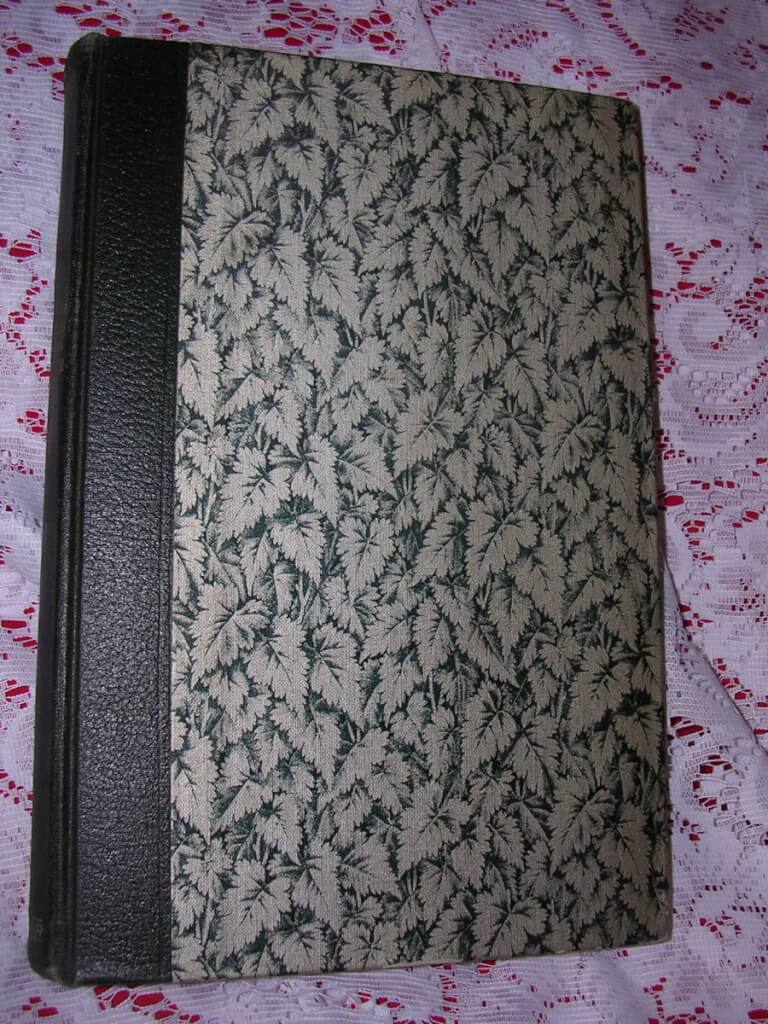
 Amatory Adventures of Sheik Mansour, A Master of the Art of Love, Hector France (Jul-Mar Press, 1932) 6 3/8 x 9 5/8", 249 pp, Stated, limited printing of 1000, but has no number. By Hector France, illustrated by Esaye Rabkin, this is a nice copy of this classic erotic novel. Book is a good used copy - cover is nice, has some rubbing to corners, overall age/use, as seen in the photo. Pages are all present and bound solid. Book has two 'Discarded' stamps, one at inside of the front cover, one at the title page. Has a damp stain along bottom margin of pages from front to page 19, small chip and tear at bottom of the title page. I see no other extraneous marks in this copy! Hector France (1837 - 1908) was a French author best known for his "orientalist" and flagellation tales. This is his risque tale of an Arab stud in action; a novel set around a Turkish harem. Translated by Alfred Allinson and reproduced from the Charles Carrington novel "The Chastisement of Mansour"
Amatory Adventures of Sheik Mansour, A Master of the Art of Love, Hector France (Jul-Mar Press, 1932) 6 3/8 x 9 5/8", 249 pp, Stated, limited printing of 1000, but has no number. By Hector France, illustrated by Esaye Rabkin, this is a nice copy of this classic erotic novel. Book is a good used copy - cover is nice, has some rubbing to corners, overall age/use, as seen in the photo. Pages are all present and bound solid. Book has two 'Discarded' stamps, one at inside of the front cover, one at the title page. Has a damp stain along bottom margin of pages from front to page 19, small chip and tear at bottom of the title page. I see no other extraneous marks in this copy! Hector France (1837 - 1908) was a French author best known for his "orientalist" and flagellation tales. This is his risque tale of an Arab stud in action; a novel set around a Turkish harem. Translated by Alfred Allinson and reproduced from the Charles Carrington novel "The Chastisement of Mansour" -
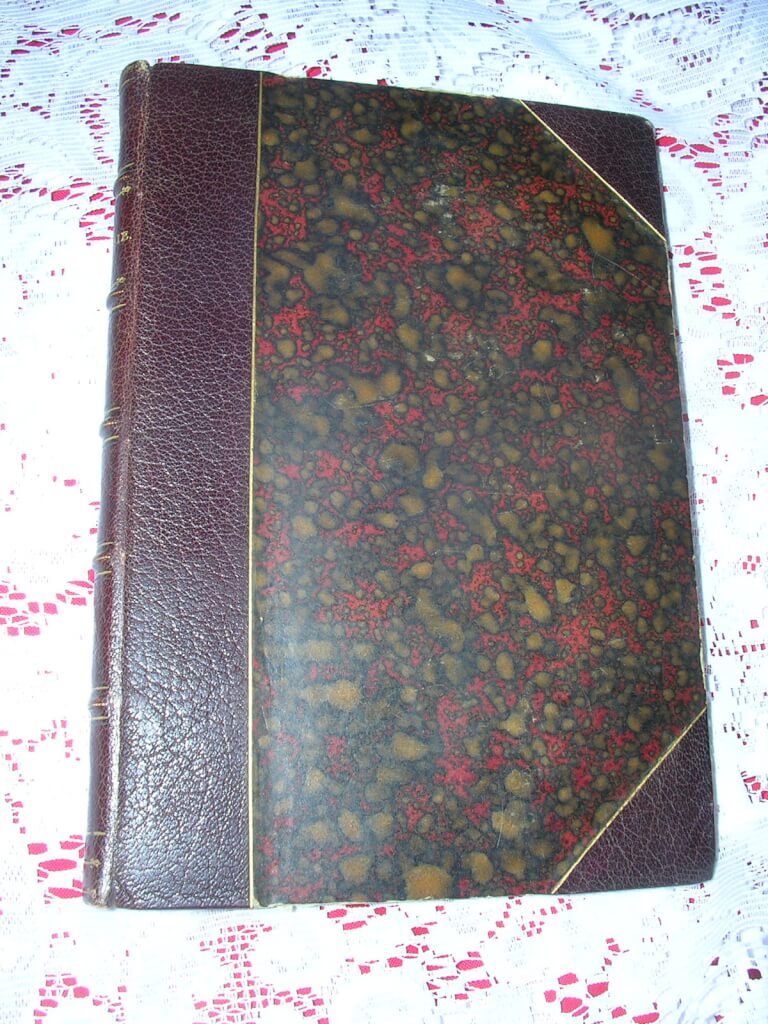
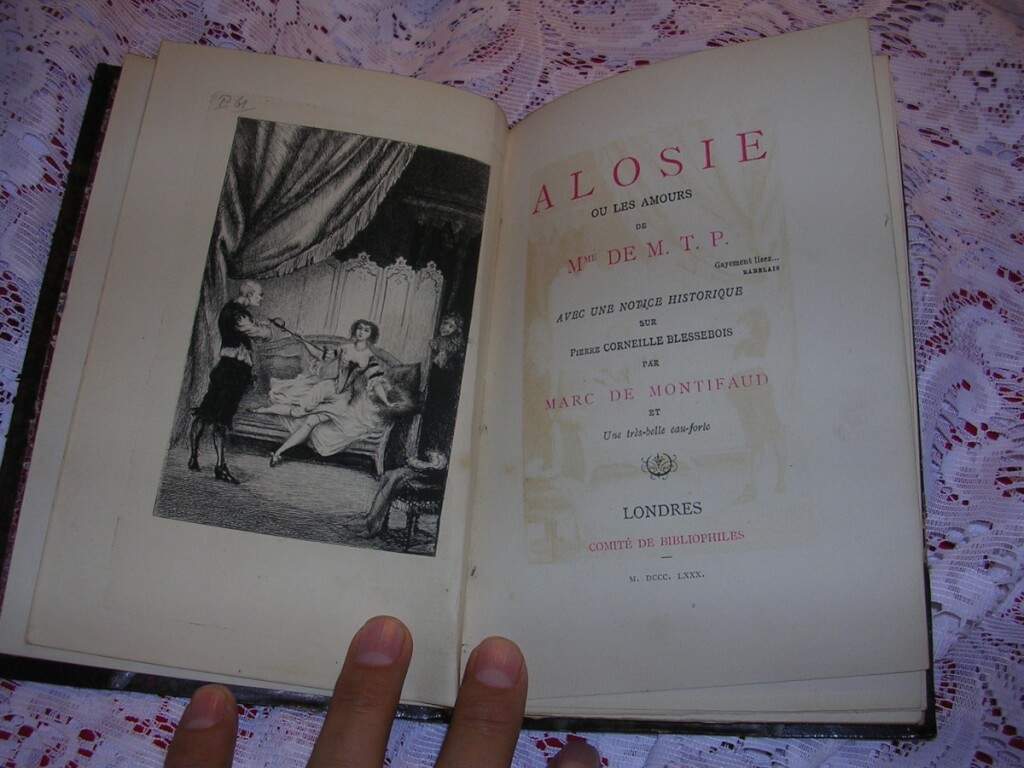 Alosie, ou Les Amours de Mme. de M. T. P. | Avec une notice historique sur Pierre Corneille Blessebois par Marc de Montifaud et Une très-belle eau-forte, Marc de Montifaud [pseud. Marie-Amélie Chartroule, Mme Quivogne de Montifaud] (Comité de Bibliophiles, London, 1880 [131/500 printed on Holland paper]) 7.5" x 5.25", 104pp, hardbound 1/2 leather, marbled boards and endpapers, gilt decorationson spine and leather corners, five raised bands on spine. Top edge gilt. Frontispiece engraving. #131 of 300 on Holland paper. Great condition for age. Initials "P.G." above frontispiece. Mme Quivogne de Montifaud (1845-50 to 1912/13) french writer and "free-thinker". She often dressed as her male pseudonym Marc de Montifaud. This book (published in London in 1880) is a reprint of part of the larger 17th century erotic work, "Amours des dames illustres de nostre siècle" (Loves of Illustrious Ladies of our Century) with an essay where Montifaud tries to unravel the authorship (usually the work is attributed to Pierre Corneille Blessebois). The author changes the original name to reflect that this is an autobiography of Madame de Montespan, the notorius mistress of Louis XIV. When originally published in Holland in 1878 (as "Lupanie, histoire amoureuse de ce temps") a court in Seine called it a moral outrage describing "licentious scenes on almost every page; told in a style revoltingly obscene". For publishing this book Montifaud was sentenced to 8 days in jail and fined 500 francs and ordered all copies of the book destroyed. The publisher was also fined 500 francs. This is a rare copy of a rare book in it's original "publishers leather".
Alosie, ou Les Amours de Mme. de M. T. P. | Avec une notice historique sur Pierre Corneille Blessebois par Marc de Montifaud et Une très-belle eau-forte, Marc de Montifaud [pseud. Marie-Amélie Chartroule, Mme Quivogne de Montifaud] (Comité de Bibliophiles, London, 1880 [131/500 printed on Holland paper]) 7.5" x 5.25", 104pp, hardbound 1/2 leather, marbled boards and endpapers, gilt decorationson spine and leather corners, five raised bands on spine. Top edge gilt. Frontispiece engraving. #131 of 300 on Holland paper. Great condition for age. Initials "P.G." above frontispiece. Mme Quivogne de Montifaud (1845-50 to 1912/13) french writer and "free-thinker". She often dressed as her male pseudonym Marc de Montifaud. This book (published in London in 1880) is a reprint of part of the larger 17th century erotic work, "Amours des dames illustres de nostre siècle" (Loves of Illustrious Ladies of our Century) with an essay where Montifaud tries to unravel the authorship (usually the work is attributed to Pierre Corneille Blessebois). The author changes the original name to reflect that this is an autobiography of Madame de Montespan, the notorius mistress of Louis XIV. When originally published in Holland in 1878 (as "Lupanie, histoire amoureuse de ce temps") a court in Seine called it a moral outrage describing "licentious scenes on almost every page; told in a style revoltingly obscene". For publishing this book Montifaud was sentenced to 8 days in jail and fined 500 francs and ordered all copies of the book destroyed. The publisher was also fined 500 francs. This is a rare copy of a rare book in it's original "publishers leather". -
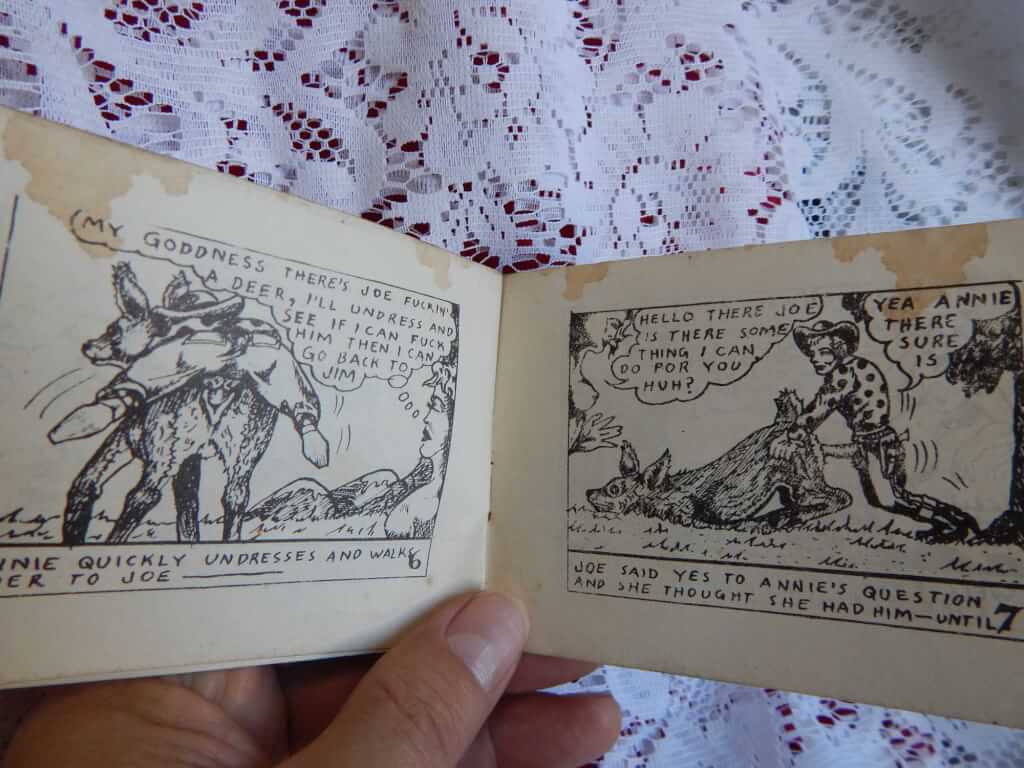
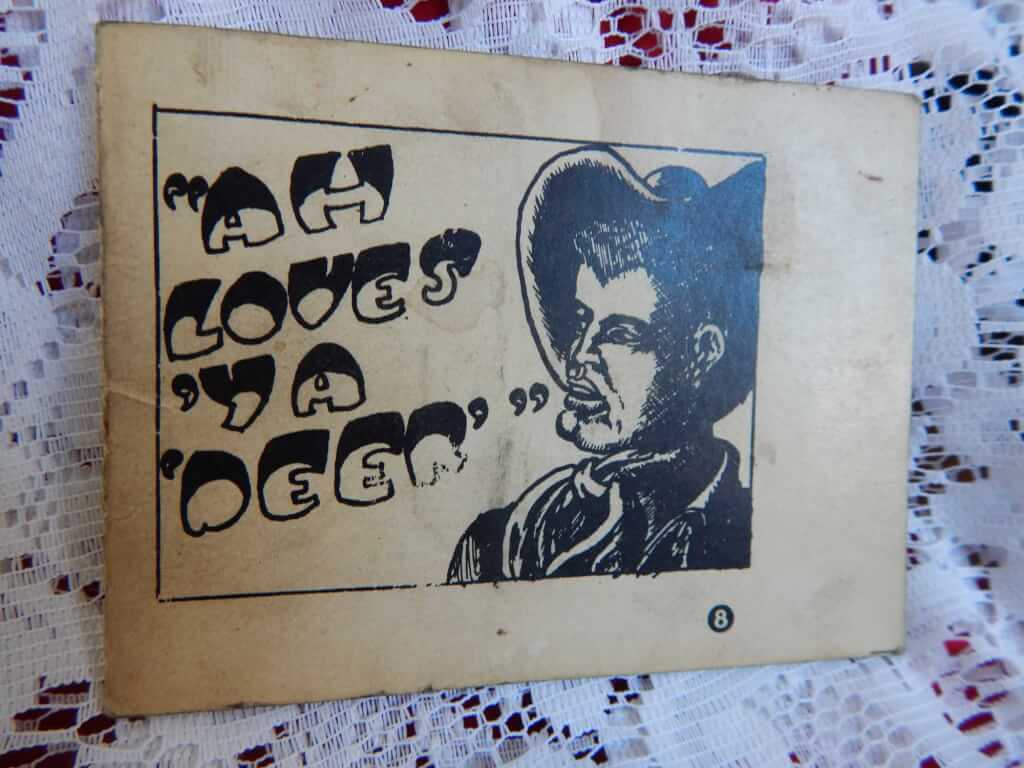 Ah Loves 'ya 'Deer'", (np. nd.) 4.5" x 3", 8pp., pamphlet, stapled and taped Tijuana bibles (also known as eight-pagers, bluesies, gray-backs, Jiggs-and-Maggie books, jo-jo books, Tillie-and-Mac books, and two-by-fours) were little pornographic comic books produced in the United States from the 1920s to the early 1960s.
Ah Loves 'ya 'Deer'", (np. nd.) 4.5" x 3", 8pp., pamphlet, stapled and taped Tijuana bibles (also known as eight-pagers, bluesies, gray-backs, Jiggs-and-Maggie books, jo-jo books, Tillie-and-Mac books, and two-by-fours) were little pornographic comic books produced in the United States from the 1920s to the early 1960s. -
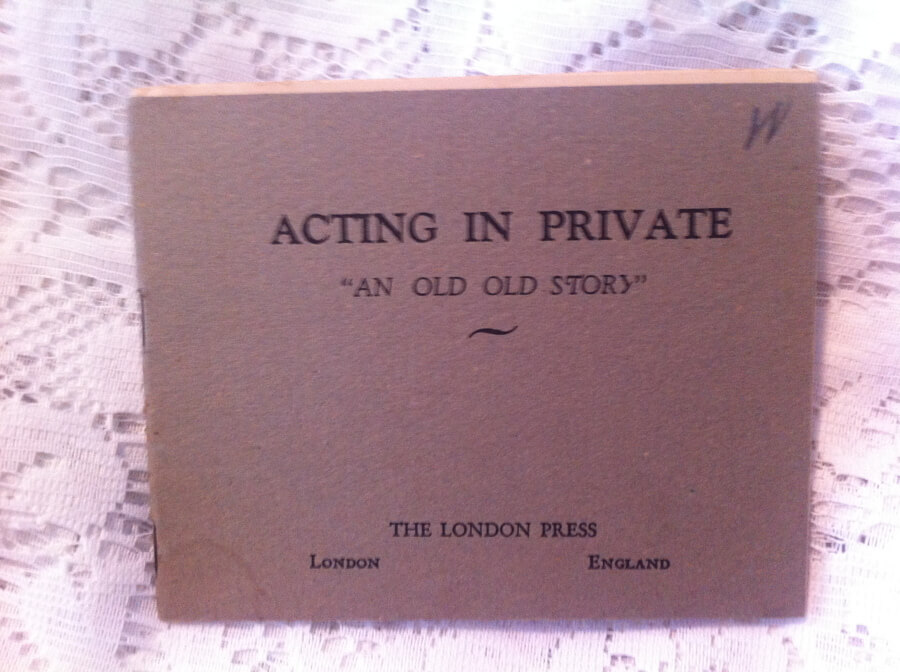
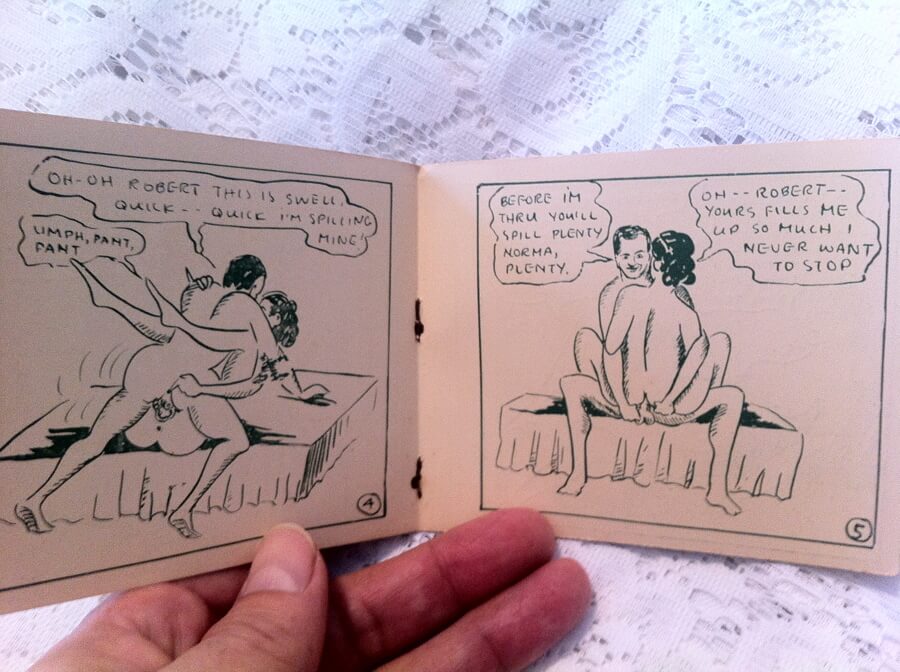 Acting in Private "An Old Old Story", (The London Press, London England, n.d.) 4.5" x 3.5", 8pp. pamphlet, stapled Tijuana bibles (also known as eight-pagers, bluesies, gray-backs, Jiggs-and-Maggie books, jo-jo books, Tillie-and-Mac books, and two-by-fours) were little pornographic comic books produced in the United States from the 1920s to the early 1960s.
Acting in Private "An Old Old Story", (The London Press, London England, n.d.) 4.5" x 3.5", 8pp. pamphlet, stapled Tijuana bibles (also known as eight-pagers, bluesies, gray-backs, Jiggs-and-Maggie books, jo-jo books, Tillie-and-Mac books, and two-by-fours) were little pornographic comic books produced in the United States from the 1920s to the early 1960s. -
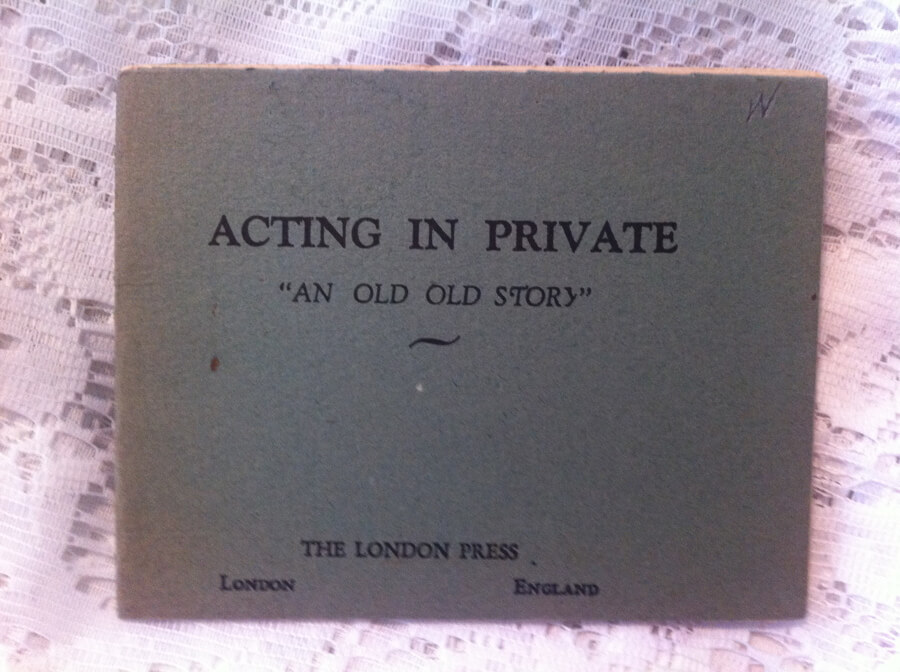
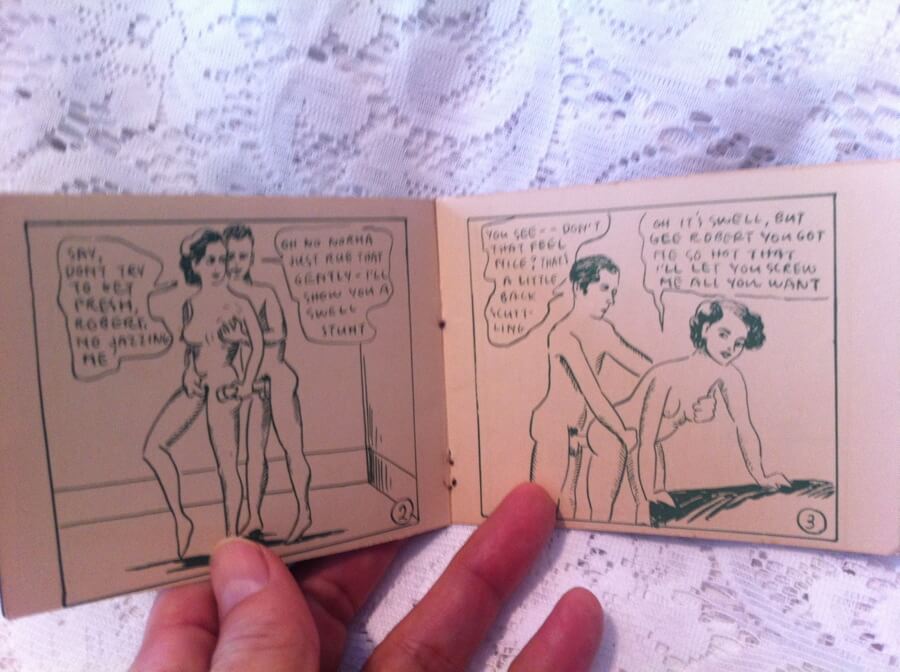 Acting in Private "An Old Old Story", (The London Press, London England, n.d.) 4.5" x 3.5", 8pp. pamphlet, stapled Tijuana bibles (also known as eight-pagers, bluesies, gray-backs, Jiggs-and-Maggie books, jo-jo books, Tillie-and-Mac books, and two-by-fours) were little pornographic comic books produced in the United States from the 1920s to the early 1960s.
Acting in Private "An Old Old Story", (The London Press, London England, n.d.) 4.5" x 3.5", 8pp. pamphlet, stapled Tijuana bibles (also known as eight-pagers, bluesies, gray-backs, Jiggs-and-Maggie books, jo-jo books, Tillie-and-Mac books, and two-by-fours) were little pornographic comic books produced in the United States from the 1920s to the early 1960s. -
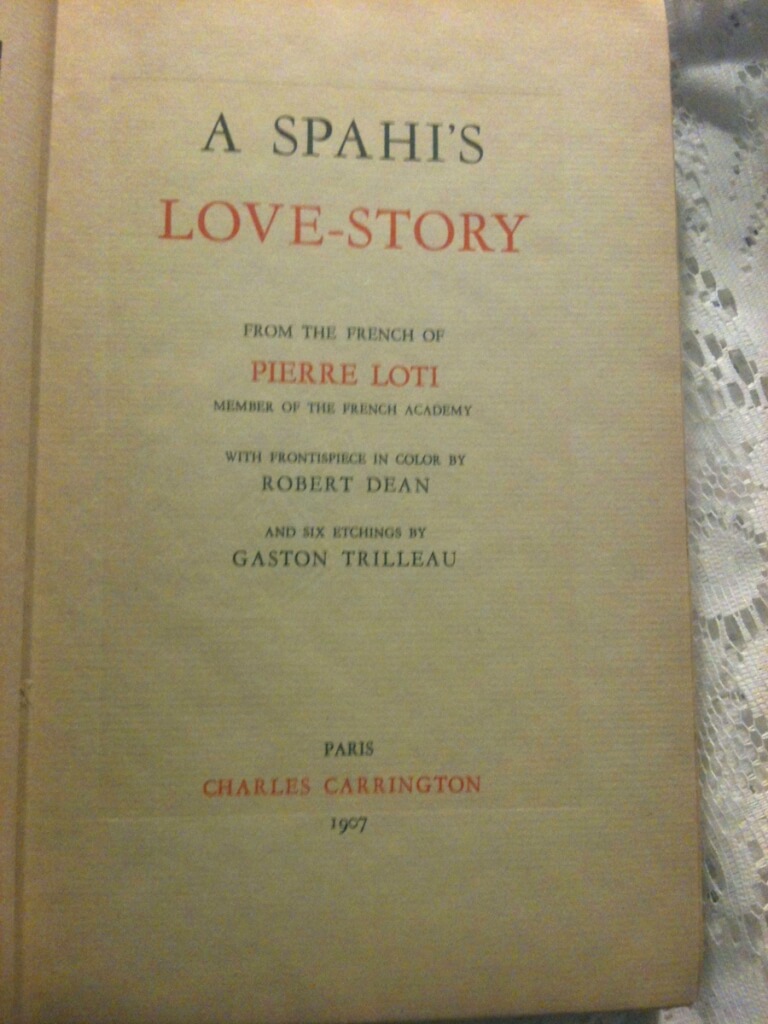
 A Spahi’s Love-Story, Pierre Loti [pseud. Julien Viaud], illus. Robert Dean, illus. Gaston Trilleau (Charles Carrington, Paris, 1907, #17/1000) 9″ x 5.75″, xii+330pp, hardbound, yellow cloth and batik design paper over boards, tipped-in color frontispiece, hand-made paper, deckled edges, good+ condition Julien Viaud (1850-1923) was a French novelist and naval officer. This his third novel (originally titled “Le Roman d’un Spahi”), was originally published in 1881. It recounts the tragic story in the dark middle ages of a Turkish soldier, who fell in love with a woman from a far away culture with a very different background. Color frontispiece by Robert Dean tipped in and six etchings by Gaston Trilleau throughout the book.
A Spahi’s Love-Story, Pierre Loti [pseud. Julien Viaud], illus. Robert Dean, illus. Gaston Trilleau (Charles Carrington, Paris, 1907, #17/1000) 9″ x 5.75″, xii+330pp, hardbound, yellow cloth and batik design paper over boards, tipped-in color frontispiece, hand-made paper, deckled edges, good+ condition Julien Viaud (1850-1923) was a French novelist and naval officer. This his third novel (originally titled “Le Roman d’un Spahi”), was originally published in 1881. It recounts the tragic story in the dark middle ages of a Turkish soldier, who fell in love with a woman from a far away culture with a very different background. Color frontispiece by Robert Dean tipped in and six etchings by Gaston Trilleau throughout the book. -
 "A Defence of Women for their Inconstancy & their Paintings made by Jack Donne & printed now with five decorations by Norman Lindsay" (Fanfrolico Press, London, 1925, #161/370) 7.5" X 5.5", unpaginated [12], brown cloth boards with gilt titles on spine, very good condition for age, slight bumping to corners. Woman’s Constancy” is one of John Donne’s many metaphysical poems of the 16th century. He writes this poem to a woman who he is or was in a relationship with. Despite the title, he talks about how inconsistent the woman’s love is and presents it in a series of questions. The poem describes a situation where a man has been loved by a woman for an entire day. However, he wonders if she will declare her love for another man the day after. He thinks that the woman’s logic is that the oath of love ends when one partner dies, and that since sleep resembles death, it is okay for the oath of love to be broken. For the woman to be true to herself, she must admit her false statements of love. The author thinks that he is more intelligent than her and states that he will not argue with her about her reasons for leaving him. However, Donne states that the following day he may feel the same way that she does. John Donne (1572 - 1631) was an English poet, scholar, soldier and secretary born into a recusant family, who later became a cleric in the Church of England. Under royal patronage, he was made Dean of St Paul's Cathedral in London (1621–1631). He is considered the preeminent representative of the metaphysical poets. His poetical works are noted for their metaphorical and sensual style and include sonnets, love poems, religious poems, Latin translations, epigrams, elegies, songs and satires. He is also known for his sermons. Donne's style is characterized by abrupt openings and various paradoxes, ironies and dislocations. These features, along with his frequent dramatic or everyday speech rhythms, his tense syntax and his tough eloquence, were both a reaction against the smoothness of conventional Elizabethan poetry and an adaptation into English of European baroque and mannerist techniques. His early career was marked by poetry that bore immense knowledge of English society. Another important theme in Donne's poetry is the idea of true religion, something that he spent much time considering and about which he often theorized. He wrote secular poems as well as erotic and love poems. He is particularly famous for his mastery of metaphysical conceits. Despite his great education and poetic talents, Donne lived in poverty for several years, relying heavily on wealthy friends. He spent much of the money he inherited during and after his education on womanising, literature, pastimes and travel. In 1601, Donne secretly married Anne More, with whom he had twelve children. In 1615 he was ordained Anglican deacon and then priest, although he did not want to take holy orders and only did so because the king ordered it. He also served as a member of Parliament in 1601 and in 1614. Fanfrolico Press, Australia’s first ‘private press’ in the arts-and-craft tradition, was founded by Jack Lindsay, P. R. Stephensen and John Kirtley, originally in North Sydney in 1923. The press specialized in printings artful, limited editions of classics and forgotten works that were suited to the extravagant style of artist like his father, artist, sculptor and author Norman Lindsay who illustrated many of their books. Fanfrolico was scornful of modernism and with its florid style determinedly backward-looking. They did surprisingly well, despite the lack of business expertise of their young, ambitious "bohemian" owners, eking out a living despite the risky move to London in 1926 and upheavals in ownership that saw the departure in 1927 of Kirtley, and then Stephenson in 1929. Sometime in 1930 they published their last book. Norman Alfred William Lindsay (1879-1969) was an Australian artist, etcher, sculptor, writer, editorial cartoonist, scale modeller, and an accomplished amateur boxer. Lindsay is widely regarded as one of Australia's greatest artists, producing a vast body of work in different media, including pen drawing, etching, watercolour, oil and sculptures in concrete and bronze. His frank and sumptuous nudes were highly controversial. In 1940, his wife took sixteen crates of paintings, drawings and etchings to the U.S. to protect them from the war. Unfortunately, they were discovered when the train they were on caught fire. The pieces were impounded and subsequently burned as pornography by American officials.
"A Defence of Women for their Inconstancy & their Paintings made by Jack Donne & printed now with five decorations by Norman Lindsay" (Fanfrolico Press, London, 1925, #161/370) 7.5" X 5.5", unpaginated [12], brown cloth boards with gilt titles on spine, very good condition for age, slight bumping to corners. Woman’s Constancy” is one of John Donne’s many metaphysical poems of the 16th century. He writes this poem to a woman who he is or was in a relationship with. Despite the title, he talks about how inconsistent the woman’s love is and presents it in a series of questions. The poem describes a situation where a man has been loved by a woman for an entire day. However, he wonders if she will declare her love for another man the day after. He thinks that the woman’s logic is that the oath of love ends when one partner dies, and that since sleep resembles death, it is okay for the oath of love to be broken. For the woman to be true to herself, she must admit her false statements of love. The author thinks that he is more intelligent than her and states that he will not argue with her about her reasons for leaving him. However, Donne states that the following day he may feel the same way that she does. John Donne (1572 - 1631) was an English poet, scholar, soldier and secretary born into a recusant family, who later became a cleric in the Church of England. Under royal patronage, he was made Dean of St Paul's Cathedral in London (1621–1631). He is considered the preeminent representative of the metaphysical poets. His poetical works are noted for their metaphorical and sensual style and include sonnets, love poems, religious poems, Latin translations, epigrams, elegies, songs and satires. He is also known for his sermons. Donne's style is characterized by abrupt openings and various paradoxes, ironies and dislocations. These features, along with his frequent dramatic or everyday speech rhythms, his tense syntax and his tough eloquence, were both a reaction against the smoothness of conventional Elizabethan poetry and an adaptation into English of European baroque and mannerist techniques. His early career was marked by poetry that bore immense knowledge of English society. Another important theme in Donne's poetry is the idea of true religion, something that he spent much time considering and about which he often theorized. He wrote secular poems as well as erotic and love poems. He is particularly famous for his mastery of metaphysical conceits. Despite his great education and poetic talents, Donne lived in poverty for several years, relying heavily on wealthy friends. He spent much of the money he inherited during and after his education on womanising, literature, pastimes and travel. In 1601, Donne secretly married Anne More, with whom he had twelve children. In 1615 he was ordained Anglican deacon and then priest, although he did not want to take holy orders and only did so because the king ordered it. He also served as a member of Parliament in 1601 and in 1614. Fanfrolico Press, Australia’s first ‘private press’ in the arts-and-craft tradition, was founded by Jack Lindsay, P. R. Stephensen and John Kirtley, originally in North Sydney in 1923. The press specialized in printings artful, limited editions of classics and forgotten works that were suited to the extravagant style of artist like his father, artist, sculptor and author Norman Lindsay who illustrated many of their books. Fanfrolico was scornful of modernism and with its florid style determinedly backward-looking. They did surprisingly well, despite the lack of business expertise of their young, ambitious "bohemian" owners, eking out a living despite the risky move to London in 1926 and upheavals in ownership that saw the departure in 1927 of Kirtley, and then Stephenson in 1929. Sometime in 1930 they published their last book. Norman Alfred William Lindsay (1879-1969) was an Australian artist, etcher, sculptor, writer, editorial cartoonist, scale modeller, and an accomplished amateur boxer. Lindsay is widely regarded as one of Australia's greatest artists, producing a vast body of work in different media, including pen drawing, etching, watercolour, oil and sculptures in concrete and bronze. His frank and sumptuous nudes were highly controversial. In 1940, his wife took sixteen crates of paintings, drawings and etchings to the U.S. to protect them from the war. Unfortunately, they were discovered when the train they were on caught fire. The pieces were impounded and subsequently burned as pornography by American officials. -
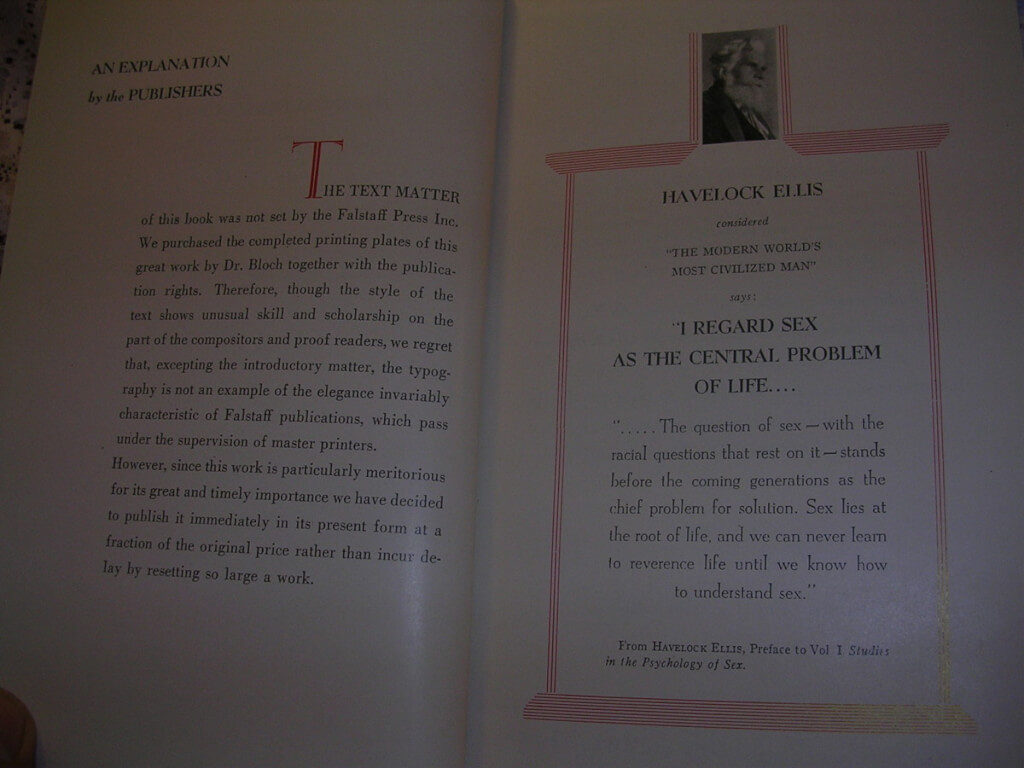
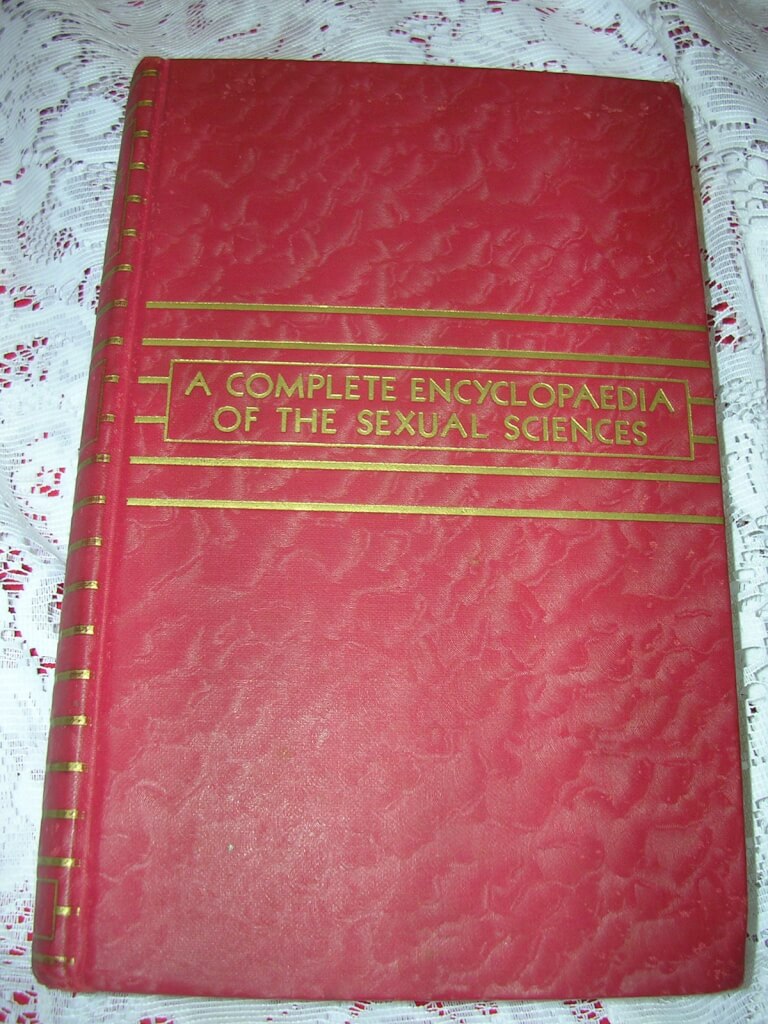 A Complete Encyclopaedia of the Sexual Sciences, Dr. Iwan Bloch, trans Dr. M. Eden Paul (Falstaff Press, New York, 1937) 8.75" X 5.75", xxx+790pp, hardbound, no DJ, decorative red cloth with gilt lettering and decorations. The 30 pages of the preface printed in black with red decorations (mostly praise of the book and the author by various people including Dr. Bloch). Good condition, corners bumped, some fading/spotting on cover and spine, binding very good. "The author's aim in writing this book was to write a complete Encyclopaedia on the sexual sciences, and it will probably be acknowledged by all who study its pages that the author has accomplished his intention in a very scholarly manner, and in such form as to be of great value to the professions for whom this translation is intended. The subject is no doubt one which appeals to and affects the interests of all adult persons, but the publishers have, after very serious and careful consideration, come to the conclusion that the sale of the English translation of the book shall be limited to members of the legal and medical professions." -from Publisher's Note
A Complete Encyclopaedia of the Sexual Sciences, Dr. Iwan Bloch, trans Dr. M. Eden Paul (Falstaff Press, New York, 1937) 8.75" X 5.75", xxx+790pp, hardbound, no DJ, decorative red cloth with gilt lettering and decorations. The 30 pages of the preface printed in black with red decorations (mostly praise of the book and the author by various people including Dr. Bloch). Good condition, corners bumped, some fading/spotting on cover and spine, binding very good. "The author's aim in writing this book was to write a complete Encyclopaedia on the sexual sciences, and it will probably be acknowledged by all who study its pages that the author has accomplished his intention in a very scholarly manner, and in such form as to be of great value to the professions for whom this translation is intended. The subject is no doubt one which appeals to and affects the interests of all adult persons, but the publishers have, after very serious and careful consideration, come to the conclusion that the sale of the English translation of the book shall be limited to members of the legal and medical professions." -from Publisher's Note -
 40 prints from “Liebe. Vierzig Zeichnungen”, Mihály Zichy (n.d. n.p. [1911-13]) 11.25″ X 13.5″, 40pp unnumbered, bound in half-morocco with gilt edges over red boards, gilt titles and decorations on spine, all 40 original plates are present and bound together in what appears to be a contemporary binding, good condition, some foxing throughout. Mihály Zichy (1827 – 1906) was a Hungarian painter and graphic artist. He is considered a notable representative of Hungarian romantic painting. He lived and worked primarily in St. Petersburg and Paris during his career. He is known for illustrating the Georgian epic poem The Knight in the Panther's Skin on an 1881 commission by the intelligentsia. By the time he had completed 35 pictures, he was so moved by the poem that he gave his works to the Georgian people as a gift. In 1911 40 héliogravures after Zichy’s erotic drawings were published as “Liebe. Vierzig Zeichnungen” [Love. 40 drawings]. The subjects were bold, provocative, and at times taboo. Only 300 copies were printed, only for subscribers. There was also a very rare limited printing in 1913 before the plates were destroyed. As far as I can tell these appear to be the prints taken from that one of those editions, and rebound here without the title page that accompanied the published work.
40 prints from “Liebe. Vierzig Zeichnungen”, Mihály Zichy (n.d. n.p. [1911-13]) 11.25″ X 13.5″, 40pp unnumbered, bound in half-morocco with gilt edges over red boards, gilt titles and decorations on spine, all 40 original plates are present and bound together in what appears to be a contemporary binding, good condition, some foxing throughout. Mihály Zichy (1827 – 1906) was a Hungarian painter and graphic artist. He is considered a notable representative of Hungarian romantic painting. He lived and worked primarily in St. Petersburg and Paris during his career. He is known for illustrating the Georgian epic poem The Knight in the Panther's Skin on an 1881 commission by the intelligentsia. By the time he had completed 35 pictures, he was so moved by the poem that he gave his works to the Georgian people as a gift. In 1911 40 héliogravures after Zichy’s erotic drawings were published as “Liebe. Vierzig Zeichnungen” [Love. 40 drawings]. The subjects were bold, provocative, and at times taboo. Only 300 copies were printed, only for subscribers. There was also a very rare limited printing in 1913 before the plates were destroyed. As far as I can tell these appear to be the prints taken from that one of those editions, and rebound here without the title page that accompanied the published work. -
Out of stock
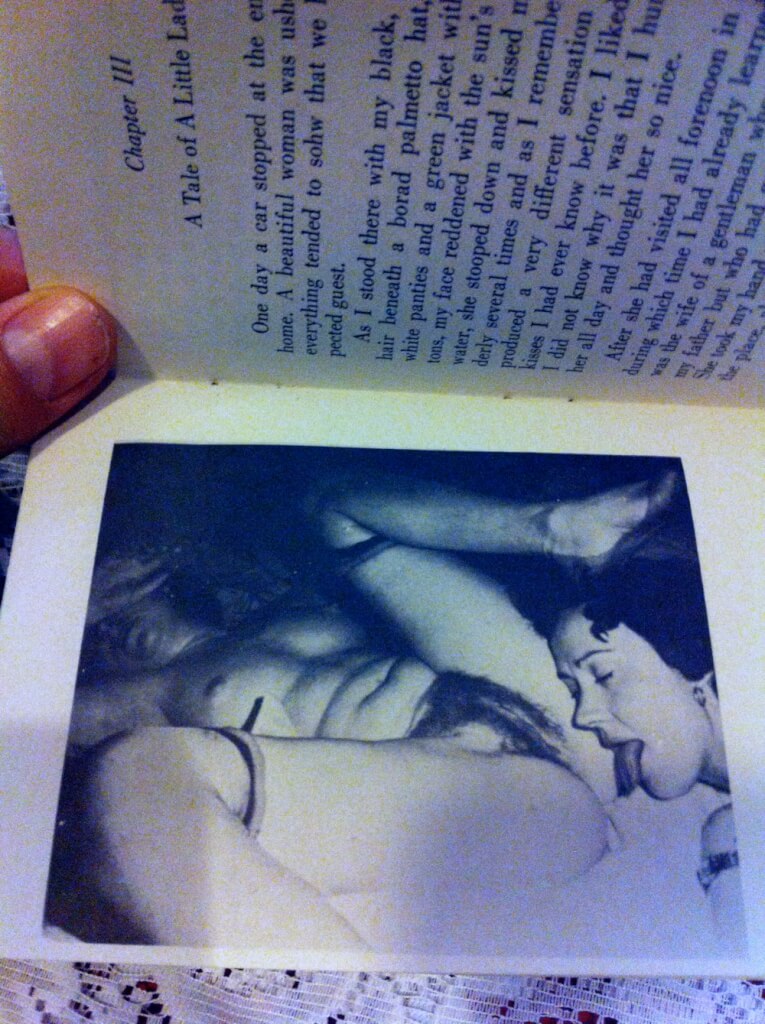
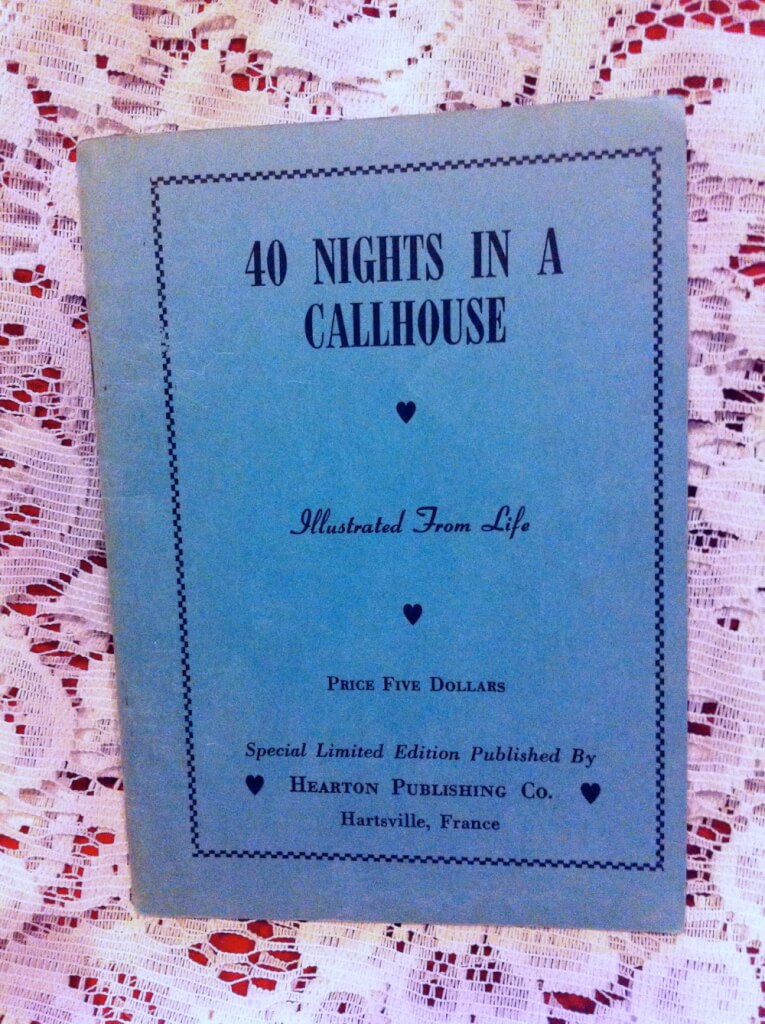 anonymous (Hearton Publishing Co., Hartsville, France, nd.) 5.5" X 4", 32pp, softcover, good quality for age, very pornographic photos, stated "Illustrated from Life"
anonymous (Hearton Publishing Co., Hartsville, France, nd.) 5.5" X 4", 32pp, softcover, good quality for age, very pornographic photos, stated "Illustrated from Life"












